The post 10 Hiking Trails Around the World That Will Blow Your Mind appeared first on The Expeditioner Travel Site.
]]>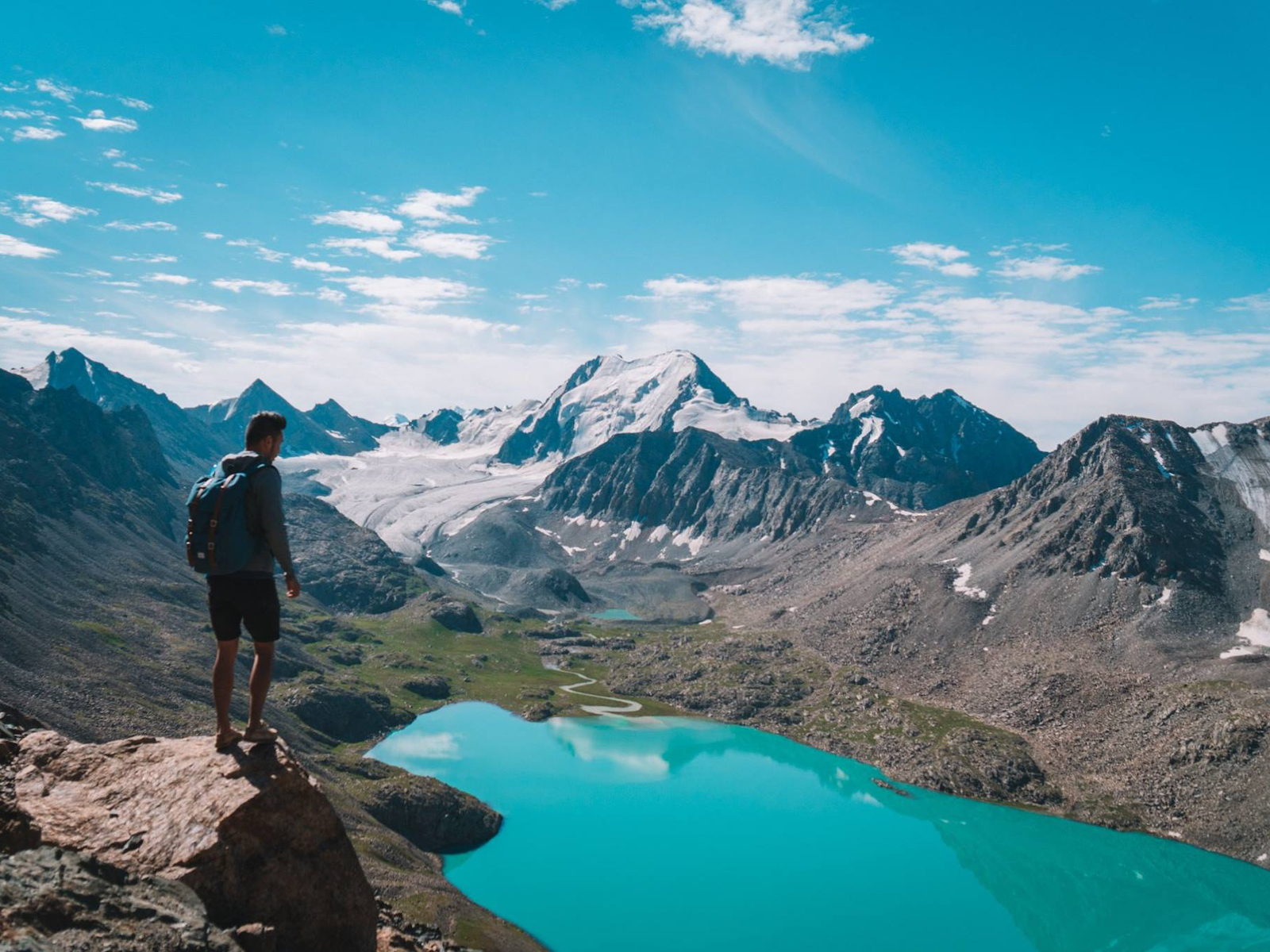
I have always been a nature person. Cities, for me, seem unnecessarily chaotic and at times, overwhelming. Nature, on the other hand, is simple, straightforward in its beauty and comes at no extra cost. There is nothing better than walking in the peacefulness of the mountains, around the calming sound of rocks and rivers, and having the front seat row to Mother Nature. Whenever I have a chance to disconnect from the world and go on a four-day trek in the mountain, I would do so with no hesitation.
I first discovered my love for hiking in 2014 in Nepal, when I decided to go hike the Annapurna Base Camp trail alone with no porter or guide. It was a huge endeavor for me since I never had any previous hiking experience and I never thought of myself as “outdoorsy”. Everything changed after that and now, I tremble with excitement every time I see a trail I could hike into the heart of the mountains.
After 6 years of traveling around the world from Peru to New Zealand, I have compiled a list of my top 10 hiking experience from around the world. The trails lengths range from 6 hours to 7 days, 1,000 meters to 4,700 meters high, and from a stroll to me dragging my feet to the top. Without further ado, let’s begin with my first trek ever.
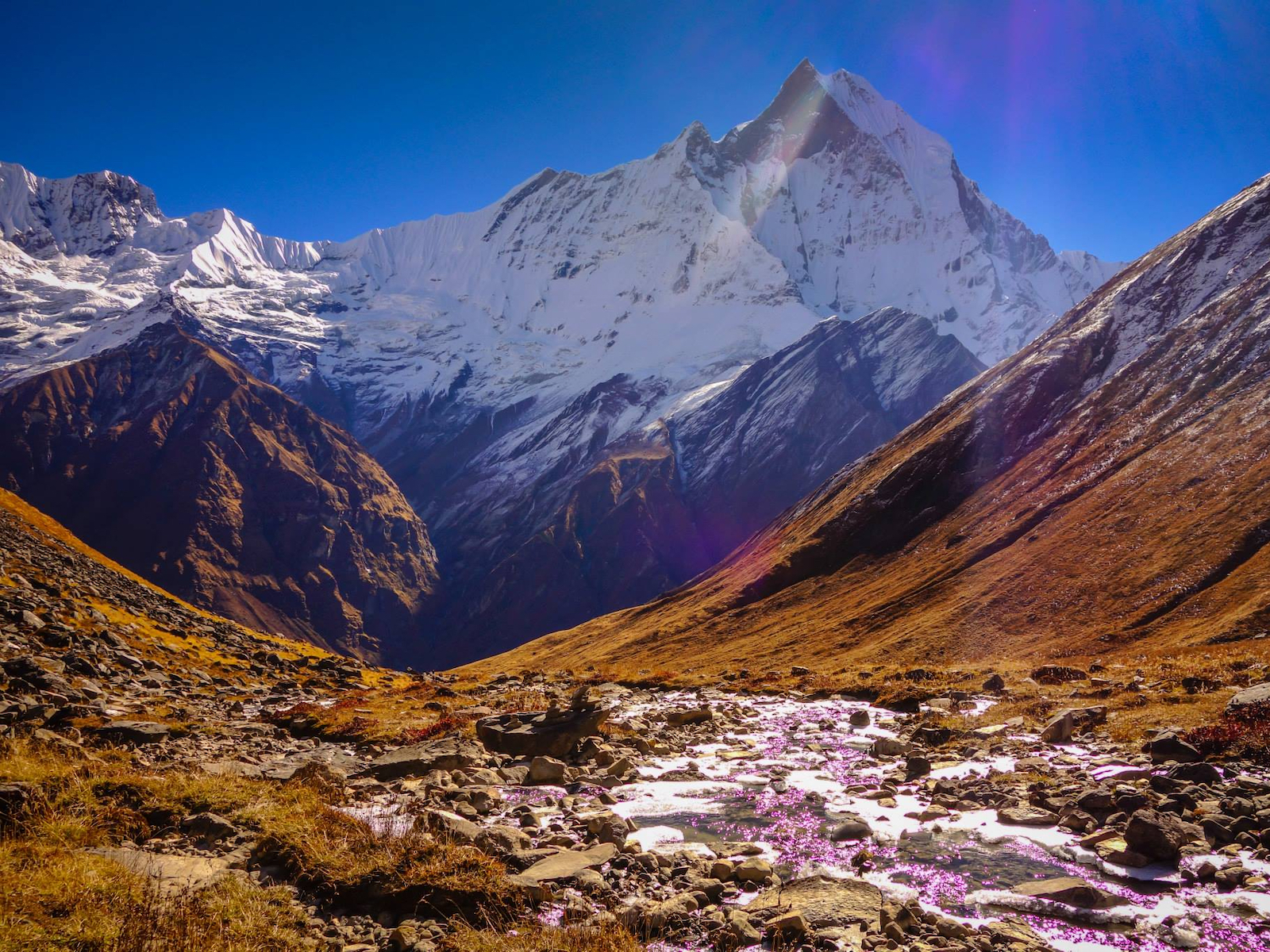
1) Annapurna Base Camp Trek (Nepal)
Location: Pokhara, Nepal
Length: 7 – 10 days return
Highest Altitude: 14,107 feet
Distance: ~75 miles
Difficulty: Moderate
This was my first hike ever and it is still my favorite and most memorable out of all. The trail begins in the beautiful city by the lake with a view of the Himalayas, Pokhara. The trail is considered to be one of the most diverse in Nepal, even more so than the Everest Base Camp trail. You start walking through a lush green forest, going up and down valleys, crossing several massive suspension bridges and through the bamboo forest. Pace yourself past the avalanche-prone valley and eventually you will be surrounded by several 26,000-foot-high peaks of the Himalayas.
Nothing will make you feel accomplished and humbled at the same time as conquering the Annapurna Base Camp trail and still being towered by not one but several higher ones. It’s even more intimidating to know that one of the mountains surrounding you at the base camp, the Annapurna, is one of the least climbed and the deadliest out of all the 26,000-foot peaks with the highest fatality rate at 40.8%. That feeling of accomplishment will be with you for several months to come after.

2) Ala Kul Trek (Kyrgyzstan)
Location: Karakol, Kyrgyzstan
Length: 2 – 4 days return
Highest Altitude: 11,600 feet
Distance: ~33 miles
Difficulty: Moderate
For such a small off-the-beaten-path country, Kyrgyzstan has a lot to offer for nature lovers with stunning canyons, pristine alpine lakes and plenty of hiking trails, all tucked away in the unexplored mountain range of Central Asia. One of that trail is the Ala Kul trail, a two to four-day hike that starts from the city of Karakol. This route will take you through one of the most stunning forests rich with vegetation and wildlife, then you get to camp under the stars at Ala Kul Lake. The best way to end this three-day hiking trip is to make your way down to Altyn Arashan, where you can soak in a nice natural hot spring.
The highlight of this trek though, is the Ala Kul Lake. You will have to hike along the side of a mountain passing the lake to the 11,600-foot-high pass and from there, you will be rewarded with a panoramic view of this alpine lake and the mountains behind it.

3) Grand Balcon Sud and Lac Blanc Trails (France)
Location: Chamonix, France
Length: 8 – 10 hours return
Highest Altitude: 7,716 feet
Distance: ~9.3 miles
Difficulty: Moderate but Long
The French Alps offer hikers plenty of opportunities to get lost in nature for a few hours with several trails for both single and multi-day hikers. One of my favorite single-day hikes is a combination of the Grand Balcon Sud trail and the Lac Blanc trail. The Grand Balcon Sud trail will take you up and along the side of the mountain overlooking the city of Chamonix and Mont Blanc. Throughout the trail, you will be rewarded with the beautiful jagged peaks on your right and colorful vegetation and wildlife on your left. If you are lucky, you might be able to witness the Chamois like I did when I was hiking up the Grand Balcon Sud trail in the early morning.
Towards the end of the Grand Balcon Sud trail, you can continue on the Lac Blanc trail to see the White Lake where the magic of this trail is. If the weather is calm enough when you arrive at the lake, you will be rewarded with a perfect reflection of the French Alps on the lake. It was quite a sight to behold.
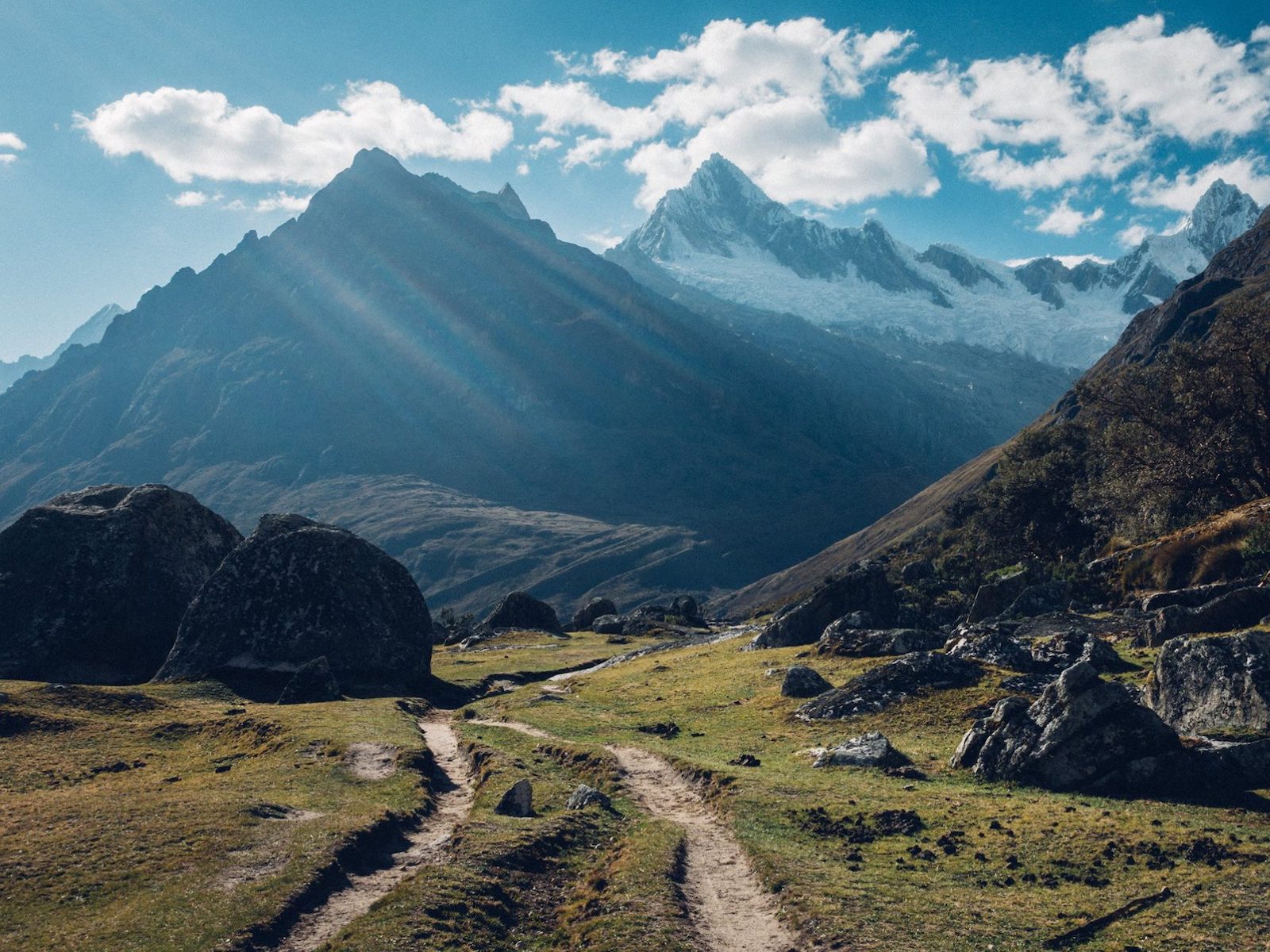
4) Santa Cruz Trek (Peru)
Location: Huaraz, Peru
Length: 3 – 4 days return
Highest Altitude: 15,583 feet
Distance: ~22.3 miles
Difficulty: Moderate
Huaraz in the north of Peru is one of my favorite places on Earth. I spent almost twoeeks alone in this city, exploring some of the best trails in the Cordillera Blanca mountain range. When people come to Peru, they always head for the south for the Inca trail and call it a day. What they don’t realize is that the true beauty of Peruvian mountains lies in the North, in Huaraz.
One of the treks I did was the Santa Cruz trek. I spent four days hiking in the solitude of the Cordillera Blanca mountain range through a beautiful canyon, stunning valleys and a pristine blue lake that serves as a great spot for camping. You will pass through one of the most beautiful scenery you will ever see in your life, sleep under the shadow of the towering Taulliraju mountain and be rewarded with a panoramic view of the mountain at its highest point of Punta Union Pass.
The experience of hiking this trail alone, carrying all my gear and food for four days, made it even more challenging and left me in awe for the rest of my trip in South America.
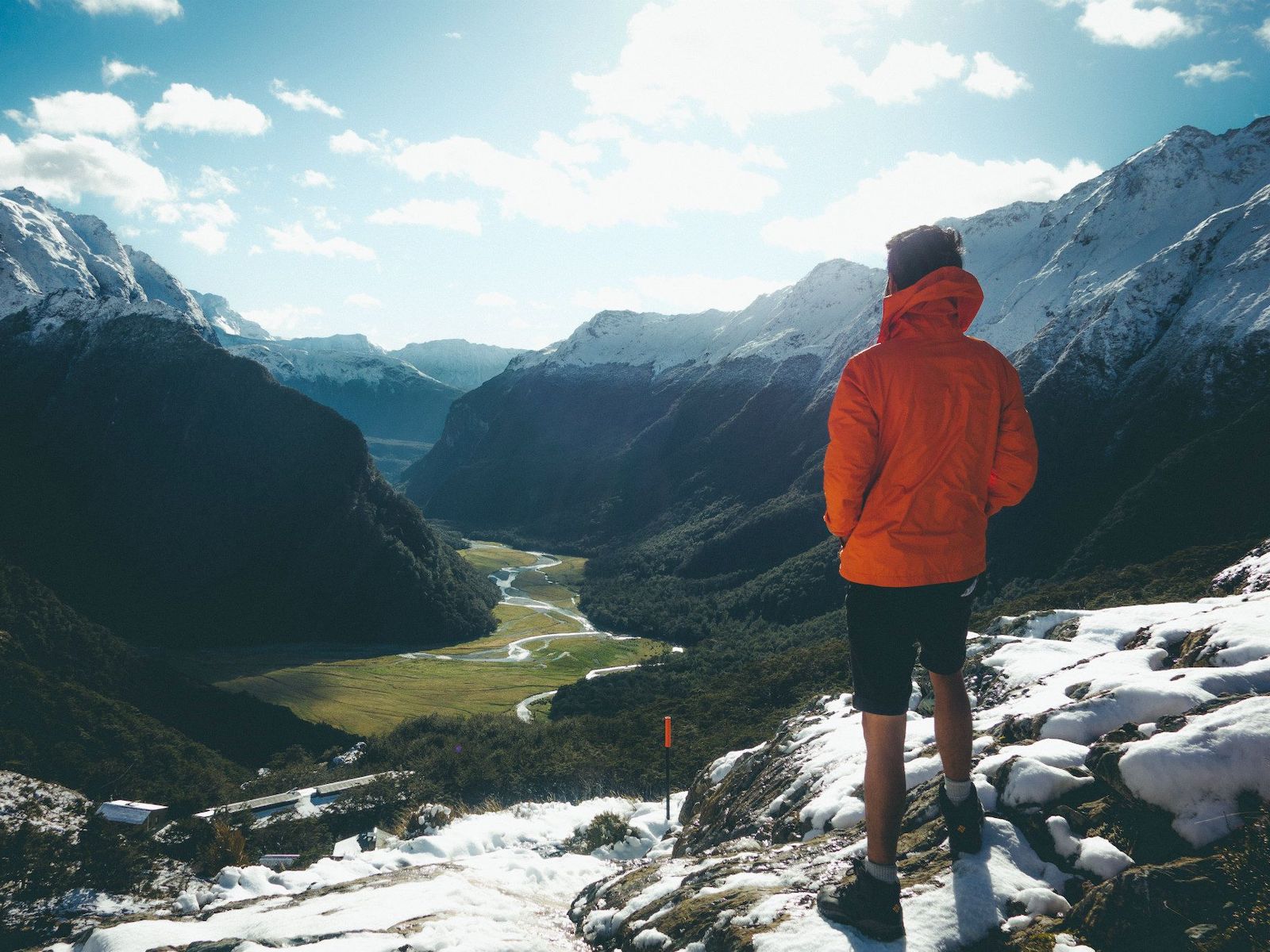
5) Routeburn Track (New Zealand)
Location: Te Anau, New Zealand
Length: 3 – 4 days return
Highest Altitude: 4,117 feet
Distance: ~20 miles
Difficulty: Easy
The Routeburn Track is one of New Zealand’s best great walks and for good reasons. The trail is located in the beautiful South Island starting near Te Anau and ends near Queenstown.
The trail will take you to the Key Summit on your first day, back down to sleep by the MacKenzie Lake, passing through the valley along the exposed Hollyford Face with expansive views over the Darran Mountains. Then it’s up to the Harris Saddle Shelter before coming down to Routeburn Falls Hut for your last night.
Your last day will be a casual walk down through the stunning beech forest, with a view of the Humboldt Mountains and ending at Routeburn Flats Hut. The Routeburn Track sure is an action-packed trail for you to do in New Zealand.
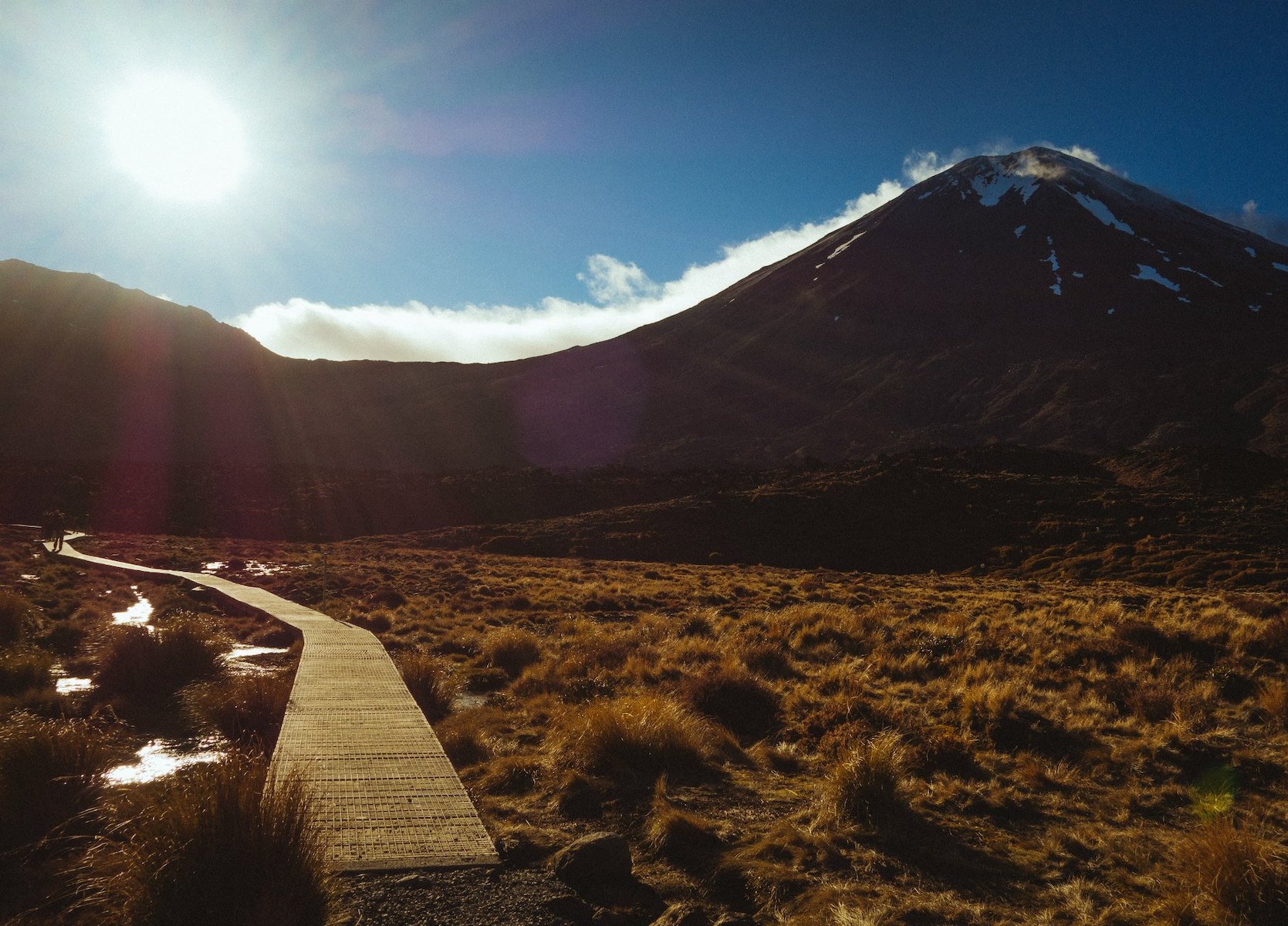
6) Tongariro Crossing (New Zealand)
Location: Lake Taupo, New Zealand
Length: 5 – 7 hrs return
Highest Altitude: 3,674 feet – 7,516 feet
Distance: ~ 12 miles
Difficulty: Easy to Moderate
Another great trail in New Zealand is the Tongariro Crossing trail, located in the North Island of the country near Lake Taupo. Like most trails in New Zealand, the Tongariro Crossing trail has a well-paced climb with casual walk up and steep parts all scattered throughout equally.
Starting from the Mangatepopo Valley, you will go through a series of gradual and steep climbs until you reach the saddle between Mount Tongariro and Mount Ngauruhoe. From here you can take a side trip like I did to go up Mount Ngauruhoe or to Mount Doom for Lord of the Rings fan. The trip will take two extra hours to do so but you will get a stunning view of the crossing in one whole swoop.
From the saddle, you will have to go through the South Crater before climbing again to the Red Crater. You will be able to see two lakes from up there, one in emerald green and the other in pristine blue. When you pass all the lakes, you will then have to zigzag your way past Ketetahi Shelter and down to the end of the trails.
The scenery is so diverse, it will have you thinking you were trekking for several days instead of five to seven hours.
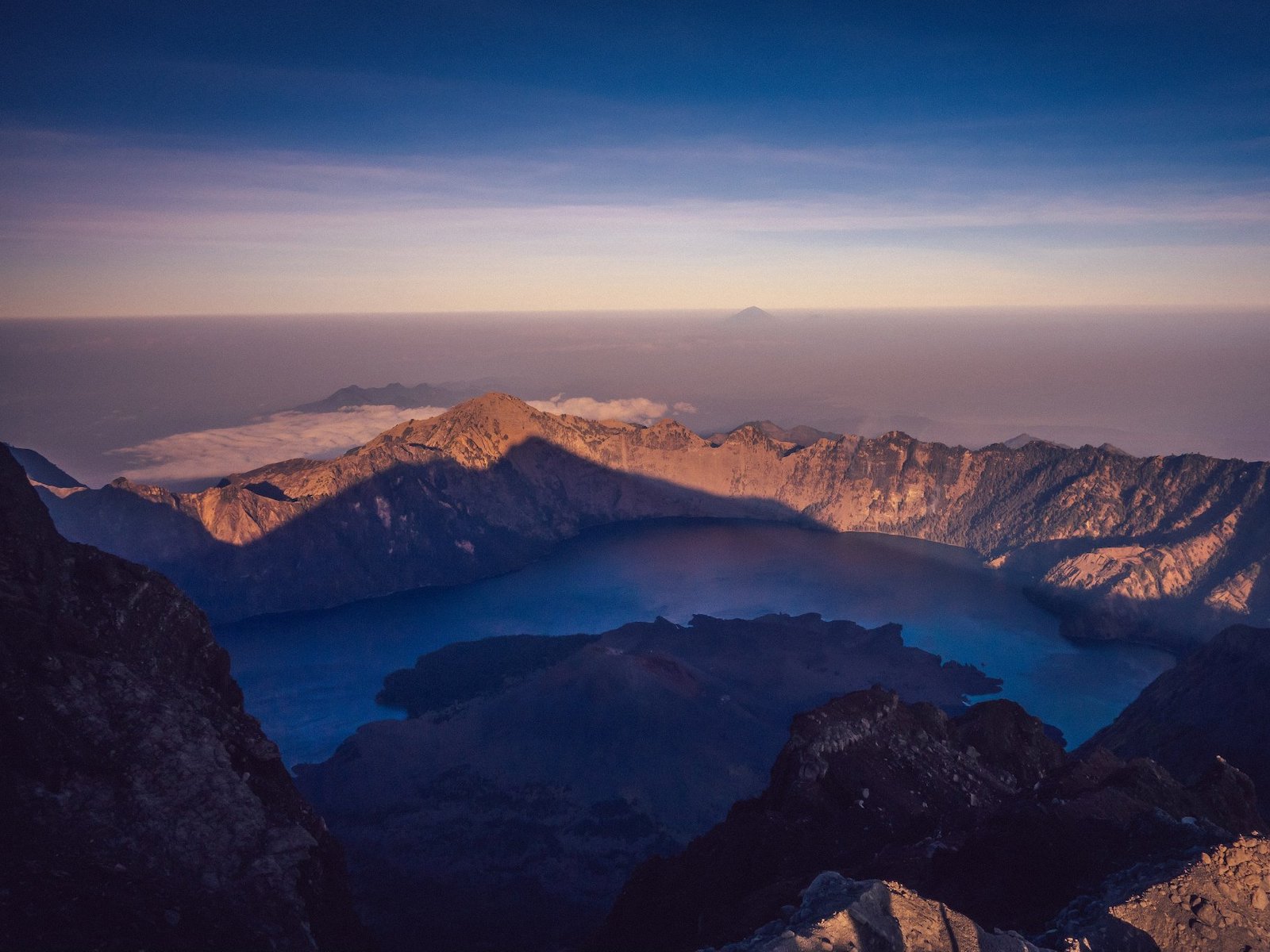
7) Mount Rinjani (Indonesia)
Location: Lombok, Indonesia
Length: 2 – 4 days return
Highest Altitude: 12,224 feet
Distance: ~ 21 miles
Difficulty: Moderate to Hard
Possibly one of the toughest hikes I have ever done, not because of the trail itself but due to the condition I was in while doing the hike. Hiking while suffering from good poisoning is not an ideal situation, to say the least.
That said, it is one of the best hikes you can do in Southeast Asia and you will be rewarded with a view of a volcano on an island inside a mountain on another island. Yes, that is indeed what you will see from the 12,224-foot-high summit of Mt Rinjani. The view is definitely better at sunrise when the shadow of the Mt Rinjani will be slowly receding from the volcano.
You will spend four days climbing up the ridge of the volcano, sleep under the stars, wake up early for a push to the summit and then down to the lake before climbing up again to another ridge and down, ending your trip. There is nothing more painful and rewarding at the same time than to climb up a volcano on a forever falling volcanic ash and then get to see a volcano on an island in a volcano on an island.
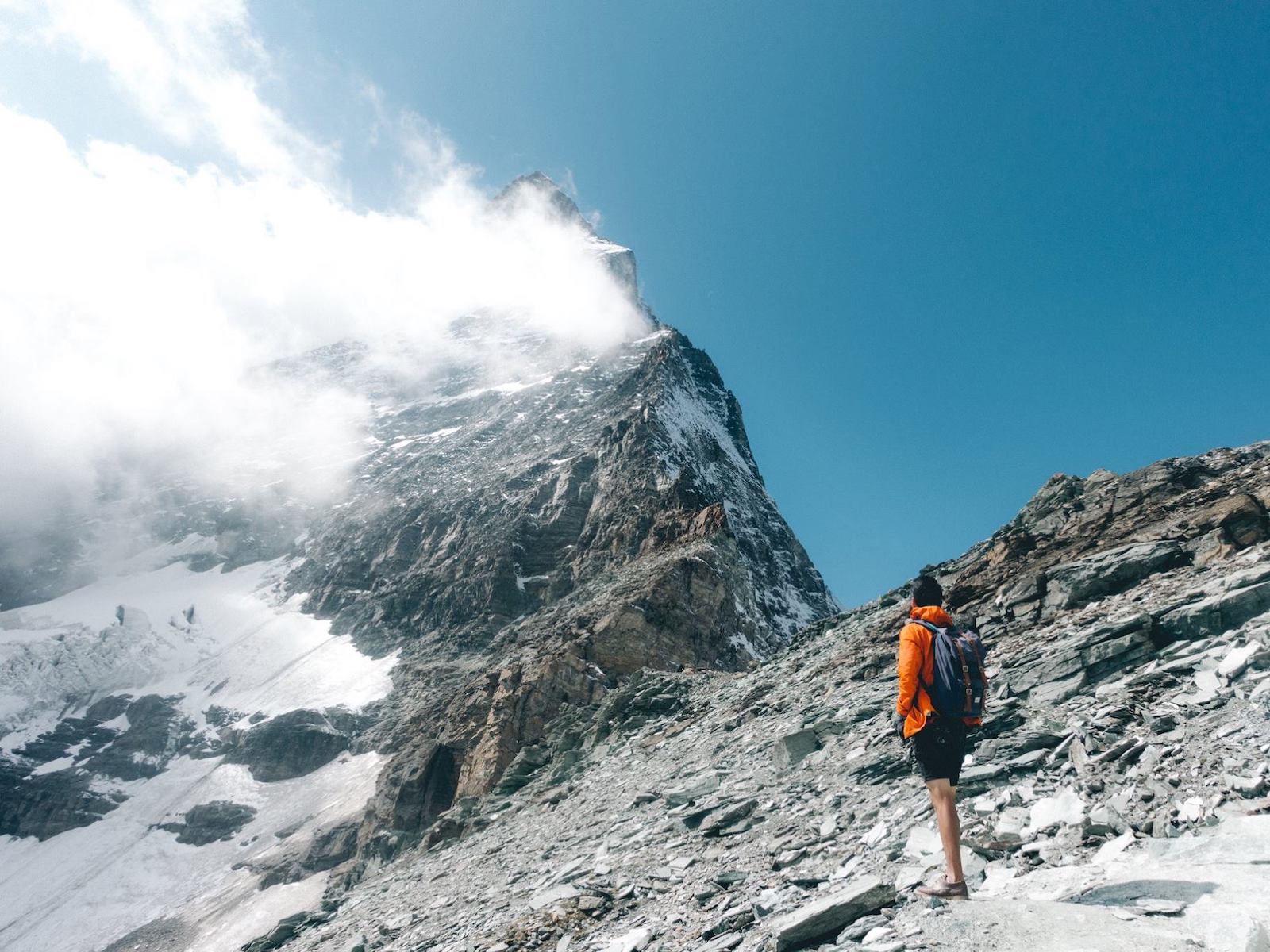
8) The Schwarzsee and Hornlihutte Trails (Switzerland)
Location: Zermatt, Switzerland
Length: 8 – 10 hrs return
Highest Altitude: 1,695 feet
Distance: ~15 miles
Difficulty: Moderate but Long
This is a combination of two trails that will get you the closest to the famous Matterhorn peak in Zermatt, Switzerland. The first part of the trail starts from the city of Zermatt and as you follow your way up the gondola line, you will arrive at Schwarzsee Lake where you can rest, have coffee at the mountain hut and continue your way up to the Hornlihutte. This is the exact location where one of the first climbers set off for their first ascent on the famous mountain in 1865.
You will go through a small traditional village before climbing up through the forest out into the exposed area at the Schwarzsee Lake. The landscape will become more rugged and rocky as you make your way up to the Hornlihutte mountain hut. If you decided to take an alternate route back via the Glacier trail, you will also be able to admire the mountain from the bottom of the glacier looking up. That was quite a sight to behold.
At the end of the Glacier trail, you will arrive at the Trockener Steg Lake where you can see the Matterhorn’s east face reflected off a body of water. There is no better way to see the Matterhorn than to hike this trail.

9) Laguna de los Tres trail (Argentina)
Location: El Chalten, Argentina
Length: 7 – 11 hrs return or 2 days
Highest Altitude: 3,871 feet
Distance: ~7.7 miles
Difficulty: Easy
Of course,Patagonia has to be on the list, but maybe this might not be the trail you are expecting. There are plenty of hiking opportunities in Chilean and Argentinian Patagonia, but the one I like the most is the Laguna de los Tres trail on the Argentinian side, starting from the quiet town of El Chalten.
This trail is my favorite because unlike the Torres del Paine and W Trek in Chile, the experience of hiking the trail is not ruined by the massive crowds that come with the peak season and has been plaguing those trails. Laguna de los Tres trail is a little less crowded, but offers you a similar experience as the trail will take you up close to the 3 famous landmarks of Patagonia, Mount Fitz Roy, Aguja Poincenot and Cerro Torre.
The trail is relatively easy compared to the other ones listed here with the majority of the trail pretty flat with two steep climbs at the beginning and at the end. You will pass through beautiful native woodland along the side of a mountain, coming across vast glaciers, frozen lakes and a few granite spires. As you continue on, you will pass through two camps where the last camp, Campamento Poincenot, is where you can stay overnight should you decide to extend the trip to two days. If you do so, I would recommend you go up to the Laguna de Los Tres as early as you can for the sunrise.
At the end of the trail, you will be rewarded with a stunning view of the impressive cobalt blue lake and icebergs of Laguna de Los Tres in the background. Over the icebergs, look up and stare at the looming spires of Fitzroy and its neighbors in awe and realize how fortunate you are to be able to see such beauty with your own eyes.

10) Laguna 69 (Peru)
Location: Huaraz, Peru
Length: 6 hrs return
Highest Altitude: 15,000 feet
Distance: ~7.4 miles
Difficulty: Moderate
Last but not the least, we are back in Huaraz again for another of my favorite trail, the Laguna 69 trail. This time, it only requires a day to complete but you will be rewarded with such a diverse scenery and plenty of photogenic mountains that you might forget you are doing a day hike. The trail begins slowly climbing through the valleys with several steep climbs along the way. Halfway through the trail, you will find a great spot by an alpine lake for a lunch stop before continuing on through a vast grassland. Push through the small granite path and head in to the heart of the mountain, where you will find a pristine blue glacier lake tucked away in between snowy mountains.
The moment you start to approach the lake, you will see a bright blue color, like nothing you have ever seen in nature. That’s when you will realize that you have finally reach Laguna 69. There is no mistaking it, the technicolor from the melted glacier is out of this world.
***
Nature has a way of rewarding you if you try hard enough and that is what I feel about hiking. The harder you work for it, the more rewarding it is. The mountain tests you, makes you lose your ego and you humbly appreciate both your own physical condition and the wild beauty of the world. I encourage you to go out there, get your hands dirty and start climbing.

/
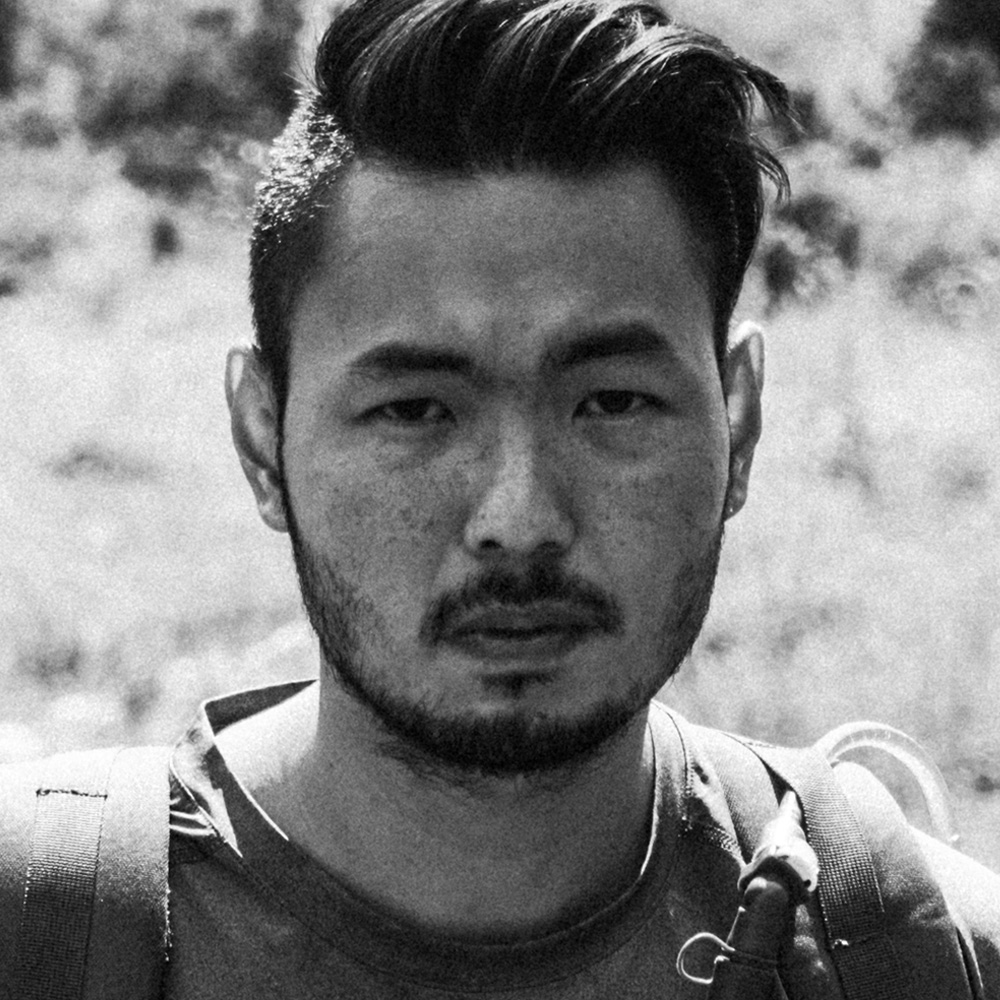 Pete Rojwongsuriya is the founder of BucketListly.Blog, a place where he writes about his travel adventure and life stories he learned for the last 6 years on the road. He is also a travel filmmaker, photographer and a digital nomad, traveling from one country to another, making inspiring travel videos, taking stunning photos and telling a travel story of the world. His work in travel films has been featured on National Geographic, BBC, and Vimeo.
Pete Rojwongsuriya is the founder of BucketListly.Blog, a place where he writes about his travel adventure and life stories he learned for the last 6 years on the road. He is also a travel filmmaker, photographer and a digital nomad, traveling from one country to another, making inspiring travel videos, taking stunning photos and telling a travel story of the world. His work in travel films has been featured on National Geographic, BBC, and Vimeo.
The post 10 Hiking Trails Around the World That Will Blow Your Mind appeared first on The Expeditioner Travel Site.
]]>The post I Took A River Cruise Through The South Of France. Yes, Really. appeared first on The Expeditioner Travel Site.
]]>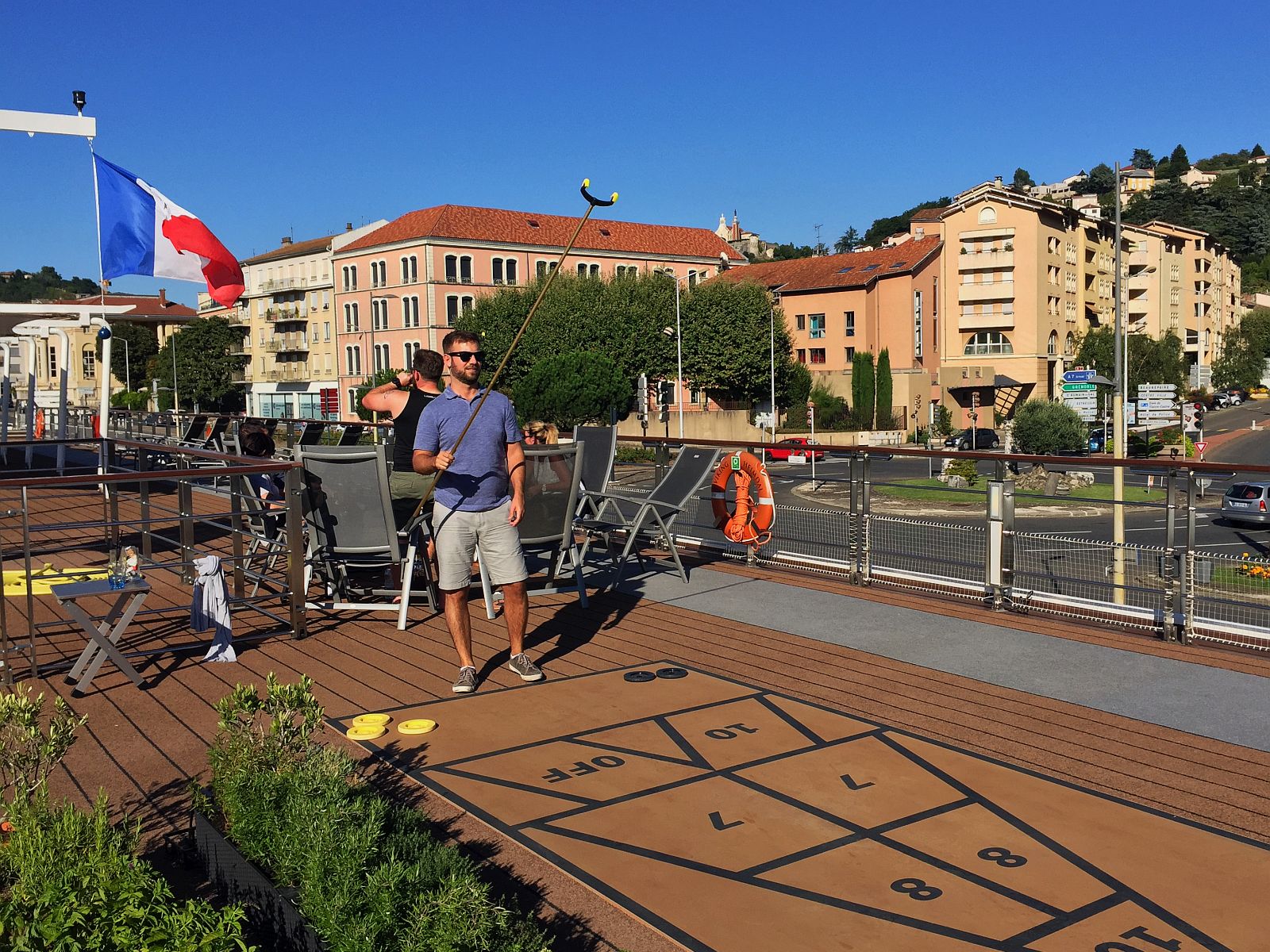
As I sat in the lounge of our longship nursing a freshly poured glass of wine, I looked around the room. Of the roughly 150 or so people attentively listening to the Entertainment Director’s welcome introduction (one of eight such all-hands-on-deck speeches we would hear over the next eight days), I found I could group the passengers into one of three distinct groups — except me, clearly the odd man out.
Roughly seventy percent of the boat were those one could refer to as Seniors: retirees, couples who were still working but whose children were in the reproductive stages of their lives, a surprisingly large number of widows traveling in bunches of three to four.
This particular cruise was earmarked for a gay and lesbian-themed group booking, which made up about twenty percent, and who I was to later learn easily made up the majority of individuals that had purchased so-called “Silver Packages,” which meant unlimited drinks and access to the top shelf-level bottles without incurring additional charges to their bill.
The third group, maybe eight percent, were well-heeled couples, mostly from Europe, that out-dressed us all come dinner time.
Then there was me. Actually, then there was me and one group of three Coloradans that — when combined with myself — made up the population of the boat born after the Carter Administration (okay, technically Carter served less than a year after I was born, but I’m rounding up here). We made up the final two percent, and our common thread was that we all enjoyed day drinking-friendly games (shuffleboard, Yahtzee, Scrabble) and day-drinking itself.
We, collectively, would be spending the next eight days cruising the Rhône River with Viking Cruises, beginning from the river’s mouth where it feeds into the Mediterranean up to Lyon, about 200 miles in total. Copious amount of wine and French cooking would be consumed, river locks would be admired in groups, and about 2,000 years of history would be condensed into daily excursions to some of the most picturesque, admired and most visited cities and villages of France, all under the Provençal sun in August. I’m not sure it gets much better than that.
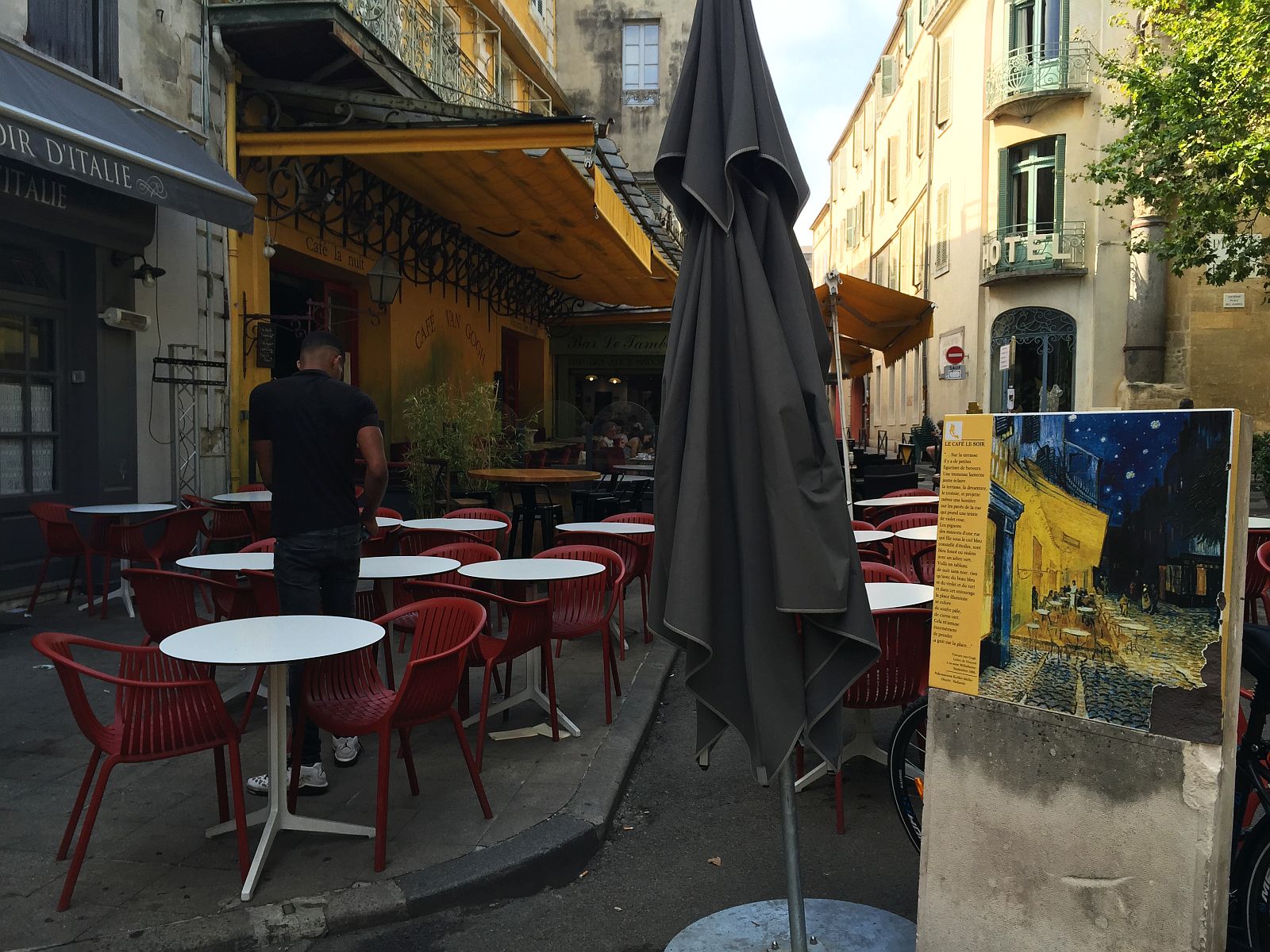
Earlier in the year, I was invited by Viking Cruises — one of the largest and best-known cruise companies in the world with 64 boats floating around the world — to take a cruise with them, and I jumped at the chance to take their Lyon and Provence eight-day river cruise, which includes port-of-call stops in Arles, Avignon, Viviers, Tournon and Lyon. This also included daily excursions to nearby vineyards, medieval villages, goat farms, chateau-turned-wineries and horse farms.
The first day began with a drive through endless fields of sunflowers to Arles, where we were to explore the many Roman ruins that are amazingly preserved in the center of town, including Les Arène, built by the Romans in the early 2nd century AD and that could hold 20,000 spectators during its heyday, as well as the Théâtre Antique, an outdoor theater from the 1st century BC.
Arles, of course, is probably most famous for not what it is but who called it home for a little over a year: one Vincent Van Gogh. And at mid-morning, we found ourselves in the courtyard of the hospital where Van Gogh was admitted after cutting off his ear. The motivation was unclear, history just tells us his favorite prostitute was given it as a gift. In fact, unknown to me at the time, but Arles is home to sites that were the subject of some of his most famous paintings. As any college Freshman who recently decorated their dorm could probably tell you, these include Café Terrace at Night, Bedroom in Arles, and Starry Night over the Rhône.
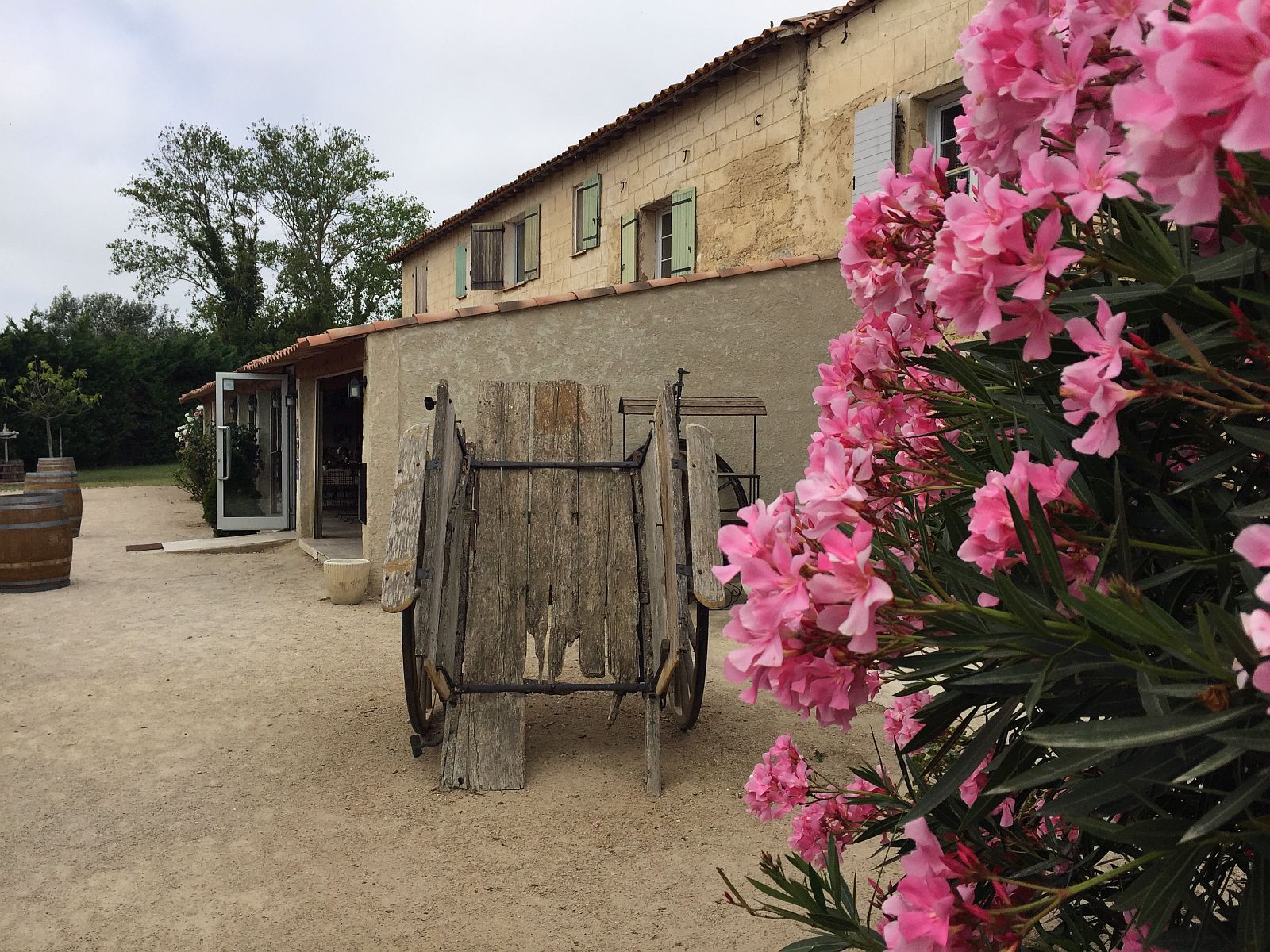
Afterward, we drove south about an hour to the Camargue, France’s protected Rhône River Delta region, home to centuries-old horse and cattle farms, weekend beach villages and about 500 species of birds. Think the Mississippi Delta region, but instead of Hurricanes there is wine, and instead of alligators there are cows.
We stopped for lunch and cow-viewing (yes, really) at La Manade Des Baumelles, a working horse and cattle farm where we followed our gut-busting meal of charcuterie and roasted chicken with a tractor tour of the grounds. We were shown the iconic white-haired Camargue horse that has called this area home for centuries, as well as a lugubrious group of black, long-horned Camargue bulls (one of two breeds used for fighting in Europe) that were content in resting under the warm sun while we drove by taking pictures. Oh to be a breeding bull raised in the South of France — what a way to spend your life!
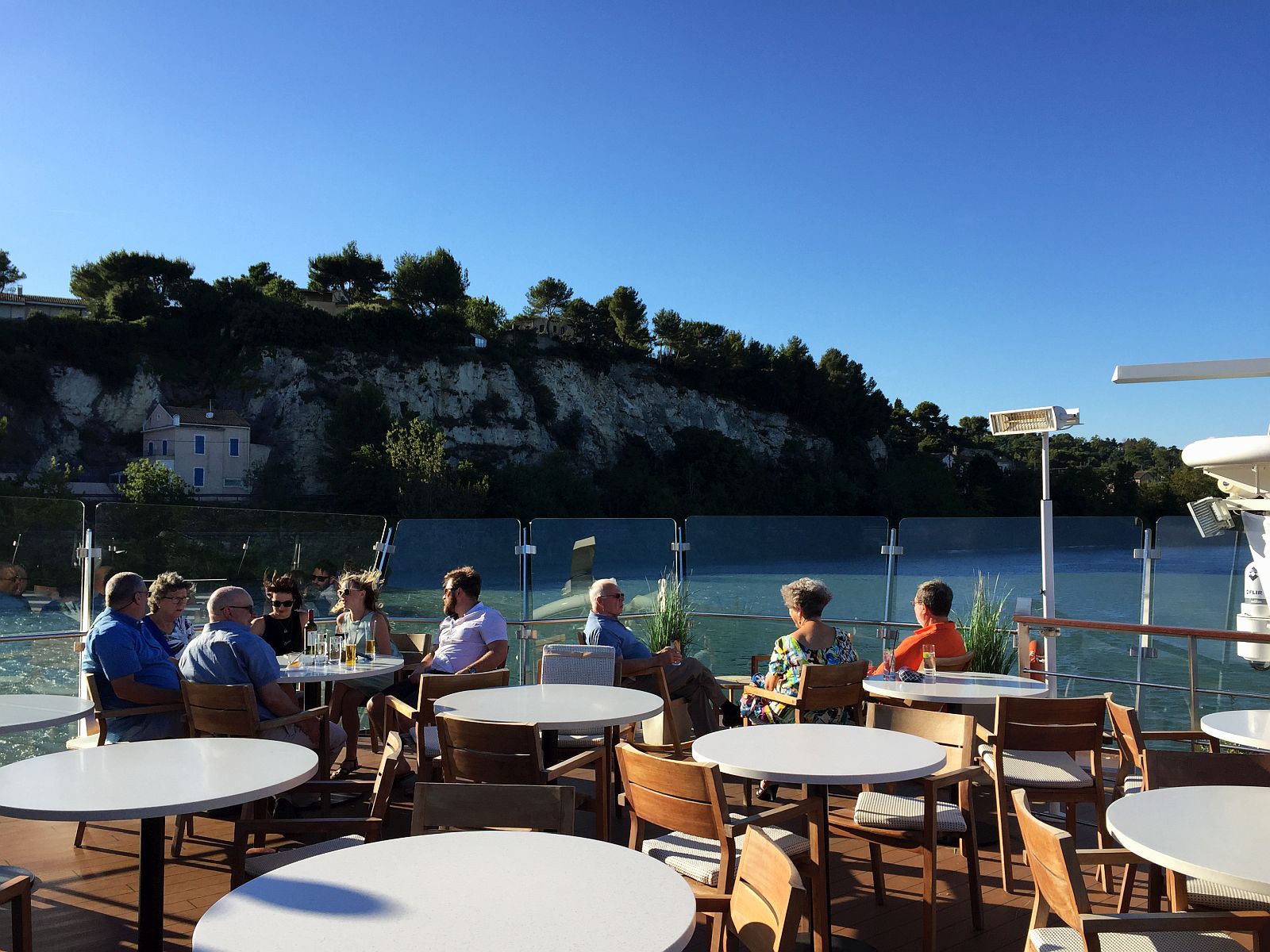
I can’t say I’m much of a cruise traveler. So what was it like spending eight days on one? In all honesty, I’ve got to say, it wasn’t bad. Wasn’t bad at all. Life on a river cruise tended to be a bit more regimented than I was used to during civilian life back on land. On the boat, as is custom on cruise ships, each morning a detailed itinerary was slipped beneath my cabin door (the Viking Daily), assumedly by the friendly Hungarian woman who somehow remembered my name from the moment I introduced myself. (One day I casually mentioned to her that the rules of Shuffleboard were a bit fuzzy to me, and a printout of regulation shuffleboard rules were delivered to me the next morning along with my Viking Daily.)
Breakfast would be served for about two-and-a-half hours, followed by the hustle and bustle on par with morning rush hour. At this time everyone would check back into their cabins and collect their sunglasses, wide-brimmed hats, cameras, day bags and complimentary Viking-branded water bottles and congregate outside to be grouped into one of eight or so guided tour groups. The tours would usually wrap up a few hours later, followed by another leisurely meal either inside where you could have a sit-down lunch, or at the cafe where you could take your meal outside to the deck and watch the waters of the Rhône peacefully glide by.
Following lunch, people usually grouped themselves into one of two camps: the nap in the air-conditioned lounge with a cocktail by their side camp, and the head back out into the world and take part in learning about French history and culture camp, the latter of which meant you were taking part in one of the many daily scheduled excursions for the day.
Perhaps underestimating my need for a daily afternoon nap during a weeklong stretch where the words “seconds” and “dessert” were used more than the entirety of the rest of the year, I signed up for every single afternoon excursion offered, which is how I found myself one afternoon in Avignon as part of a group walking the Passage de l’Oratoire and Rue Saint-Agricol, taking tiny shots of locally produced olive oils and downing macaroons from local shops.
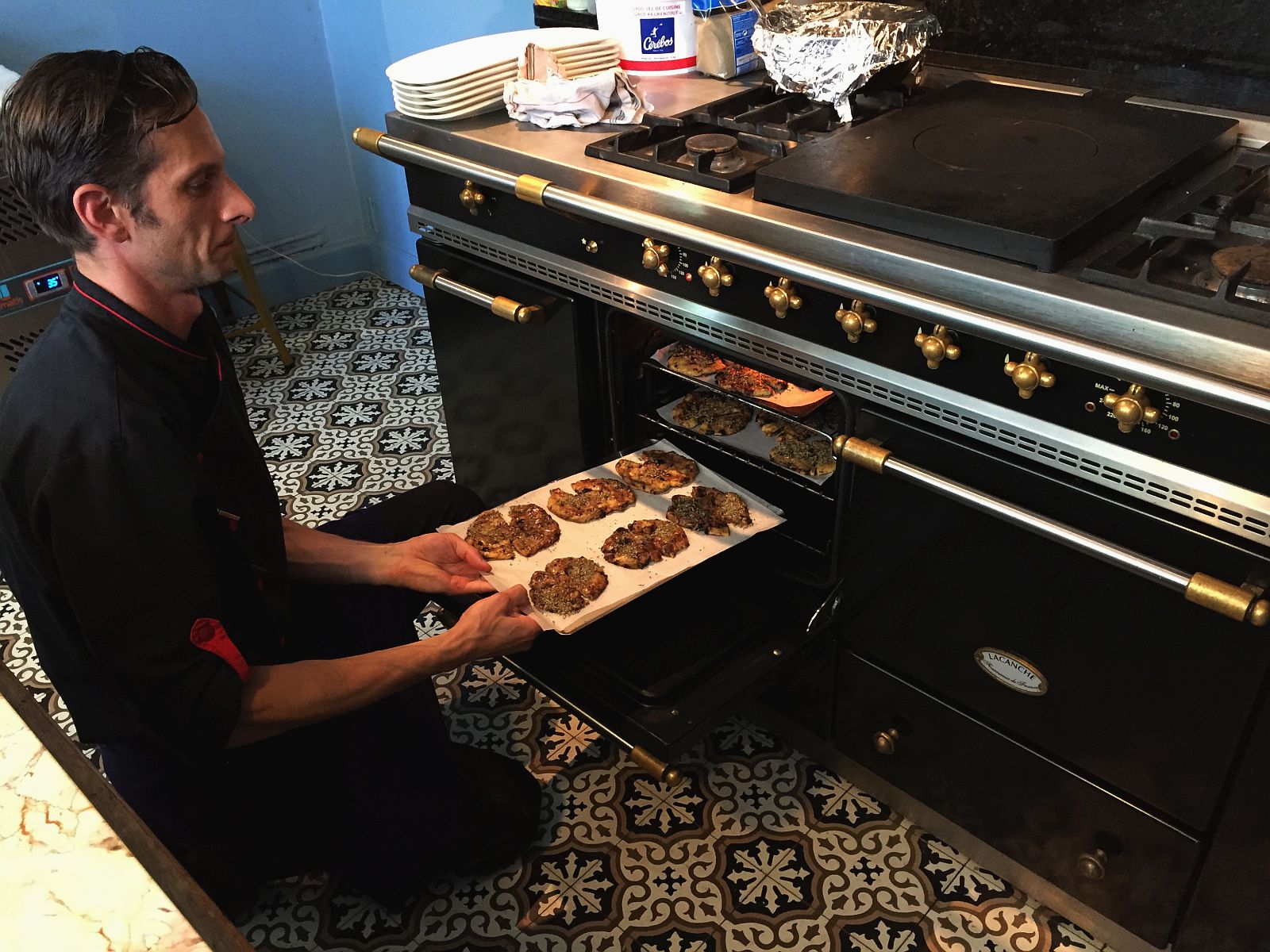
Our small group consisted of two women whose husbands were back at the boat (they were part of the nap camp), and a couple from New Jersey who easily spent in Euros at the macaroon shop what I had allotted as my daily budget. What we were really excited about that afternoon was the fact that we were scheduled to take a cooking class by a local chef at La Maison de Fogasses, a one-time mansion dating back to the 12th Century. The building, owned by Avignon local Corinne Guyon, was recently converted by her into a long-stay artists colony complete with a pétanque court and a popular cafe in its backyard.
After we arrived, we were led out back for a quick glass of wine — we were about to handle cutlery of course — then ushered upstairs to the kitchen of Chef Anthony Rossi who had us in short time kneading dough and brushing liberal amounts of butter on what would be our own prepared batch of the classic pastry Fougasse, complete with traditional Herbes de Provence (a mixture of Rosemary, Thyme and Oregano).
This was followed by a lunch of Fish Provençal (thankfully not prepared by us), wild rice and more wine (notice a pattern here?), all of which I scarfed down in a so-very-not-French way. But I had good reason: I had to make my way back to the quay to catch the bus for the other afternoon excursion: Châteauneuf-du-Pape.
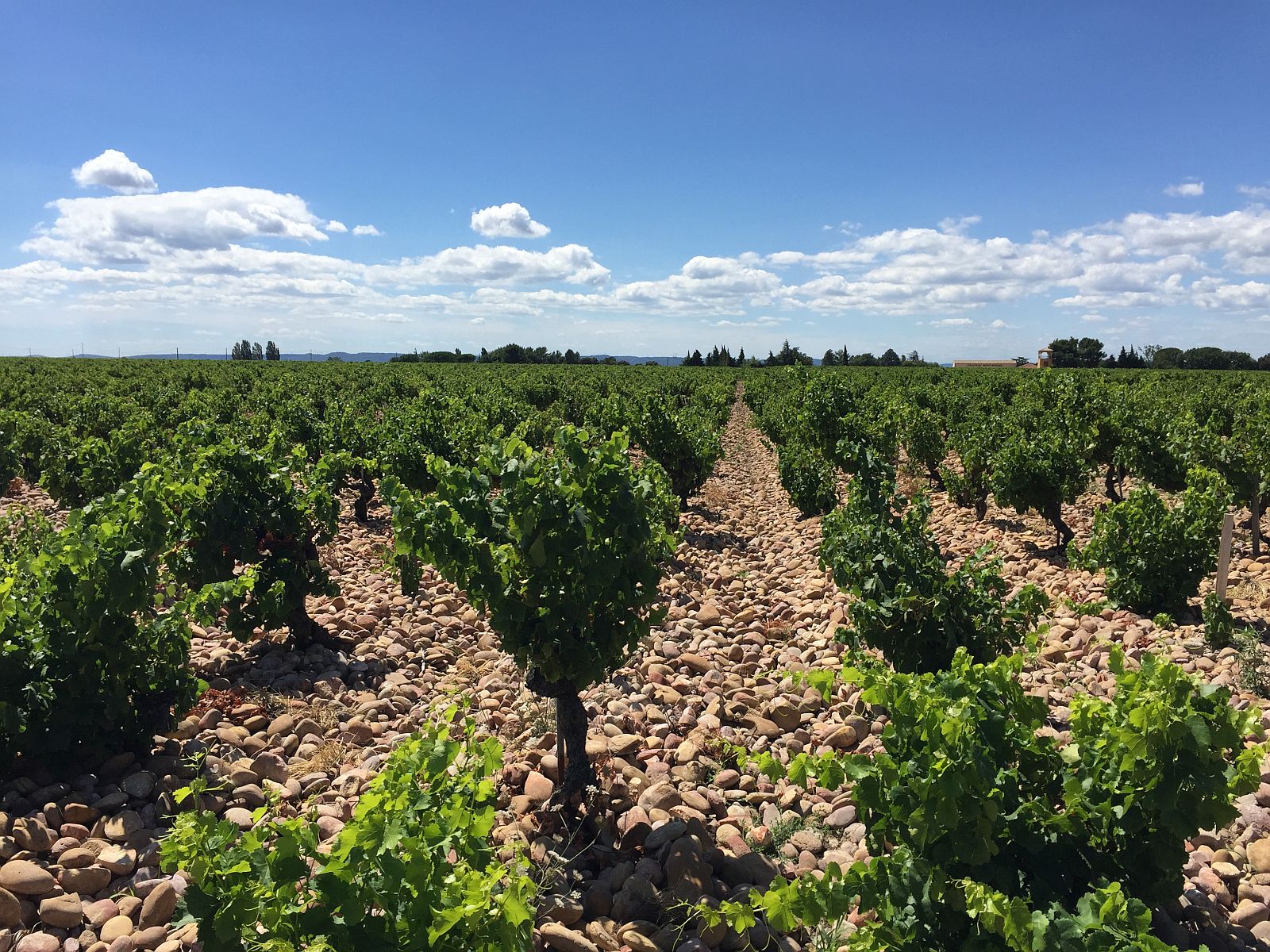
Châteauneuf-du-Pape is famous as home to the medieval castle built as a summer home by Pope John XXII and of course for its wineries. Our bus pulled up to the grounds of the Domaine Bosquet des Papes vineyards, and the unique terrain quickly became apparent. Since this area is essentially an ancient river valley, the short, stubby vines were growing out of a sea of galets roulés, or round rocks, that had once been at the bottom of the river and were now covering the thick clay soil where the roots dig deep in search of water. The rocks are famous for regulating the temperature of the ground — blocking the sun during the day, then slowly releasing it over the night hours — which causes the mostly Grenache, Syrah and Mourvèdre grapes to ripen quicker than normal.
This was followed by a wine tasting and much-needed instruction at the winery Maison Bouachon, where I will forever be remembered as the person at the table who helped ensure his neighbors’ glasses were fully emptied before each new tasting through his own heroic consumption. I think we then saw what appeared to be some sort of medieval festival taking place back in town — I remember people in chain mail wielding swords and lots of cured meat being sold on the street — but this part of the afternoon starts to become fuzzy in my memory (see: wine tasting with groups of age 70+ women).
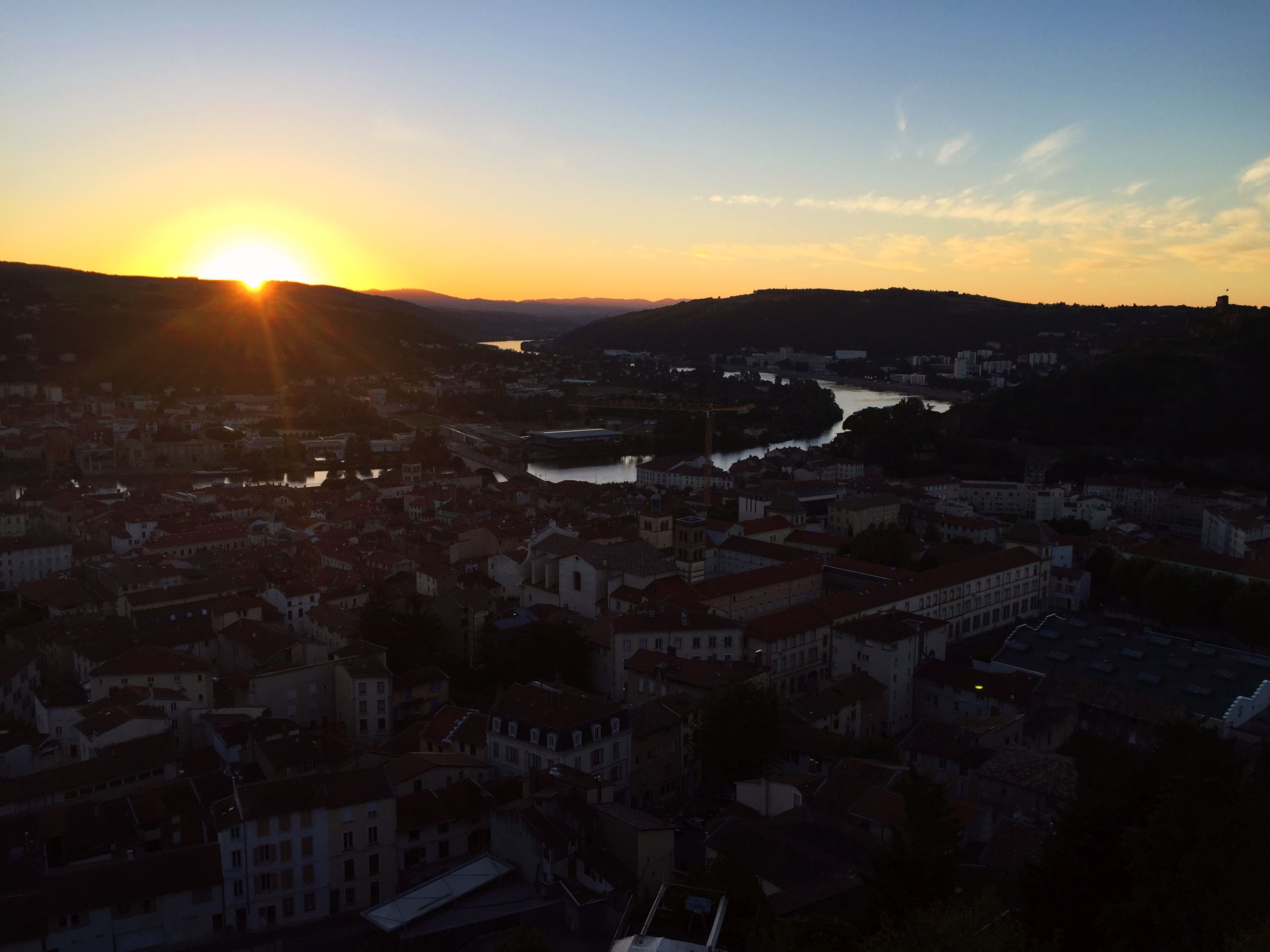
Not to stress this too much, but tours are not exactly my thing. However, the quality of the guides partnered with Viking at each stop were easily the highlight of the trip. Oh to come back to life as a summer tour guide in the South of France — they’re really giving the black bulls a run for their money on my list of humans and/or people I want to come back as in my next life.
Yes, I felt a little goofy carrying around the wireless headsets the guides has us use — this coming from a traveler that perhaps too proudly avoids all variations of guided tours — but the number of facts, enthusiasm in which to share those facts, and the patience to repeat said facts to each person who suddenly was having trouble operating the headset (this seemed to happen to a member of the group about every 10 minutes) was an indelible addition to the trip.
This perhaps was best exemplified by our guide at Vienne. Once a major Roman colony founded by Julius Caesar in 47 B.C., this small city about 20 miles south of Lyon is home to some of the best preserved relics and sights left over from the Roman period. Our first stop was to the Musée gallo-romain de Saint-Romain-en-Gal, a modern structure situated on the western slope of the Rhône, home to an impressive collection of Roman artifacts, including frescoes that adorned the foyers of large mansions, to kitchenware and furniture that had been buried for over 2,000 years.
Outside the museum is a preserved excavation site that features the foundations of the many mansions that called this river plain home. From our elevated vantage point at the museum, our guide dryly pointed out that a school was supposed to have been built there, but the inconvenience of finding an invaluable archaeological site forced city planners to relocate the new school’s location further up the road.
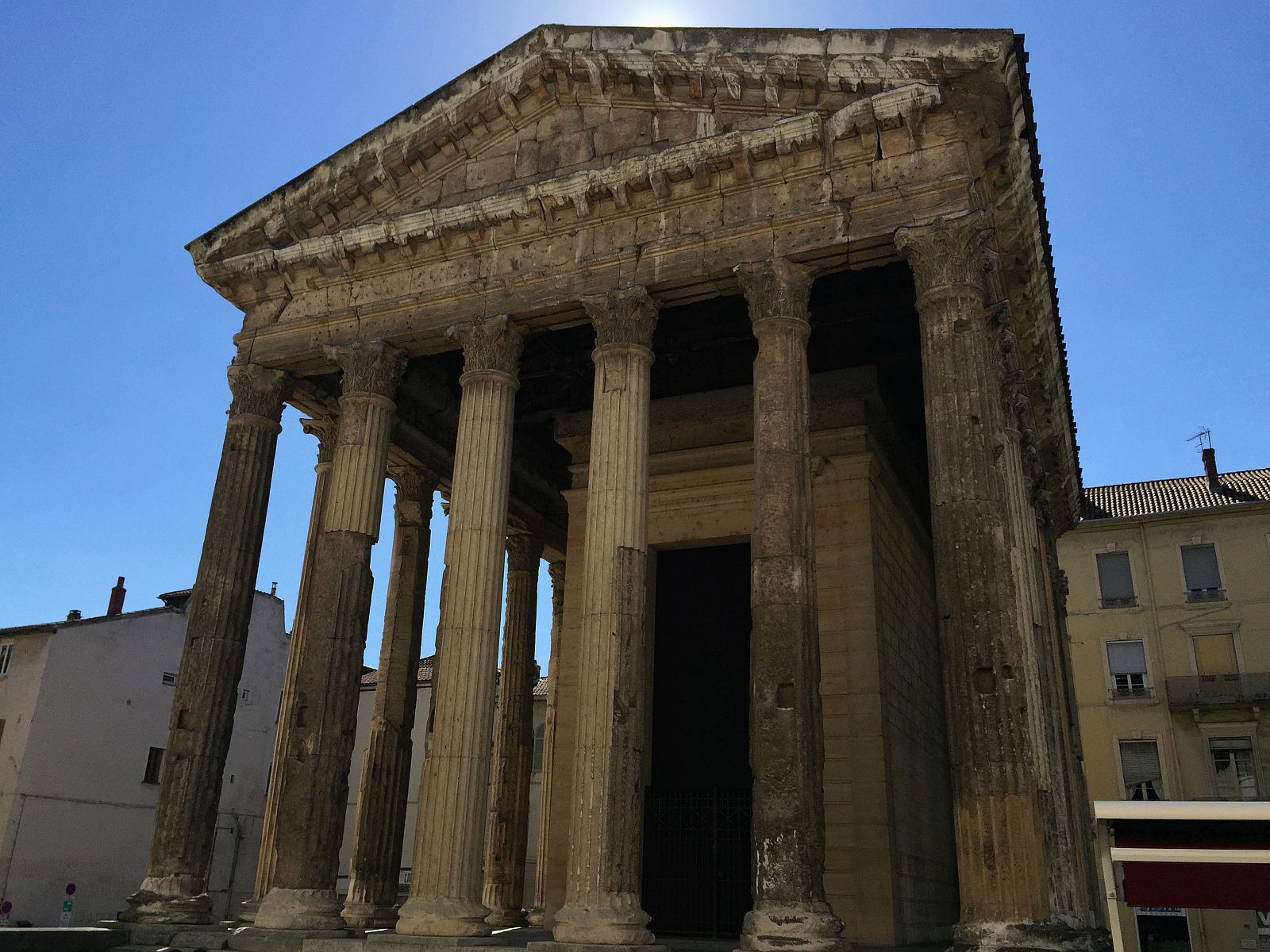
We then traveled into town where the highlight of Vienne is revealed suddenly as you emerge from one of the many narrow streets leading to its center. Here, surrounded by mid-century apartment buildings and a number of cafes dotted across the open plaza, is the Temple of Augustus & Livia. Closely related to its more famous cousin, the Maison Carrée in Nîmes, the Temple is a beautifully preserved temple that dates back to 1st Century and is considered one of the best preserved Roman Temples in the world.
Our guide pointed to many small details about the facade of the temple, including signs it was temporarily converted to a Christian church, thus sparing it from destruction over the years (later, during the French Revolution, it was used for secular purposes, once again thankfully helping it to avoid destruction).
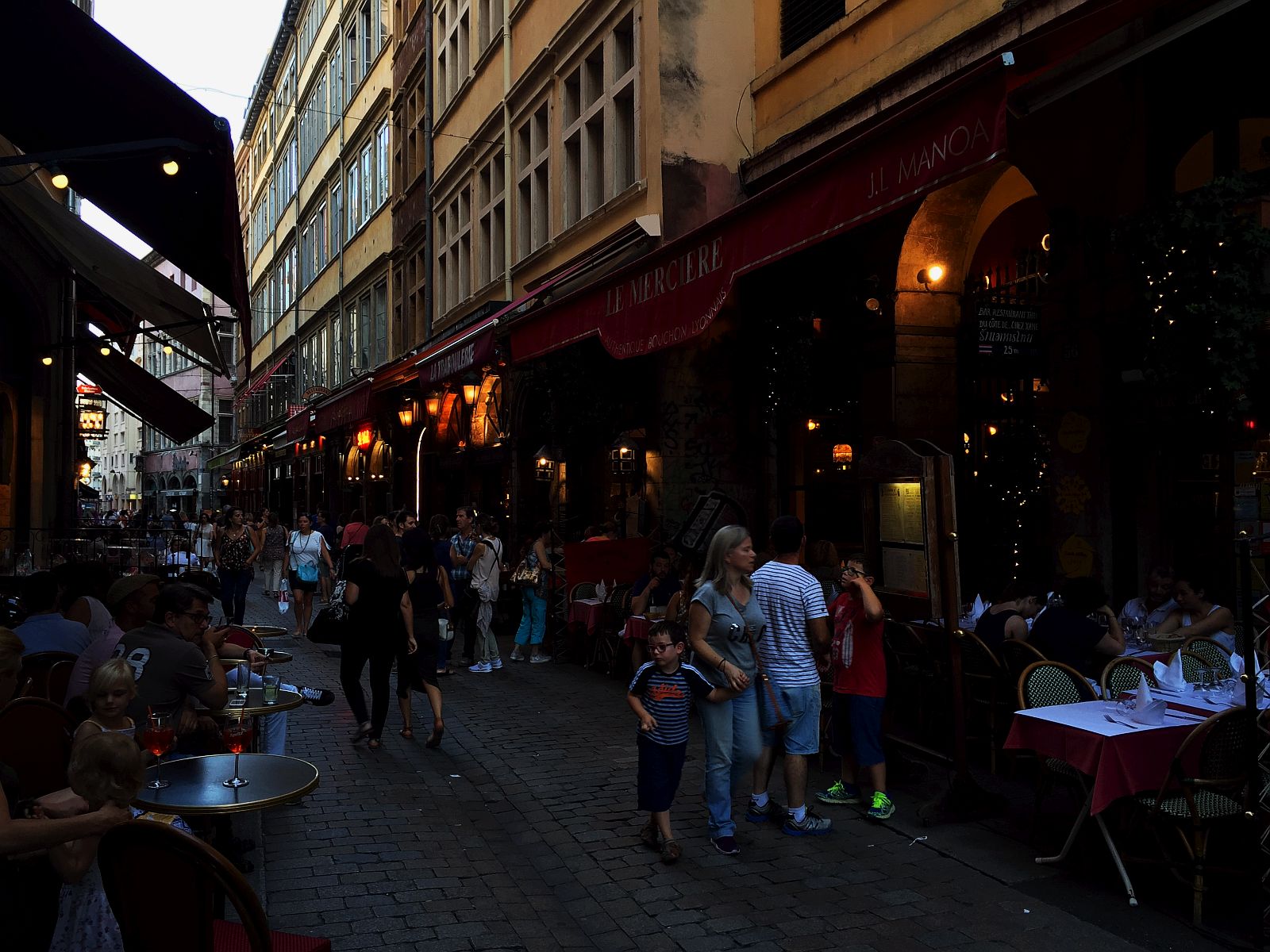
Our last port of call on the trip was Lyon, France’s third-largest city, and the country’s unofficial gastronomical capital (Lyon is the birthplace of famed chef Paul Bocuse). Lyon is also where the Rhône meets the Saône after emerging from high up in the Alpine mountains to the east, then effectively doubling in size and turning south toward the Mediterranean in the center of the city.
We docked next to the University of Lyon, a central spot just south of the ornate Pont de l’Université, which you can cross to get to the 1st and 2nd Arrondissements, then over the Saône and into Vieux Lyon, the district that can date its history back to the Renaissance Era.
Walking along the narrow cobblestone Rue Saint-Jean today, you will mostly see small cafes, English-style pubs, restaurants and few dozen or so ice cream shops catering to the masses of visitors that descend upon the city during the summer months and the city’s large University population. But, if you look hard enough, and you are with the right guides, you can try a few doors along the street and enter into public courtyards surrounded by homes that date back to the 16th Century. You can still see the small fountains where water would be gathered, and you can gaze up at the balconies overlooking the courtyards.
Lyon was also known during the German occupation as the “Capital of the Resistance,” and the many narrow passageways, secret entrance ways and above-ground walkways in the Vieux Lyon were perfect for Resistance fighters to escape capture from their occupiers.
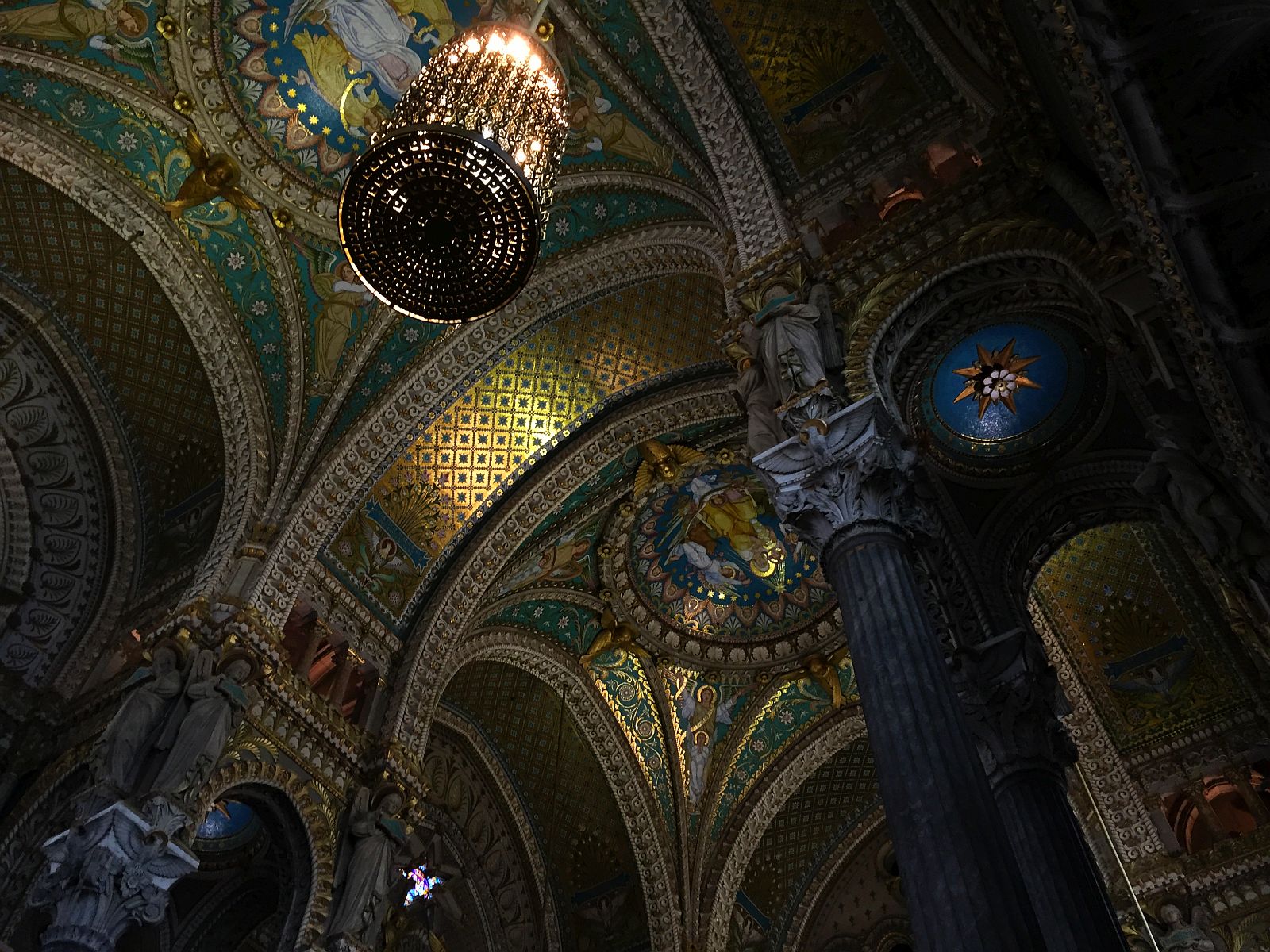
Towering above the district is Fourvière hill, where the city’s most famous basilica, La Basilique Notre Dame de Fourvière, sits above the city and provides the best panoramic views of Lyon.
After a morning of exploring, we set out for the nearby village of Perouges, affectionately known as one of the most beautiful villages in Europe. Located a short 45-minute drive from Lyon, Perouges is a preserved hilltop Medieval village that can date its origin back to the 12th Century.
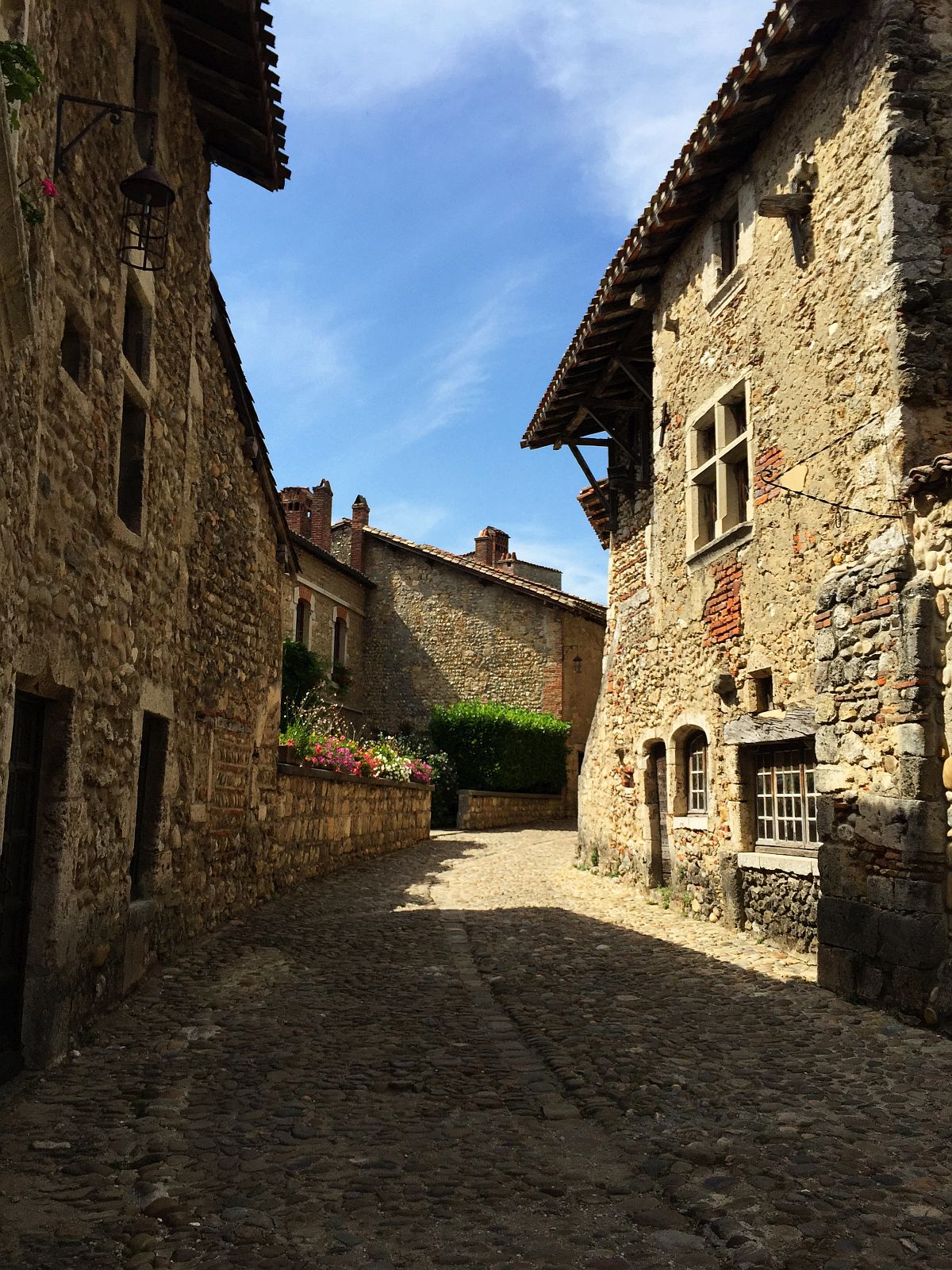
As soon as you walk past the stone walls that had protected the village for centuries, you are transported back into time. The village’s thousand or so inhabitants are required to maintain the stone facades of their homes and shops, and you are free to wander along the circular cobblestones streets, stopping into the many craft shops and restaurants that welcome visitors throughout the year. The image of small Peugots that come slowly rumbling down the street is a jarring contrast to your surroundings, but is a nice reminder of how France has worked hard to balance its history with the needs of contemporary life.
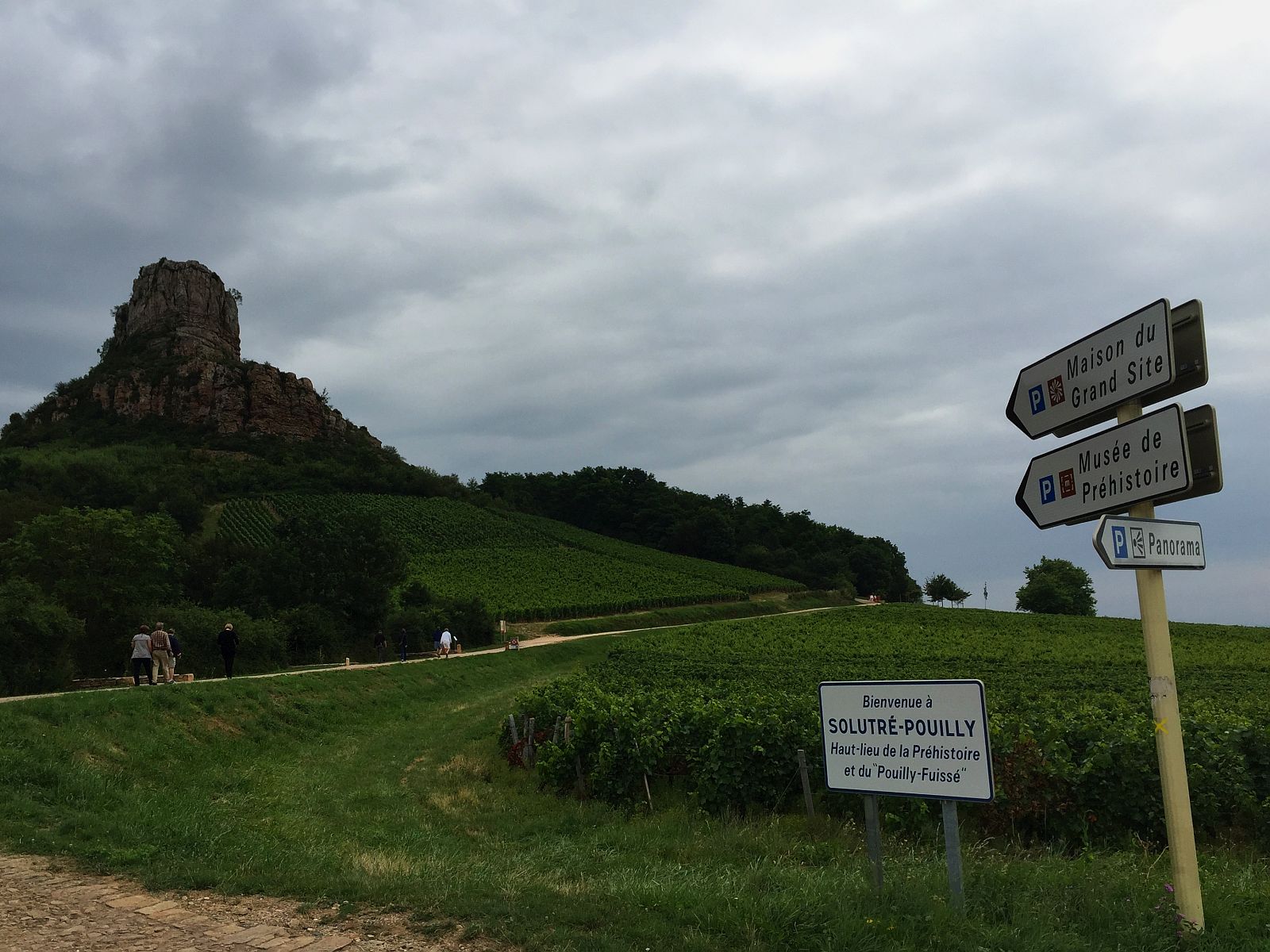
On our final day of the cruise, our last excursion was north to the famed Beaujolais and Burgundy wine regions. As our bus climbed north of the city and along the Saône, we were greeted by miles and miles of Gamay vineyards, a purple-colored grape that produces a light-bodied, fruity wine, and which were destined to make it to some of the world’s most coveted bottles.
The region is filled with countless small village dedicated to the centuries-old history of wine-making, and a drive through the area can easily conjure up images of dropping everything and starting your own winery, a tradition that has been the root of draining more retirement accounts throughout the years than probably any other activity.
Of course, when there’s wine there’s great food, and our final visits of the day were to a local truffle and goat farm. First we pulled up to Le Cos-Piguet, where a spirited and well-trained canine truffle hunter, Chinook, and his owner, Olivier Devevre, greeted us then led us up a gentle hill to a fenced-off orchard where the magic happens.
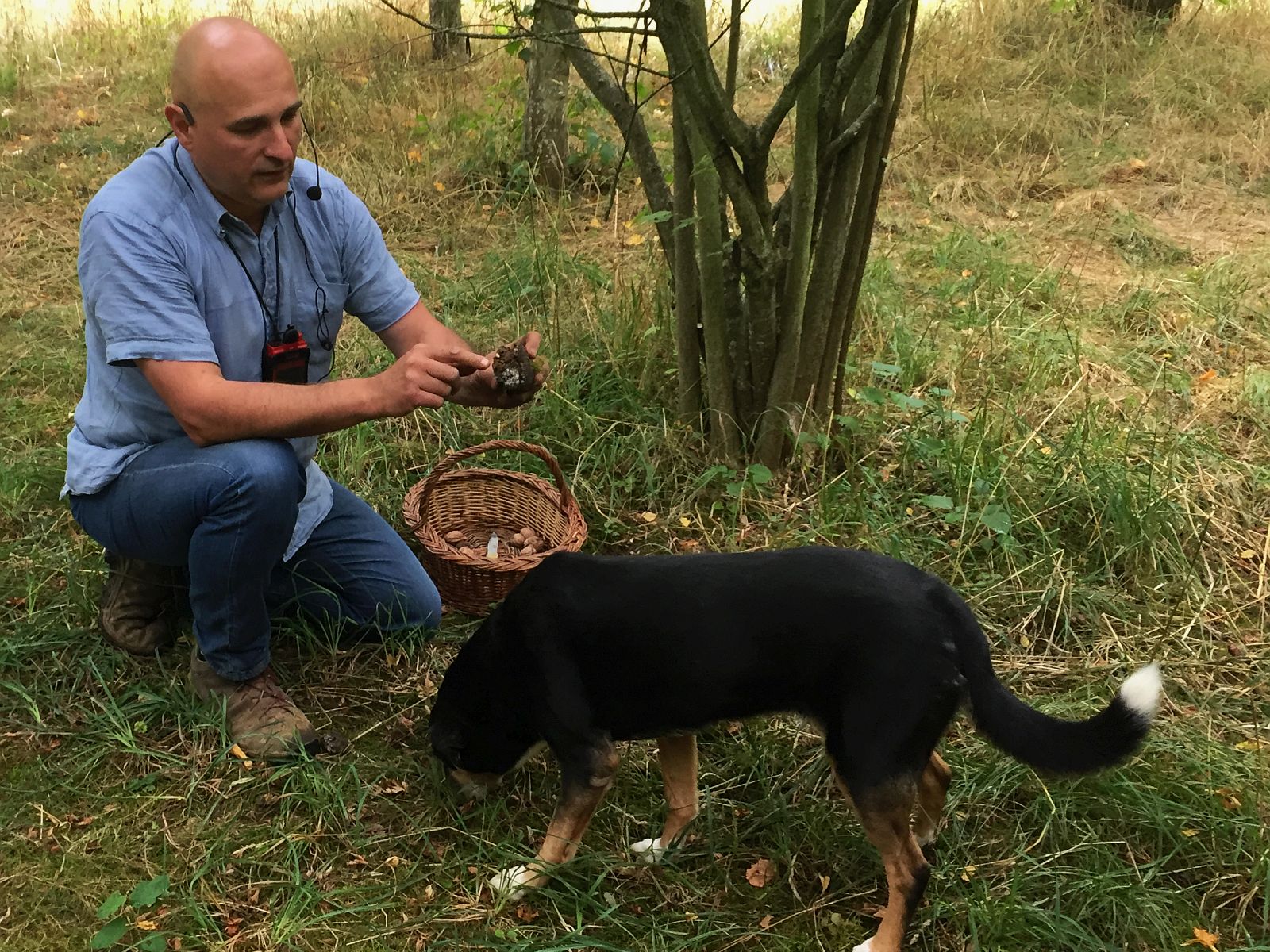
Here a grove of Oak Trees are hosts to truffles that grow in and around the fertile tree’s roots, and are best discovered by the sensitive nose of man’s best friend. Olivier demonstrated us Chinook’s sniffing capabilities by letting him wander around the grounds until he would stop suddenly and began furtively digging for his prize. We were then led inside to their farmhouse to try their homemade truffle-infused butter that we liberally spread on slices of bread.
Finally we traveled to nearby Chevrerie La Trufiere, a goat farm founded by Sylvain Chopin, and which is home to a herd of 150 or so very friendly Alpine goats, a breed known for their ability to produce milk and to make mischief by climbing as high as they can in whatever surroundings they are in at that time (I saw about 5 goats precariously perched on a window sill above the rest of the herd with little indication as to how they made it that high).
After a long visit petting and feeding our new furry friends a mixture of hay and alfalfa, we we were led inside for a tour of their dehumidified refrigeration units where the cheese is aged, and given a taste of the various varieties they create. All of course accompanied by even more wine.
I couldn’t think of a more fitting way to have spent the day. Good food, artisanal cheese, lots and lots of wine, an exploration of traditions that date back generations. Oh to come back one day in a future life as someone who spends their summer days traversing a river through the South of France. Life couldn’t get much better.

/
 Matt Stabile is based in New York City, and is the founder and Editor-in-Chief of The Expeditioner which was founded in 2008. You can read his writings, watch his travel videos or contact him via email at any time at TheExpeditioner.com.
Matt Stabile is based in New York City, and is the founder and Editor-in-Chief of The Expeditioner which was founded in 2008. You can read his writings, watch his travel videos or contact him via email at any time at TheExpeditioner.com.
The post I Took A River Cruise Through The South Of France. Yes, Really. appeared first on The Expeditioner Travel Site.
]]>The post Missing Paris: Running The Paris Marathon appeared first on The Expeditioner Travel Site.
]]>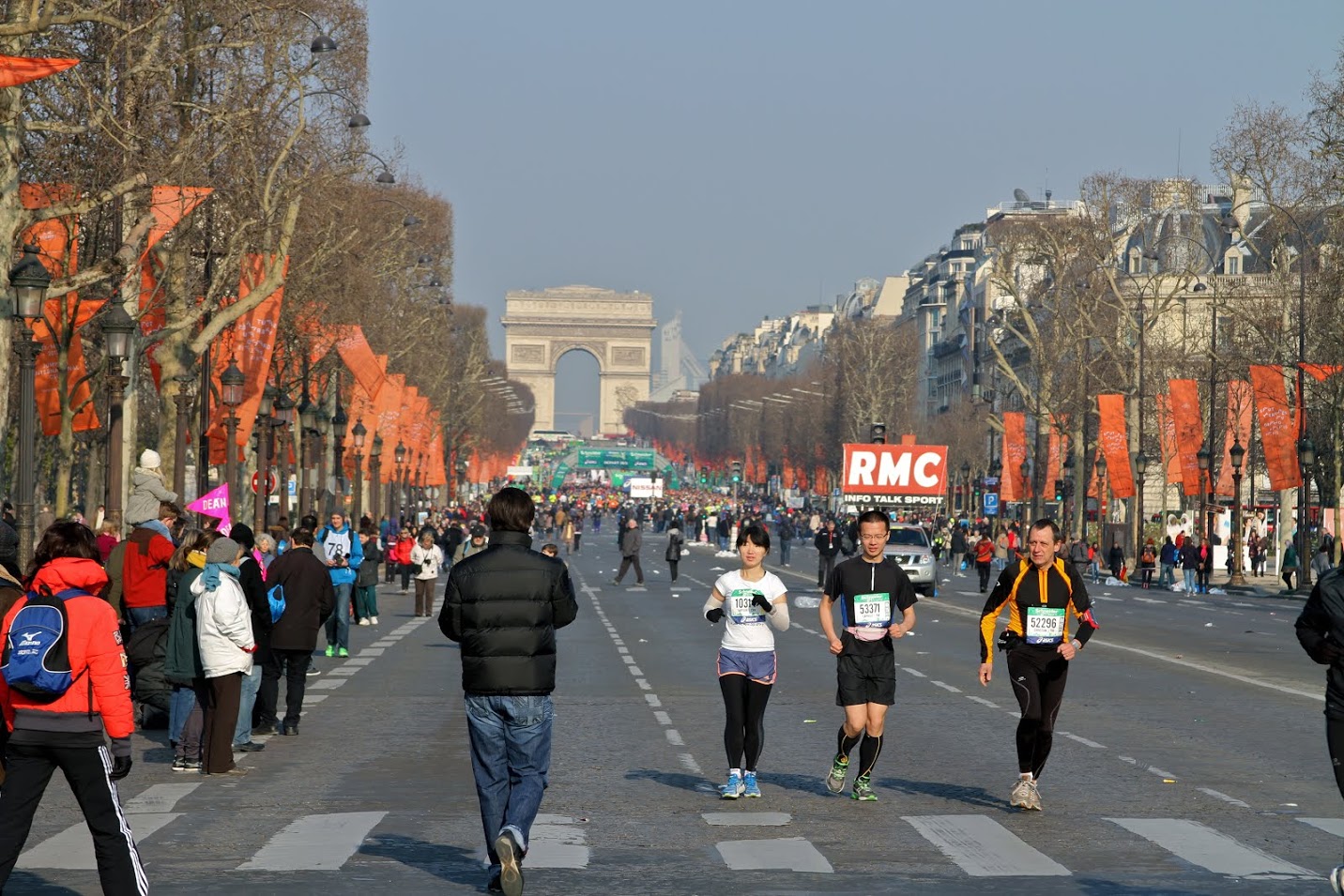
Seven miles into the Paris Marathon I was content, blissfully lost in the illustrious City of Light. But then I saw the pacesetter and I was hooked. So fanatically attached to the mythical four-hour mark, I missed it all. Focused on the clock, I missed Paris. Well, almost.
The day before the Paris Marathon, I visited the running expo in a gigantic convention center. Strolling from vendor to vendor, I stopped at a poster the race organizers had created for the almost 40,000 participants. Alphabetized and running horizontally on the massive poster were the names of every runner.
Laid over the names was the marathon route through Paris, a thick white line that happened to obscure an unlucky few. I watched as participants pointed gleefully at their names, making peace signs or a thumbs-up for cameras. Some growled as the great white route bulldozed through a letter in their name. My name was nowhere to be found. It was completely obscured by the route.
In the Marathon de Paris runners must show their race bibs to a volunteer before they can squeeze through a narrow opening in a ten-foot-high fence to join the other 39,967 participants. After you cross the threshold, you become a kind of wild park animal for friends, family and spectators dangling from windows and sipping espressos in cafes. The pictures that day have the unfortunate familiarity of a zoo. Me, hopping in place, making goofy faces and tongues at the camera.
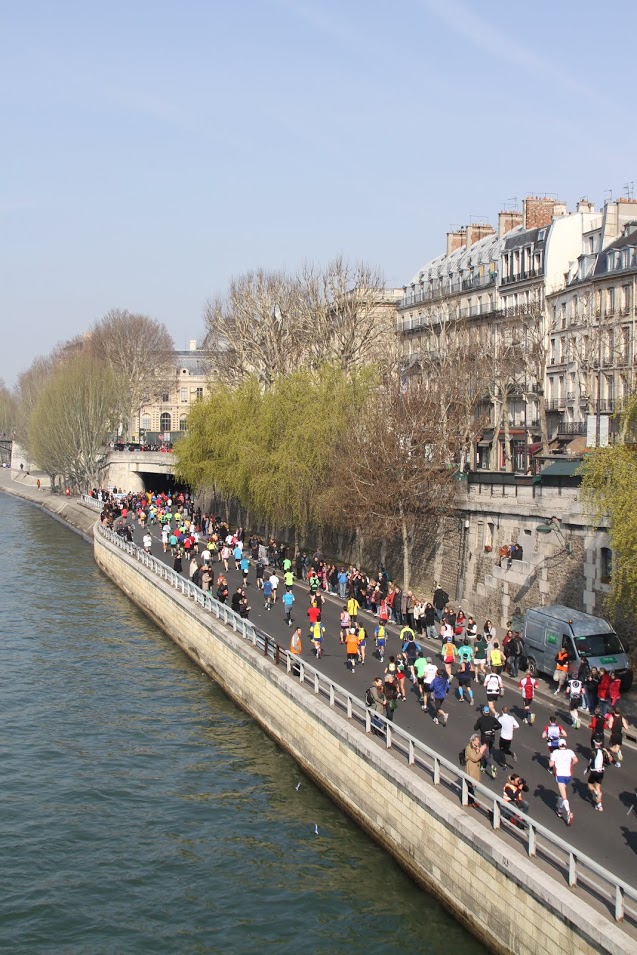
It was Sunday, a little after 8:00 a.m. I emerged from the Metro, stepped onto the Avenue des Champs-Élysées and gazed up at the Arc de Triomphe, where the 26.2-mile race began and ended. There was a palpable buzz in the air for the fifth-largest marathon in the world, a whirling electricity of nerves and exhilaration.
I felt bad for any shop owner with a toilet. Runners bunched up in droves outside bathroom doors, staring at the floor, tapping their feet as Nature called. “Sir?” a waiter asked me, raising his finger as I darted through the front door of a café. But I was already halfway down the steps, shamed a bit. I joined the long line for the bathroom, and smiled each time a flush rang out. Turns out the bladder wasn’t equipped to stow two coffees, a full Gatorade and who knows how many anxious gulps of bottled water.
As I slipped through the gate, I joined runners bunched into different start zones grouped by self-predicted finish times. I had chosen the 4 hour, 30 minute zone based on my two previous marathons where I had run 4:10 and 3:55. It was a respectable category, I thought, one that conformed to my original plan of just taking the whole thing easy. It was April and the morning air was frigid. I watched people bounce in place and blow into cupped fingers. Some folded their legs in half, stretching. Others crossed their arms and studied the pavement. Doubled-up on fleeces I rubbed my hands together vigorously.
Looking around, I felt like I had attended a Halloween party without a costume. A young man next to me wore a pink bunny suit. The man in front of him had donned a Superman costume. There was a group of girls dressed as cocktail waitresses and a group of guys in full banana suits. I saw a woman in a business suit and a man in wig; even someone wearing a 6-foot-high Eiffel Tower.
To pump us up, a spirited race volunteer stood atop a metal crate and shouted encouraging words through a loudspeaker, none of which I could understand because it was in French. Clapping and dancing to blaring techno music, she managed to synchronize hundreds into a jumping jacks routine and then a kind of collective jive, perhaps the largest flash dance in history.
Minutes later, I heard the gun fire, but I didn’t move. I couldn’t. There were literally thousands of people bunched up in front of me. I had to wait almost 30 minutes before the waves cleared out. As I crossed the start line with fellow runners shouting and holding their hands high, I witnessed the marvelous city in glorious fashion.

Ten minutes into the race I found a rhythm, happy to be warm. I took a sip of water and scampered down a hill, rubbing shoulders with runners. I circled the obelisk in the Place de Concorde then turned onto Rue de Rivoli. The Champs-Elysees opened up into five or six lanes and people began to create cushions of space. The course was flat, never higher than 200 feet and fairly straightforward. Seven miles in, I passed through the Bois de Vincennes. I was strangely okay with the fact that I still had to jog more miles than most people’s daily commutes.
The route took us by countless fountains, manicured trees, cinemas, gardens, museums, galleries and cafe after cafe. Half the fun was admiring the creativity of the spectators hugging the road. According to the race website, there were between 200,000 and 240,000 spectators present for the city-wide party.
While running, I locked eyes with a 70-year-old woman in a red and white costume. She was stomping her feet and somehow fashioning a melody with two wooden dowels. I smiled then ate an energy gel, losing myself in the musical acts and stunning architecture, the shouting crowds and the huffing and puffing of racers.
Like river logs nearing a smaller stream, the course narrowed and funneled us into a tunnel — one of many. The sun ducked away as I entered and came shoulder-to-shoulder with strangers, so close I could practically smell the mashed banana on the soles of their shoes.
Separating us briefly from the spectators, the tunnel provided a profound camaraderie, a visceral we-are-in-this-together bond between those crazy enough to run the race. I turned off my music and heard heavy breathing echo off the brick walls then mix with the slapping of hundreds of pairs of sneakers meeting the cobblestone street. In the middle of the tunnel someone let out a war cry. Another joined in, and then everyone was cheering triumphantly.
As I exited the tunnel a man passed me, his eyes fixed on his watch. Others were similarly glued to their ticking clocks, calculating their paces obsessively, watching their heart rates like an emergency room doctor monitors a patient during intubation. As the man patted his belt, holding neatly packed GU Energy Gels, I wondered what idiom consumed his inner chatter. “Don’t go out too fast,” perhaps he was repeating to himself. Surely his head phones were blasting, “Eye of the Tiger.”
I was just glad to be there. And then it happened. Something awful. I saw her. She wasn’t hard to pick out of the crowd. People huddled around her like mothers clutching infants in hopes of getting a kiss from the Pope. She was the pacesetter — a trim, perfectly athletic girl with a pole attached to her back. At the top of the pole was a flag maybe six feet above her that said, “4:00 hr.” I made the decision to pass her, and stay past her.
For my second marathon in Newport, Rhode Island, three years ago, I had somehow run a 3:55. I’m a rugged fellow and built for power, so I’ve always been into contact sports — football in high school, rugby in college. Beating the mythical 4-hour mark in Newport was a sheer display of willpower. I remember planning to “enjoy” that race also. That was until I asked an impossibly fit older man the time. “I’m on pace to break four hours,” he had said, looking at his watch. “Follow me and you will, too.” I did. And I broke four hours. I even remember tearing up as I neared the finish line, in awe that my legs hadn’t become traitorous and folded as I desperately tried to hit some “target time” for which my body had no interest.
My plan with the Paris marathon was to enjoy it, but I have a pattern for flip-flopping mid-race. As I accelerated past the pacesetter, I decided to beat the four-hour mark again; maybe set a personal best. I adopted a Spartan concentration and mumbled some platitude like, “Pain is weakness leaving the body.” I gained five, maybe ten minutes on the pacesetter and my focus intensified. But as I fantasized about the goal, Paris’s beauty slipped away. Everything slid to the periphery, subservient to the purpose, the 4-hour mark.
In a place you could spend a lifetime wandering charming streets, I was too absorbed to notice any of its gifts, off in a dream. I was absent, essentially. I also started to undervalue accomplishments like passing the half-marathon mark. As I reached this milestone in the heart of Paris, I said, “13 more to go,” and dug in.
I heard spectators shout my name because it was written on the race bib, but their voices were far away. I gave a child a high five, but the boy might as well have been a mannequin. I even ignored the Eiffel Tower as it came into view. No longer was the engineering masterpiece an iconic symbol, but rather a momentary pause from ruminations of steamrolling across the finish line better, faster, stronger.
Every 3.1 miles (5 kms) were refueling stations. Like the tunnels, they created their own bottlenecks. As I neared a station around the 15-mile mark I was overcome with conflicting desires. On the one hand, there was the primal urge to satisfy depleted sugar demands. But there was also the compulsion to waste no time. These opposing forces, when multiplied across countless other racers also hooked on achievable time goals, creates an unbelievable carnage, much like what you’d see if a fisherman accidentally knocked a bucket of chum into a patch of ocean infested with sharks.
I took an elbow in the side as an ambitious twenty-something cut and shoved his way to the start of the table dispensing food. He grabbed a handful of raisins and smashed them into his face without any sort of accuracy. To avoid much of the mayhem all one would have to do is stop at the table further down the line where it’s less populated with wild runners. But we didn’t. We were on schedule. On pace. I fell in behind the raisin bandit and snagged two bananas. I bit into an orange slice and ducked out of the chaos. As I left the station I watched runners toss plastic cups aside, almost never hitting one of the many trashcans.
It was around mile 17 or 18 when the pacesetter caught up to me. I tried to speed up, but I seized like an engine caught in second gear. My legs were shot, presumably from pushing too hard too fast. Eventually she got away from me and I watched the 4-hour flag bob out of sight. It was then that I made my second game-time decision. I let it go. I detached myself from the pacesetter and the racers around me, and, suddenly, the city of Paris came back into focus.
With over 90 musical groups on the streets, I heard music from the full orchestras to lone drummer boys; from hooligans blowing horns to slick street musicians strumming violas. And there were some characters, too, practically from a Dr. Seuss poem. There were women in blue wigs, gripping white pom-poms. Soldiers in black uniforms and high white socks. A man dressed as a butler, sipping champagne from a thin glass. Streaming from a wire across the road were 112 flags, representing all the participating countries. There were dance groups and rock bands and somehow the performances helped with the misery of it all, a shift of attention from cramping legs.
I came to another refueling station, but this time it was different. I avoided the madness at the front of the line and squeezed in at the end, non-threateningly. I saw a man cramping, so I gave him a sodium tablet and wished him good luck. I probably wouldn’t have done that with a time goal. His pain would have been invisible.
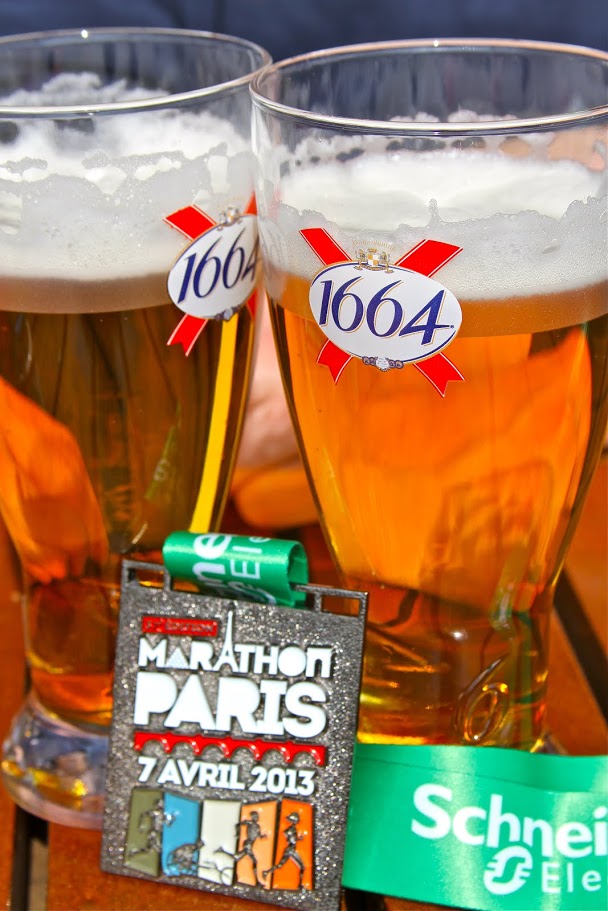
At the end of a marathon there’s no big climax, really. By definition, it’s almost anti-climactic. The last few hundred feet of the Paris marathon came down the Avenue Foch. I had hoped for the end, begged and bargained, and hoped some more. But when it came, it just came.
As I crossed the finish line I took a mighty breath and nodded to myself slowly. Others crossed with their own triumphant gestures: a fist to the sky, a single finger overhead. Though there were infinite variations to demonstrate personal glory, there was one shared sentiment: relief.
Though limping, my body was pleased not be called upon anymore, not just physiologically, but emotionally. The mind, I think, experiences the most relief, no longer subjected to extreme fixation. This relief is a spiritual one. It’s maybe why that glass of beer following such a feat is the “best beer you have ever tasted.” Because your mind is so exhausted it can’t fixate on anything but that beer. It’s too tired to run away, pleasantly captive to the present moment.
Months after the race, I learned that the refueling stations throughout the marathon had actually served cider, beer and wine, and even oysters. The race organizers had even set up a tent at the finish line for foot massages facing the Eiffel Tower. I hadn’t even noticed.

All photos by Kelly Dunbar
ABOUT THE AUTHOR
 Dustin Grinnell enjoys all things extreme, welcomes misadventures and greatly enjoys taking the contrary position in conversation. His travel pieces and essays have appeared in such publications as Verge Magazine and Narratively. He is the author of the science fiction thriller The Genius Dilemma, and has written a feature-length screenplay. He is currently a science writer for a biomedical research institute in Cambridge, Massachusetts.
Dustin Grinnell enjoys all things extreme, welcomes misadventures and greatly enjoys taking the contrary position in conversation. His travel pieces and essays have appeared in such publications as Verge Magazine and Narratively. He is the author of the science fiction thriller The Genius Dilemma, and has written a feature-length screenplay. He is currently a science writer for a biomedical research institute in Cambridge, Massachusetts.
The post Missing Paris: Running The Paris Marathon appeared first on The Expeditioner Travel Site.
]]>The post Book Excerpt: ‘The French House’ By Don Wallace appeared first on The Expeditioner Travel Site.
]]>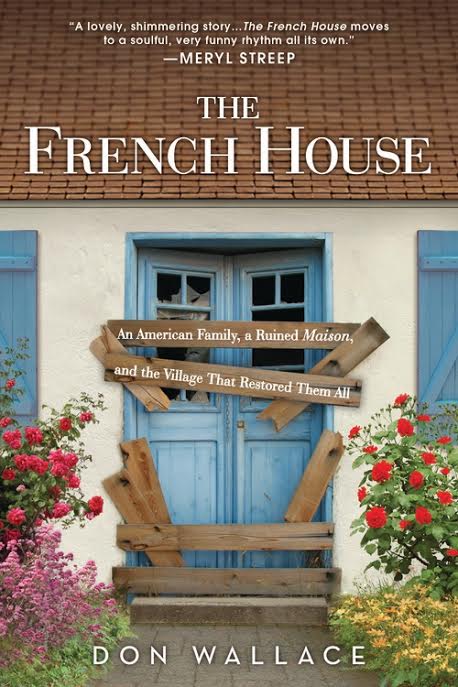
The following is an excerpt from The French House: An American Family, a Ruined Maison, and the Village That Restored Them All, by Don Wallace.
Chapter one
Far Breton
It’s another day in Kerbordardoué.
Up at eight, before the others. The sun doesn’t set until nine thirty or ten during summer at this latitude, so it feels early. Treasuring the quiet, moving like a French Country Ninja, I put on the water, light the gas stove, quietly clean off the wineglasses, dessert plates, and empty bottles from last night. I ease open the window facing the dining table. A giant flowering bush pushes inside. It has to be pushed back outside every evening, like a last inebriated guest. I inhale herb–scented air, listen to the buzz of the bees. The square is empty, the village silent, the sky pink from sun diffused through a cottony marine haze.
With a faint crunch of gravel underfoot, Suzanne strolls into view, hands clasped behind her back, trailed by a kitten. She’s in her usual blue apron over her usual blue–black shirtdress, the same outfit she’s worn every day for the last ten years, and probably every adult day of her life. The kitten dances with her heels and boxes the hem of her dress.
Suzanne moseys over to the well in the wall. Terraced sides of uneven stones form a veritable Hanging Garden of Babylon with the clippings she has inserted into the moist crevices. Her fingers fuss, tamping and fixing. She plucks a few live shoots to tuck into her apron pockets and transplant elsewhere. Then, hands clasped behind her back, she continues her promenade up the lane, past our door, eyes sweeping the flowers and shrubs along our thin verge of garden, most of which she’s planted and tended when we’re away, back in the States. If she were to raise her eyes, she’d see me. But like most older Bellilois, she tries not to look into windows or open doorways. Or at least if she does, to not get caught.
A hiss from water spitting from the pot breaks the spell, sends me back to the stove. She probably knows I’m watching, anyway.
Tap–tap–tap. Work has started somewhere. Peering out through the lace curtains on our door’s window, hand–knitted by Suzanne, I spot a close–cropped head rising above the tile roofline of the tall A–framed cowshed across the square. Rolling a dozen nails between his lips, Loup slides slates into place and tap–tap–taps. Another slate down, nine thousand to go.
A well–muscled guy with a large tattoo of his German shepherd on his bicep, Loup is single–handedly rehabbing the long, narrow building. He’s restored the exterior walls to simple drystone glory, a seventeenth–century skill he had to teach himself. He’s ripped out the cow stalls and laid a floor of antique salvage oak, then an upper story where once swallows nested and shat. I’ve seen the future of the cowshed and it’s gorgeous: a building that sat ignored and decaying for forty years will soon be mistaken for an elegant village relic. Parisian women will set their snares for Loup, only to find themselves flustered and outsmarted by his first love, work. Meanwhile, one more blackened tooth in Kerbordardoué’s crooked smile will be restored.
Clad in chic powder blue running togs, the blond wife of the Unforgiving Couple steps out into the square and does a quick set of bends and stretches. Fifteen years ago, the couple bought the empty lot across from us, a field of weeds spanned by rusted arches of iron that formerly supported the roof of a barn. Mindy and I took the loss of our view—-a blue line of sea—-stoically. One day the arches would be attractive hazards for our son and the village children, we thought.
But before we could meet the couple, they submitted plans for a three–story McMansion to the Mairie de Sauzon, or mayor’s office. Once enough people had taken a look and gagged, Gwened the Archer led a charm offensive. The couple blew her off. Gwened took our protest to the Mairie de Sauzon, who dismissed her as a mere second–home owner, even though her grandfather was from Belle Île and she had been coming here her whole life.
When she informed him about the regulations on the books and how they forbade a third story, he patronized her. That did it. Gwened went door to door with a petition, the first, some said, in island history. About half of the second–home owners signed it, but not us—-Gwened felt having un étranger Américain would backfire. The Bellilois elected not to sign: such is the strength of feeling here about imposing one’s opinions on others. When Gwened returned to the Mairie, he shrugged. Madame, we have never been presented with a petition and this is not the time to start.
That left the fate of that lot to our village’s widowed matriarch, owner of the surrounding fields. No way the stern and reserved Madame Morgane would sign anything so forward as a petition, but she agreed to go to the post office, which was next door to the Mairie de Sauzon, who happened to be in, with his door wide open to the street. Naturally he greeted her. A conversation took place. The subject almost didn’t come up. Then he scoffed at all this foolishness. She replied that the new house would be “too tall.”
Too tall? The Mairie frowned. The first plan was rejected. A second came in with two stories—-but enormous glass walls. This was actually easier for the Mairie to reject. There are laws against that sort of thing. Belle Île enjoys national heritage status, which specifically covers home construction and renovation.
The couple responded by building a house without any windows facing the square, which was fine with us once some ivy grew up the blank white wall. In fifteen years, I can’t remember them once waving hello. It’s really too bad.
Oh, well. They don’t come from here. They don’t even come from somebody, as the political machine hacks say in Chicago.
At least we come from “somebody” — and gratefully. Gwened. She lured us here—-invited us to Belle Île when we were reeling around Europe fifteen years ago, our dream of living and writing in Paris having come undone. Mindy had been her student long before, in the campus abroad program where Gwened taught. Gwened had offered us her house and ended up changing our life.
The wife runs off, hippity–hop, classic le jogging style. Spooning out black mounds of cheap supermarket coffee, as good and aromatic as any of the expensive beans I noisily grind in our kitchen back in New York, I pour the boiling water into a cone filter wobbling atop a brown pot hand–thrown by our Scandinavian potter neighbor. Suddenly a voice echoes in my head: My very own randy Dane up the lane…
It’s my sister’s joke, from her visit a year ago, and a bit unfair—-though the potter certainly did trail Anne around his atelier in the fields. What a view to a seduction he had: fat yellow heads of buckwheat bending to the breeze, then a dark dense green windbreak of cypresses, and after that, the wide, glittering blue–steel sea. The Atlantic. Pure horizon.
His tanned fingers kneading Anne’s arm, finding more muscle than expected, he cried out in English: “But you are strong!” Excited, as if imagining her churning butter on his Viking homestead, walking behind the plow, a baby crooked in each arm.
“Merci,” she said, mustering all her French. With a flutter of her eyelashes she pulled away. “Unfortunately, we really must be going.”
“Just think,” Anne sighed that day, after we rode away on our rickety bikes, the potter waving forlornly to our backs. “If I ran away with him, we could live in adjoining villages and pay each other visits at teatime.”
“That would be nice,” said Mindy.
“We could have Earl Grey in cups made by my very own randy Dane up the lane.”
“Anne!” Mindy shrieked. Et voilà! The quip attached itself to the pot like a superfluous handle.
Mindy always says Anne is the sister she never had. They laugh together, joke together, surf Huntington Beach’s Chair 16 together. But we don’t see enough of her. Since at different hours of the day Anne is a mother, a wife, a stepmother, a daughter, a schoolteacher, a golf teacher, and a writer, I’m sure nobody sees enough of her. Living on opposite coasts doesn’t help, which is our fault for moving to New York City.
As I sat there, watching the coffee drip into the brown potter’s cups, I missed my sister and considered how hard that trip must have been for her. Getting Anne over here is a project of ours. She’s chafed at living in our hometown all her life. Once or twice she almost left, but for some reason at the city limits, life always pulled a U–turn.
The first time she was about to make her escape from Long Beach, on a yearlong surf safari down to Mexico and South America with her boyfriend, the car broke down on the freeway on–ramp. Our parents came down hard on the guy, and they broke up. Before I even heard about any of this, she was engaged to the son of our father’s business partner, who proposed, I think, on the golf course. Anne had two young kids before the marriage went bad. She might have gone south to make a new start, but in the same week she was diagnosed with stage IV throat cancer. Divorced and healed up after miracle surgery and radiation, she found a man. He wouldn’t commit.
Then the current one came along, a carpenter who surfed and read The New Yorker. Ideal, right? She married him. But already there were strains. Anne’s teenaged daughter was acting out big–time. And, underlying everything, a deeper tension rattled my sister’s confidence. She’d confided to me that she’d glimpsed the pattern of her life and vowed that, no matter what, she’d bust out one day, if only to Seal Beach, just across the county line.
As I was helping Anne to engineer her escape to Belle Île, I fed her air routes and plans for her whole family to come. Circumstances combined to whittle it down to just her and her son. When she hesitated, I supplied rationales for a vacation from the tempestuous daughter, the teaching job, the old dog, cat, and plants—-oh, yes, and from her husband’s three kids on alternate weekends. She definitely needed a break, I argued. And successfully.
But what I didn’t realize was how selfish that was. All these people loved her and had legitimate claims on her. I was beginning to see I really wanted her to validate Belle Île for me. I wanted to see Belle Île through her eyes. And to watch her fall in love with it. After so much family criticism over our coming here, of all places, rather than closer to home in California, I wanted to see her pick up on the way the island was like all those idyllic Pacific coves and beaches we knew when we were children, before the bulldozers and housing tracts. Like those places, but better. I wanted to give Anne this, and then surely she’d do as we’d done—-make every effort to return every year.
Belle Île was already Mindy’s and my alternative base from home, established over the protests of our families. Now, like every breakaway republic, we were recruiting, and because Anne was the shining light, the radiant one, among the Wallaces, I’d introduced a conflict of loyalties, forcing her to choose between us and the rest of the family. She saw it. I didn’t, not yet.
Once I got my wish and she was here, of course Anne would be Anne. On her third day here last summer, she watched me prepare for a picnic with the kids at the Hidden Grotto of Swimming Lizards. “I want to play that thirteen–hole golf course,” she said. “Sarah Bernhardt’s golf course. The first course started by a woman. I can sell a story about that to Golf for Women and pay most of my expenses here.” She tossed her head back and laughed, as if feeling the fingers of the wind coursing through her hair. “You can write one, too, Donny. And you, Mindy. We can make so much money and expense dinners at the Hôtel du Fart.”
*
“Du Phare,” corrected Mindy, laughing at Anne’s wicked mispronunciation of our island’s most picturesque restaurant. “Pronounced far, meaning lighthouse.”
“Wait! Then what’s that dessert we had at Hôtel du Pharrrrt? ”
“Far Breton.”
“Lighthouse cake?”
“Noooo…”
Anne was having such a good time mangling the language that it actually made me jealous. Normally that was my gig. At dinner at the Hôtel du Phare she’d feigned confusion at every menu choice, fruites des mer becoming “fruit of a female horse” instead of a seafood plate and so forth, ending with the rubbery egg and prune concoction called “Far Breton.”
“Wait—-how can phare be a lighthouse and far a cake?”
“One word is French, the other Breton,” I explained.
“Well, I think that for you, Far Breton means ‘sweet distance,’” she replied curtly.
Snark from Anne was a surprise. “Meaning?”
“You didn’t just go for the Far Breton,” she said mock accusatively. “You went for the Far, Far Breton.”
“Look, I like Long Beach.” Our hometown.
“Funny way to show it, going ten thousand miles away.”
“Only five. Look at Mindy. Hawaii’s even farther.”
“Far, far, far.” Anne shook her head. Message delivered: we were too far away. Though I still didn’t know from whom, I could guess: Mom.
But, being Anne, she immediately deflected the point of the barb toward herself. “And I still can’t get out of Long Beach.”
This actually caused a pang of remorse. I felt she’d read my mind, that she thought that I thought she’d missed out on life. Stuck in the old hometown, repeating herself. I couldn’t reply.
*
My morning reverie comes to an end when our eleven–year–old, Rory, and David, Anne’s son, tumble downstairs and briefly struggle over which of the deep wicker chairs to sit in. There’s no difference, except for a matter of placement. The far end of the table is the prize. Mumbling good morning, they attack their waiting cups of hot cocoa and Krispy Rolls “Suedoise”—-a kind of Swedish hardtack.
But all is repetition here, too, I should’ve protested to Anne. If only she had come this year, too—-but, instead, she sent her giant teenager to eat us out of house and home. Fortunately, we love Devo, a six–foot–four high schooler. Even better, he came bearing an envelope of cash with “Feed Me” written on it.
Mindy has been upstairs for a while, writing in her journal. Now she comes for her coffee and Krispy Rolls. We have only a few scrapes of blackberry jam left in the jar but plenty of butter. Only in France do we put butter on bread. There’s no point in trying it in the States; I’ve tried, and it doesn’t taste anything like the incomparable beauty of French beurre.
Crunching and sipping, the boys lean over the chessboard and begin setting up the pieces.
“No!” shouts Mindy. “No chess until you make a surf check.” Mindy can’t plan her day unless she knows whether there are waves.
“Hmm,” says Devo. “No surf check until checkmate.” He moves his pawn.
“No lunch unless you make surf check. Chop–chop! Now!” Mindy claps her hands loudly. Yesterday the boys started playing a game and didn’t leave the house until early afternoon. This plays hell with our schedule, such as it is. The threat of no lunch usually works. When it doesn’t, and we abandon the boys to their own devices, there is a definite danger that the house won’t be there when we return, due to the combination of Devo’s appetite and the stove, knob-less after several explosions.
“Your move.”
“I’ll make you an omelet if you check surf now,” Mindy pleads.
“Hmm. What kind of omelet?”
“Chorizo and tomatoes and Gruyere.”
“Okay.” Devo looks at Rory. Then, with a crash, both shove their chairs back and race for the door. There’s a struggle at the handle that Rory loses, being a foot shorter and seventy pounds lighter than his older cousin. But he’s faster and arrives first at the bikes leaning against Gwened’s barn. One bike’s chain slips; the other doesn’t. Another struggle begins.
“Peace at last,” I murmur. “More coffee?”
“Sure. And an omelet.”
“Hey!”
“I want to write while it’s quiet. Everything is so noisy here.”
This is a slight exaggeration, considering that in New York City, garbage trucks groan and drunks sing and clubbers fight and hookers hook and then swear at each other under our windows from midnight to dawn. But everything is relative. I understand that.
Through the window I see the boys whiz past down the rutted lane. I grit my teeth and wait for the crash at the bottom turn. Nothing happens. Good.
A surf check means we have at least twenty–four minutes of peace—-nine for the boys to pedal madly up the road, take the shortcut across the fields, descend the treacherous dirt lane to the paved road, pedal madly up to the turn to the village of Kerhuel, pedal madly through Kerhuel dodging free–range chickens and sleeping dogs and one–eyed cats, then pedal madly to the cliff and the overlook. You can’t do an honest surf check from where the road ends, so they’ll have to run to the cliff edge, which takes three minutes. We’ve charged them with providing specific answers to our questions, so that means at least two minutes watching, though we’d prefer ten. The return trip is a bit faster, involving less uphill.
“Maybe we have time?” Mindy nods at the stairs and arches an eyebrow.
“Well…” I check my watch. “Twenty minutes.” We look at each other, counting off the seconds. Once the boys made it back in nineteen. We trade glances: too risky. Not relaxing.
“Okay,” Mindy says. “Make sure they rinse their feet at the door.”
Back to the stove I go. Chop garlic and onion, slice rounds of hard Spanish chorizo, the Don Moroni brand that I smuggle back to the United States each year. Diced green peppers and tomatoes also go into the skillet. While they’re cooking, I crack six eggs into a bowl, add some milk, and stir.
Spatula in hand, I drift over to the front door, open it, and stand barefoot on the concrete stoop, worn by weather and summer feet. Pushing through the billowing hydrangeas that mask her patio and front entrance from the square, Gwened emerges holding a paper high in the air.
“Oh, Don! I have a letter from Daniel!” She’s wearing a simple floral frock with a scooped neck that shows off her deep tan, cleavage, and a gold orb on a chain that dangles there. On her feet are the rope espadrilles that Gene Kelly and Bridget Bardot made famous. You can always rely on Gwened for a fabulous entrance.
She switches into French for my daily grammar workout. We talk about Daniel, her son who lives in the United States. He’s found a job doing art therapy at a hospital. Life is good. His wife is trying her hand at writing articles for a newspaper. Will I correspond with her, pass along advice and encouragement? Of course.
Recalling my duties at the stove, I dash in to slide the sautéed vegetables onto a plate and pour the beaten eggs into the skillet. Gwened waves and moves on down the lane, letter in hand. I suspect she will stop at Suzanne’s plain stone house. Then, if Le Vic is out sunning himself while his sons and wife garden, she’ll pause at his white picket fence for a chat, then sweep up the road to Madame Morgane’s.
That is, if she doesn’t do a quick hook around to the house of the Accomplished Academics. Yes, she’ll go there. Their daughters are wonderful musicians, budding professionals whose violin and viola sweeten the air all summer. After that, it’s on to Celeste and Henry, the village psychiatrists. (Freudian.) Yes, Kerbordardoué is a full–service gossip stop for anyone, but especially empty–nest parents like Gwened. We’ve got everything you need right here.
*
As Gwened moves off, letter held high as a flag, I smile. If only my Anne had seen her like this, she wouldn’t have been so suspicious. “Tell me more about Gwened,” Anne had demanded early in her visit. “That’s her house above ours? She’s the one? The reason you’re here? You said she’s a professor. What else?”
“She’s a witch,” I said.
“No! Not really.”
“Mom believes she tried to seduce Dad with some kind of potion.”
“What? I can’t believe this! Mindy—-Donny’s making this up, isn’t he?”
“She was doing some kind of witch thing,” Mindy confirmed. “Right in front of your mother, she was casting a spell. And he really was falling for it.”
“I can’t believe it! This is so bizarre! How did she cast a spell?”
“Near the end of the trip, your dad cut his leg in the hotel swimming pool, and it got infected. Gwened noticed when we were having aperitifs. So she went over to her well and pulled out a handful of this slimy green moss and made a poultice out of it. Put it on his shin.”
“You’re telling a story. You’re both making this up. Donny? Is Mindy telling the truth?”
“All I can say is, it really did feel strange. I couldn’t believe it was happening myself. Gwened was chatting away in this very lulling voice, and Dad had this big smile on his face. He couldn’t take his eyes off her.”
“He couldn’t take his eyes off her boobs, you mean,” said Mindy. “She kept bending over right in front of him. She found a way to pop a button.”
“You mean he was falling for it? Dad? Nooooo! ”
“Women have their ways.” Mindy looked wise. “French women especially.”
“I think she scares me a little,” Anne said with a little shiver. “And I can’t wait for her to come to dinner tomorrow.” Laughter. “What will you guys cook?”
“Lotte, tomatoes, green beans, chorizo, zucchini, green salad, goat cheese.”
“Ooooh. Donny, where did you learn to cook?”
“I always cooked. In Boy Scouts, in college.”
“Not like this. I tasted your cooking in Santa Cruz. So where was it?”
“Here.”
“Who taught you? Gwened?”
“No…” Anne kept staring at me, so I shifted in my chair and started over. “I guess I started tasting food, really tasting, when Mindy first brought me to France. First tasting, then really paying attention to ingredients, then practicing in New York. One month in Belle Île, then the rest of the year trying to duplicate recipes, tastes. You can find anything in New York. Well, almost. I haven’t tasted a good American peach for years.”
“This is so amazing,” Anne said. “You know, it’s a whole world you have here. I want to spend more time here. Can I come next year?”
“You’d better!” Already, though, I had my doubts.
The boys are back, pulling up on their bikes to shout through the window: “No surf !”
“You’re sure?” I ask. “Who was in the water?”
“Nobody.”
“Will you be quiet, please?” calls Mindy from the dormer above.
“Sorry.”
“I’ve been going crazy listening to your mangled French all morning, discussing the most incredible banalities under my window.”
“Time to feed the Mommy,” I say to the boys, loud enough so Mindy can overhear it. To feed Mindy means dividing the omelet—-to Devo’s dismay—-then cutting bread and setting out little goat cheeses from my friend the cheese lady, who appreciates my French. Tomatoes and lettuce, oil and vinegar. At the foot of the staircase I call: “Lunch!” It’s only eleven o’clock, but food fuels good humor as well as activity.
And we must have activity.
The boys lay out their spear guns and masks and wet suits, talking of the fish they’ll hunt today when we finally head out. They eat, then resume the chess game. Time stops. I grab a book and sit out on the thin ledge of concrete that runs along the base of the foundation, toes in the grass. Bees buzz around. Swallows dip and nip midges. An hour passes. The king is trapped, the game resigned.
“Let’s go!” shouts Rory. We fill the bright Duty Free and striped Lancôme gift bags, now redolent of salty fish guts and sand, load a straw bag with towels, a thermos of hot tea, cookies, a Wiffle ball and bat, the Herald Tribune.
At the last second, Mindy joins us and insists we strap her surfboard on the roof rack. The old Renault turns over, smoking and shaking. As I work the choke in and out and feather the gas, the bright car of the movie starlet who lives at the top of the lane creeps out from between the hedges. She’s got her Garbo goggles on and a Japanese Red Army Faction head scarf, right out of a Godard film (which she hasn’t been in). Her blond daughter, Rory’s age, is nowhere to be seen, thank heavens. Or maybe that’s a bad thing—-we have to keep an eye on her. She grew up in Hollywood, and there’s a touch of Lindsay Lohan in her tempestuous nature.
Once the movie star is past, I can back up and point the car’s nose down the rutted lane. Staggering, blowing blue smoke, we scrape between Suzanne’s massed hydrangeas. The blossoms beating against the windows remind me of cheerleaders waving their pom–poms at football players as they emerge from the stadium tunnel.
Twenty feet later, the car stalls in front of Le Vicomte’s. “Rick” and Yvonne are sitting under an umbrella playing cards in cardigan sweaters and flannel trousers, while one bare–chested son, Thierry, smokes a cigarette and stuffs weeds into the flaming open hearth of a roofless sixteenth–century ruin. Everyone waves and offers salutations as I try to start the car.
Eventually we crawl up the road through the tunnel of trees. Madame Morgane scuttles away up her drive, her daughter–in–law going
the opposite direction to her own house. We exchange nods. At last we’re through the gauntlet and into open fields. But here comes an oncoming car. It’s Pierre–Louis and Sidonie, another psychiatrist couple—-Lacanians—-who live ten villages away from us. Stopping alongside, chatting through open windows, reaching out for a handshake, we make plans for an aperitif the following day and drive on. We’re getting there.
“God, it takes so much time to do anything here!” Mindy shifts irritably in her seat.
We take a left turn and run past the former surf shop, now reverted back to a cottage, the half–pipe gone where skateboarders used to practice roller coasters and rail grabs. We pass the house of the lawyer for the Big Important Newspaper, hidden by a dense palisade of tall straight Norfolk pines.
After a switchback series of turns into and out of dirt lanes and paved roads, passing the estate of the Majestic Madame Who Fought in the Resistance and Survived Auschwitz, we reach the stark “Village of Merde,” as we privately call this windswept cluster of houses, and slo–mo slalom around cats, ducks, chickens, a hog, several small children in Wellingtons splashing in lakes of animal shit, and finally a string of horses and Shetland ponies, all saddled up and ready to go. Poney Bleu à votre service, Monsieur et Madame! Stages, randonnées, promenades…
“Surf check,” Mindy says at the next crossroads. The boys complain, but they sound guilty. They probably blew it off this morning. Then again, boys always sound guilty.
Past some hunched–over whitewashed houses, once again in open fields, we carefully overtake cyclists and the occasional oblivious couple pushing a baby carriage in the middle of nowhere. And there’s Dede, pedaling his old clunker. The proprietor of the village, he is a large man in blue overalls and Wellingtons, huge head tucked into a newsboy’s cap, tin pail in his hand, going blackberrying on his lunch hour. “What’s for lunch?” asks Devo. Because it is, incredibly, lunchtime again.
The road dead–ends at the old ramparts of a fort, either Roman or Celtic, later repurposed by Napoleon and tweaked again by the Germans during the Occupation. Now it’s just a grassy ring by a graveled car park. At the cliff’s edge, we look down on Donnant, the most changeable beach in creation. After a minute Mindy decides she’s staying to see if the tide will bring a bump to the thin, glassy waves. She unstraps her yellow board and shoulders her backpack with towel, wet suit, second lunch. Down the cliff she goes on a narrow rock ledge, sure-footed on her wide–splayed toes—-luau feet, they’re called in Hawaii. Below on the glitter–green sea a couple of our surf crew float on their boards, talking.
With the mommy gone, the car goes tribal. Devo takes shotgun and slaps the venerable cassette into the car stereo. There’s only one song for going spearfishing: “Stand!” by Sly and the Family Stone. Heading down the corrugated dirt road with dust boiling in our wake, we sing at the top of our lungs while I pump the brakes in time.
Today’s dive spot is a rocky fjord with a beach of round stones. Ten feet out, a subterranean stream creates an underwater freshwater spring over a sand bottom. Thick kelp stalks swing in the slow pulse of swells. Once the boys signal that the water quality is good, I take off on foot up a narrow trail and follow the shattered cliff edge of the Côte Sauvage back toward Donnant. I bring my swim fins in case there is surf, but one look at Mindy and the crew floating on their boards is enough to keep me high and dry.
Walking back to the cove on a rabbit trail, I feel the sun drawing near and discharging great ripples of heat over the moor. Spongy mossy knobs under my feet sprout little red and blue and white flowers, and the gorse flares yellow. Even the thorns shimmer invitingly. When I reach the cliff overlooking the fjord, the boys are directly below, swimming slowly about a hundred yards from the rocky beach. They dive, cruise deep, surface with snorkels spouting.
Climbing down, I take up a place on a flat shelf of rock that isn’t too uncomfortable, lie back on my towel, and open my newspaper. Every few minutes a shout goes up, Rory and Devo devising tactics to drive their quarry into the open. I nap. When I open my eyes again, a fat, lime–green fish impaled on a spear is being thrust at me by a creature wearing a glass mask, with lips blue and teeth chattering. Fish and boy look remarkably alike.
*
So far the dive at the fjord has resulted in the single vieille, a soft–bodied rock cod of no great taste. I’ll need to supplement it with another fish, so a visit to Sauzon, our nearest town, is in order. I’ll have to fight the crowd at the quay when the boat comes in. The prospect makes me savor the Herald Tribune, squeezing every last drop of useless information out of its twenty–two pages. Financial tables, European soccer news, Italian politics—-as long as it is in English, I’ll read it.
Eventually the boys tire and strip off their wet suits and drape themselves over hot rocks. Then we load the car and shudder up the dirt road, over ruts like small canyons. I drive back to the old ramparts and we head down the cliff, only to find Mindy freezing and ready to leave. The thermos of tea and a slice of bread and cheese revive her. She decides to walk up the valley to the village to warm up and enjoy a quiet house. The boys join a loose gang in kicking a soccer ball over the long, wet sand flat left by the ebbing tide. A game starts.
The French lunch hour is over. People appear at the gap in the sand dunes where Les Sauveteurs en Mer have constructed a wooden stair. The families carry folding chairs, tents and sunshades, parasols and rubber boats. Babies cry; young people run, scattering sand. The tap–tap of endless paddleball games begins. Lifeguards stroll up and down in their bright emergency orange vests and Speedos, carrying waterproof walkie–talkies and swim fins clamped under one armpit. The elegance is itself reassuring.
It’s now or never for me, so I grab my fins and start down to the water, wishing Rory, Devo, and I could rethink our pact to never wear wet suits when bodysurfing. The water temperature is 61 degrees! Oh, the things we do to impress our kids and teach them the proper hardiness…
Of course, I want to impress the French, too. Show them we are true Americans, Californians, Hawaiians, endowed by our creator with a superhuman ocean sense and testicles that shrink to the size of raisins in the icy temps. Mustn’t let down the side. With a shudder, I push into the first ankle–high waves and begin the slow slog out to the impact zone a hundred yards offshore.
Forty–eight minutes later, I emerge to find half the village lounging on the hot sand. People leap to their feet to kiss my cheeks (and wince at how cold they are): Celeste and Henry, our village psychiatrists; Sidonie and Pierre–Louis, the psychiatrists from ten villages down; Yvonne, wife of Le Vicomte; and a handful of friends visiting from other villages or Paris. Gwened lies on her towel a discreet thirty yards away—-like Mindy, she prefers calm and quiet, less of a rhubarb, one of those quaint English words that has never lost the ability to provoke laughter in France.
The soccer game breaks up and the boys of several villages crash the circle of towels, plundering sacks of cookies: Le Petit Ecolier, Sablés Beurré Nantais, and the chocolate–and–orange–zest–covered marshmallow domes whose name we never tire of saying: “Goooters.” Girls scoot their towels closer, joining the circle. A couple of the older teens light up cigarettes, drawing eye rolls from the adults—-except for Sidonie, who turns to a fifteen–year–old.
“May I bum a smoke?” she asks in English, deadpan. Looks at me: “Bum is correct, Don? It eez not ze same as ass, no?”
I nod, but Celeste’s husband, Henry, wags a finger. “No, ze bum is ze ass, but only for ze Anglais. Yes, Don?”
“No, Henry,” I reply. “One must not forget that, pour les Anglais, ze ass is ze arse.”
Sidonie’s husband, Pierre–Louis, smacks his head. “Oh, but of course! Ze arse Anglais.”
The kids blush, trying not to look shocked but totally flustered. The cigarette pack goes back into a purse. Score one for the psychiatrists. Everyone cackles, trading double entendres, and an hour passes in beach blanket Babylon: French people trying to speak English, French teenagers practicing American rapper slang with the American boys, and the lone American adult addressing men as women and women as men and referring to himself as both—-a psychiatrist’s idea of heaven, for sure.
A football comes out and the boys began throwing and catching, moving ever closer to the sea. At their gestures, I heave myself up and join them—-activity, we must have more activity! Running brings the heat back into my limbs. Another hour passes.
Even at four o’clock the sun is bright, high overhead, but by French rules it’s getting late. People pack and drift back through the dunes to the parking lot. Just as I’m wondering what to do about dinner (I’ve missed the boat at Sauzon), Mindy comes across the sands carrying a straw basket filled with salami, apples, baguettes, beets in vinaigrette, and an oval fresh–baked cake.
“Hmm,” says Devo, eyeing the cake. “The chocolate football.” Another hour passes. With Mindy here, the conversation switches back to French, too fast and subtle for me to do more than nod and smile.
The crowd at the beach thins out. The twenty or thirty who remain scattered over a half mile of sand and rocky cul–de–sacs are revealed as a class: lovers and beachcombers and a few Bellilois come for an after–work plunge. We know quite a few. We are all thankful that, at this hour, discreet waves of the hand may be substituted for the usual getting up, going over, and kissing.
A loud air horn indicates Les Sauveteurs en Mer are going off duty. True lords of their domain, they receive salutations as they stroll up to their shed. Henry and Celeste and Sidonie and Pierre–Louis say they must go. We decline offers to join them for an aperitif and they don’t press the issue, knowing from long experience and surprisingly earnest debate that at certain tides, we simply will not leave the beach.
Our village rises as one, gathering towels and heading up through the dunes and into the grassy valley. As they go, they pass the next shift arriving: local surfers coming for the evening glass–off. Soloists scramble like goats down the cliff, boards snug under one arm and already in their wet suits. Others with families march up the sandy throat of the canyon loaded down like Bedouin caravans.
It is seven o’clock and I’ve been outdoors for five hours. Yet this is when the real action begins. The tide is coming up, and the little bump of this morning is now a swell with two distinct lines in the middle, a point break at each side caused by the rock islets that bookend the beach, and even a decent shore break where the kids with bodyboards go wild. The surfers are mostly Bellilois, with a few regular summer visitors. The lifeguards come down and join us, shedding their orange vests. Everybody in the water!
I join Rory and David and Celeste and Henry’s son, Marc, in the bare–chested bodysurfing brigade. We duck dive and kick under the onrushing white water. Eight minutes later, we’re on the outside looking in, floating on the heaving Atlantic with the cliffs and golden sand dunes glowing in the evening sun. An hour later and we’re still there, plus or minus a few friends who’ve come or gone, giving and taking waves.
The sun sinks slowly, yet I’d swear the water feels warmer. It’s because of the waves, of course—-our engine rooms are stoked by the constant kicking, diving, stroking, and best of all, the adrenaline rush of sliding down the steep faces. Sluicing along in the concave half–pipe of green sea. Making section after section, passing your friends paddling out, hearing them hoot.
I gather myself at the peak of a large swell. As it starts to topple forward, I slice down on my chest and angle for the heart of the tube. Inside, for a moment, all is quiet and hissing, then the walls implode. The breaking wave takes me into an underwater world that alternates from light to darkness, rolling me and spinning me. My heels strike the sand bottom a good ten feet deep as the wave plunges silently past, like a waterfall. A hard hold–down, followed by a twitchy release from the ocean’s coils that says: Okay, I’m done with you, for now. Just don’t try that again.
Far inshore, on the beach in the advancing shadows, I can just make out specks of people walking the beach. The after–dinner contingent has arrived. And still we linger.

/
 Don Wallace has written fiction and non-fiction, journalism, films, reviews and opinion pieces, even the odd poem and song. He writes about a number of diverse environments: France, surfing, military history, business and entrepreneurs, the boating world, bass fishing, high school football, civil rights and Hawaiian music.
Don Wallace has written fiction and non-fiction, journalism, films, reviews and opinion pieces, even the odd poem and song. He writes about a number of diverse environments: France, surfing, military history, business and entrepreneurs, the boating world, bass fishing, high school football, civil rights and Hawaiian music.
He has been a magazine editor at Time Inc., Hearst, the New York Times, and Conde Nast and was most recently Film Editor at The Honolulu Weekly. From Long Beach, California, he attended Long Beach Poly, UC Santa Cruz, and the Iowa Writers’ Workshop; with his wife Mindy Pennybacker he lived in New York City for 27 years before returning to Mindy’s native Honolulu in 2009.
The post Book Excerpt: ‘The French House’ By Don Wallace appeared first on The Expeditioner Travel Site.
]]>The post Explore Paris Through Art With Your Phone appeared first on The Expeditioner Travel Site.
]]>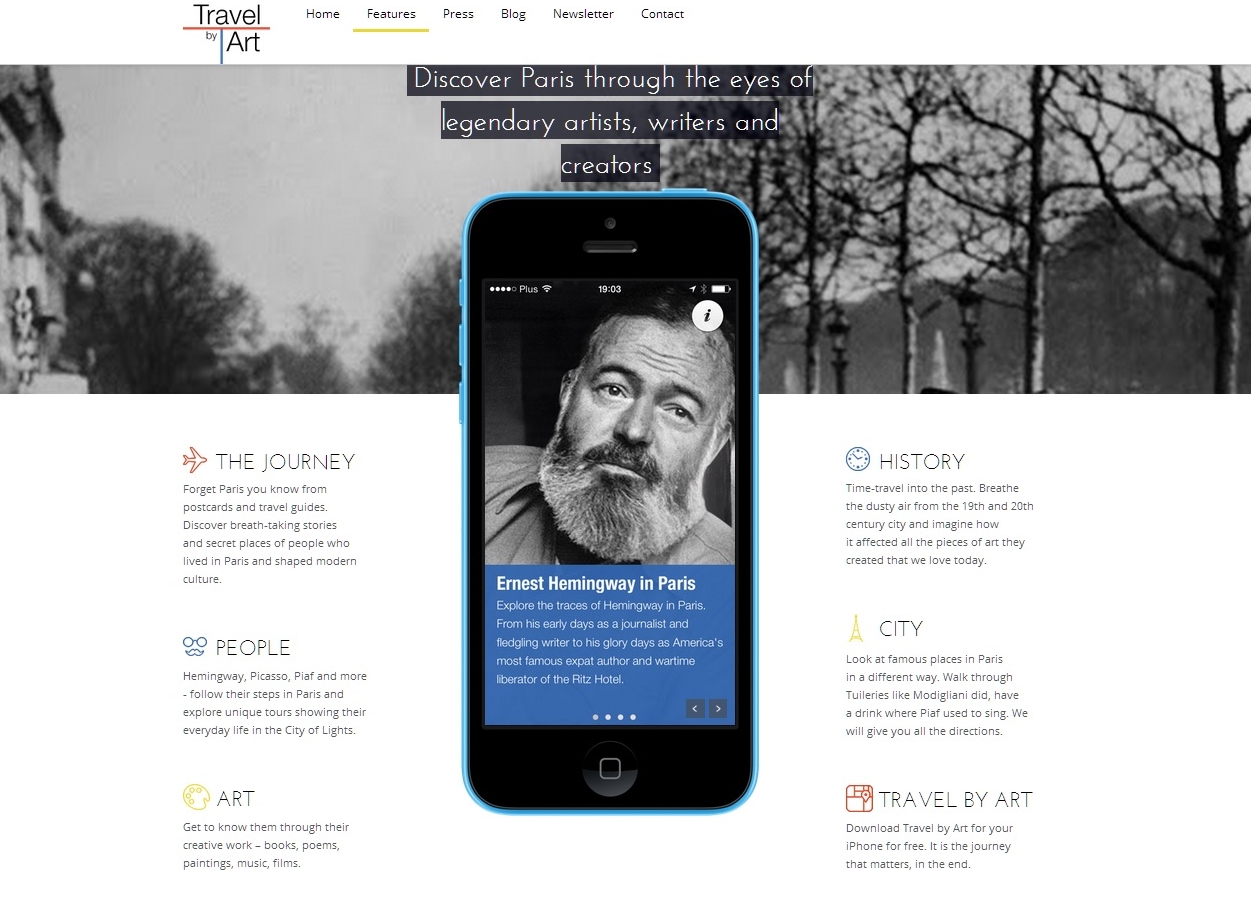
Here’s a great new app for those heading to Paris this year. TravelbyArt is a new iPhone app that lets you discover Paris through the eyes of the city’s legendary artists, writers, singers and composers of the 20th century, with twenty curated tours that reveal the important places in the lives of such artists as Ernest Hemingway, Pablo Picasso and Edith Piaf.
TravelbyArt guides the users to dozens of places in Paris where the artists lived, the studios where they worked, and of course, the restaurants and bars where they ate, gathered and met friends. Each location has its own mesmerizing story, enriched with multimedia content including excerpts from books, audio recordings, famous art works and photos. In addition, the app allows users to get to know the artists’ stories through a chronological feature that allows the user to explore, date by date, the lives of the artists.
The app also includes easy-to-follow offline maps in case you’re not using the local phone service and are relying on Wi-Fi only.
“We have been working tirelessly to make TravelbyArt app a first-class mobile travel experience. This unique approach, to follow in the steps of great artist, allows one to see Paris in a completely new way. I hope this method of time-travelling will be appealing not only for Hemingway or Picasso fans but also for everyone interested in modern culture,” explains Beata Misiewicz, the founder of TravelbyArt.
You can download TravelbyArt for iPhone for free from the App Store by searching for TravelbyArt or by clicking here.

/
 Matt Stabile is the founder and Editor-in-Chief of TheExpeditioner.com. You can read his writings, watch his travel videos, purchase the book he co-edited or contact him via email at any time at TheExpeditioner.com.
Matt Stabile is the founder and Editor-in-Chief of TheExpeditioner.com. You can read his writings, watch his travel videos, purchase the book he co-edited or contact him via email at any time at TheExpeditioner.com.
The post Explore Paris Through Art With Your Phone appeared first on The Expeditioner Travel Site.
]]>The post 6 Books You Must Read Before Going To France appeared first on The Expeditioner Travel Site.
]]>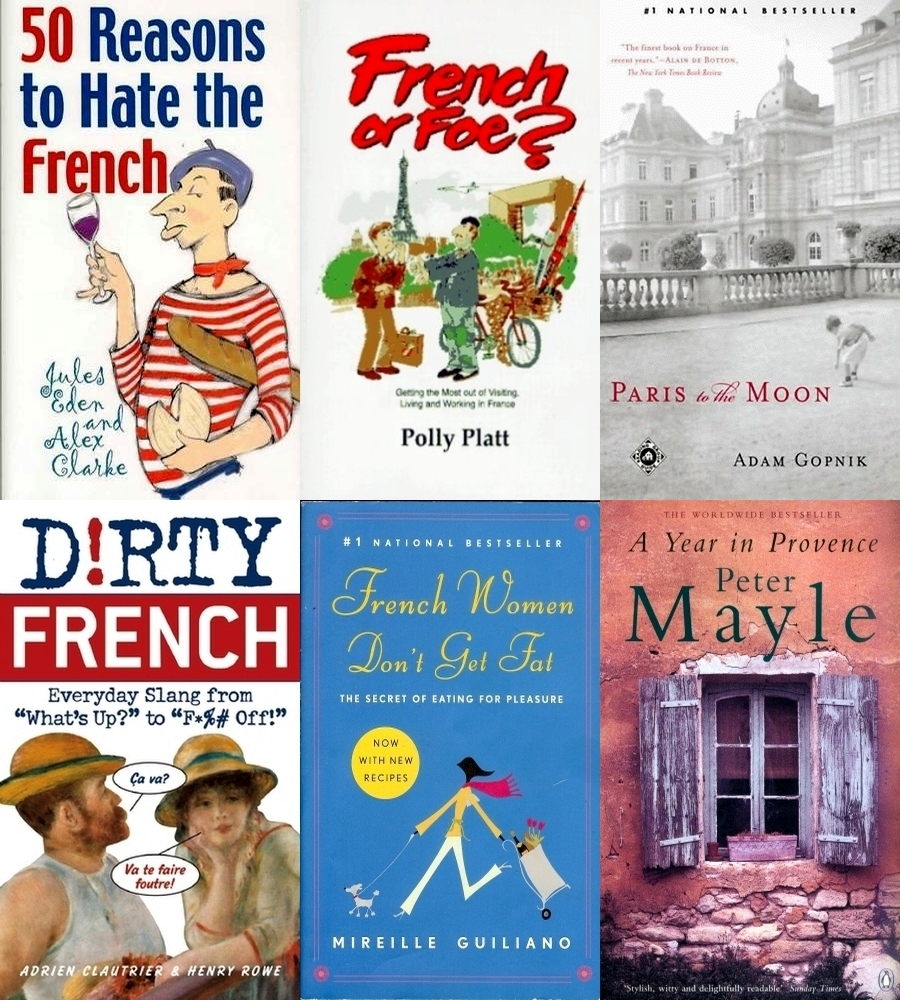
The stereotype of the French is that they are stinky, rude and have a predilection for bad comedy, but they are also elegant, thin and have a predilection for fine art and good literature.
The French are nothing if not an enigma — a study in paradoxes. How can one wear the latest Balmain creation yet go out sans deodorant? Truth be told, the French are far more complicated than the sum of their stereotypes.
When I studied abroad in Paris I learned it’s not that they are smelly, it’s that Americans are obsessed with hygiene. The French aren’t rude, we’re just too smiley. See? It’s all about perception. Having said that, whether you plan on living, studying or just visiting France, you might want to study up on what makes the French tick. To help you out, try reading one or all of the following books. You know, so you don’t come across as a boorish American or anything like that.
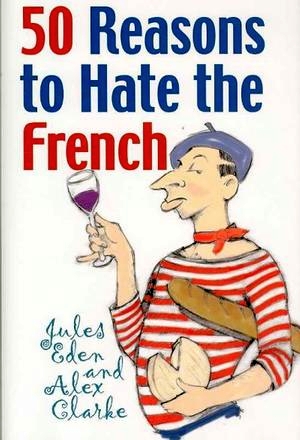
1) 50 Reasons to Hate the French by Jules Eden and Alex Clarke
Just in case you’re not sure if you love or hate the French, Jules Eden and Alex Clarke give you 50 hilarious reasons to detest them. Using history to illustrate many of their points, the duo delve into the literature, art and politics of France. From Depardieu to the lack of reverence for time, you’ll find yourself disliking those frog eaters, until you realize you still want to see the Eiffel Tower and croissants taste pretty dame good.
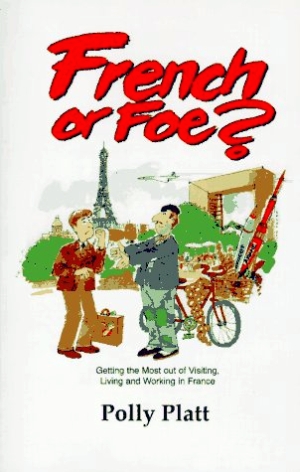
2) French or Foe?: Getting the Most Out of Visiting, Living and Working in France by Polly Platt
When you’re in France, there may be many times when you wonder whether someone is being purposely rude to you or whether they are just being French. Polly Platt tackles the stereotype of the “rude Frenchmen” head on by explaining the differences in our cultural attitudes and mannerisms to make your stay in France oh-so-pleasant.
So when the waiter is ignoring you during your next meal, you’ll now know that it’s not because he is secretly plotting against Americans, but because he wants you to take your time and enjoy your meal.
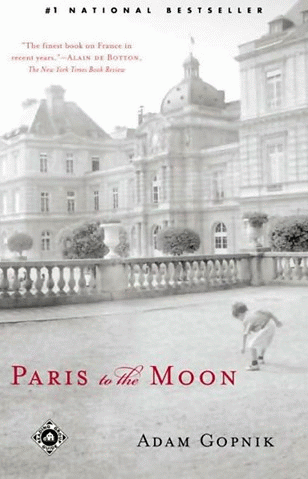
3) Paris to the Moon by Adam Gopnik
If you’ve ever wondered why there is no French version of Barney the purple dinosaur or why Café de Flore is the height of chic while Les Deux Magots is the equivalent of a public toilet, this is the book you need to read.
With a splash of humor, a dollop of personal anecdotes and a whole lot of love for the French, Adam Gopnik’s essays are an intellectual take on the most simple of French habits, including their obsession with striking. You may not approve when the métro you need to get to the Champs-Elysees is no longer running, but at least you’ll understand. Sort of.
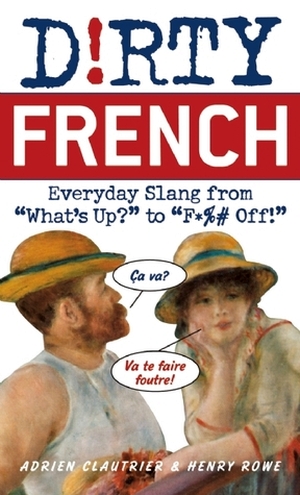
4) Dirty French: Everyday Slang from “What’s Up?” to “F*%# Off!” (Dirty Everyday Slang by Adrian Clautrier
In light of all this newfound understanding, you may find yourself making friends or wanting to flirt it up with a Frenchie. Throwing out some slang will let the other party know you’re hip to French culture. Gems like “I feel like partying (Je suis d’humeur a faire la tete), or “Damn girl your body is banging” (Oh cousine, chaud devant) will get you in the French fray in no time.
Or in spite of all this fabulous understanding you may acquire, you may still need to tell someone in no uncertain times to mind their own business. Since you’re in France, it’s only fitting you should be able to potentially curse someone out in their own language. This way they will actually understand you and you can still remain unfailingly polite for speaking in the local language.
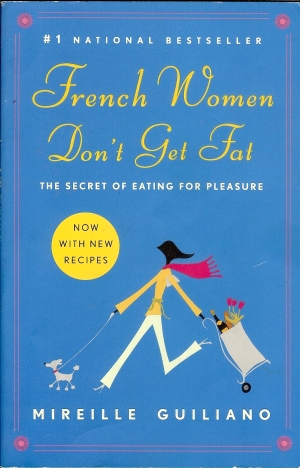
5) French Women Don’t get Fat by Mireille Guilano
If a year studying abroad and living with a French family taught me anything, it’s that the French love food like Americans love football and artificial sweetener. The reason most French women (and men) don’t get fat is because they don’t stuff their faces 24/7. And when they do, it’s not with a bag of BBQ potato chips.
The French don’t just eat — they savor. They dine. A meal is a three-hour affair that just happens to accompany a rousing debate about politics or which boulangerie has the best bread. Mireille Guilano goes into all of this with great detail, allowing even the junkiest of eaters to revamp their habits. Read this and you’ll understand how and why the French women can eat chocolate all the time and still look like Brigitte Bardot.
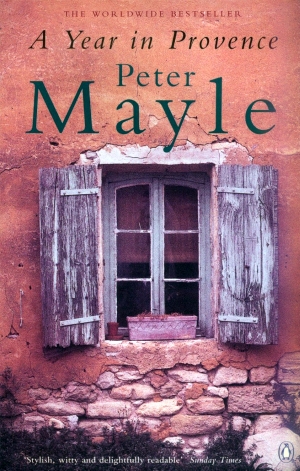
6) A Year in Provence by Peter Mayle
Who hasn’t thought of leaving it all behind and running off to France? I certainly have. Oh wait, I did do that. Armed with dreamy visions of fresh brie cheese, gothic cathedrals and men with French accents sweeping me off my feet, I said no to another year of frat parties and Natty Light for the beauty of France.
Then reality hit. In my case it was in the form of dog poo on the sidewalks. In the case of Peter Mayle, it was namely in the form of a freezing winter, nosy neighbors and French bureaucracy. But through it all, Mayle tells the story with a light-hearted affection for his adopted country capturing the more comical aspects of everyday French life. At the end, you can’t help but love the French.
By Rachel Khona

About the Author
 Rachel has served as contributing editor for Vaga and has written for Cosmopolitan, Inked and Ask Men. She is currently working on a memoir about being raised by a conservative Indian family, swindling European cab drivers and scaling glaciers. Find out more about Rachel at RachelKhona.com or follow her on Twitter at @RachelKhona.
Rachel has served as contributing editor for Vaga and has written for Cosmopolitan, Inked and Ask Men. She is currently working on a memoir about being raised by a conservative Indian family, swindling European cab drivers and scaling glaciers. Find out more about Rachel at RachelKhona.com or follow her on Twitter at @RachelKhona.
The post 6 Books You Must Read Before Going To France appeared first on The Expeditioner Travel Site.
]]>The post The Curious Case Of The Female Napoleon At The Louvre appeared first on The Expeditioner Travel Site.
]]>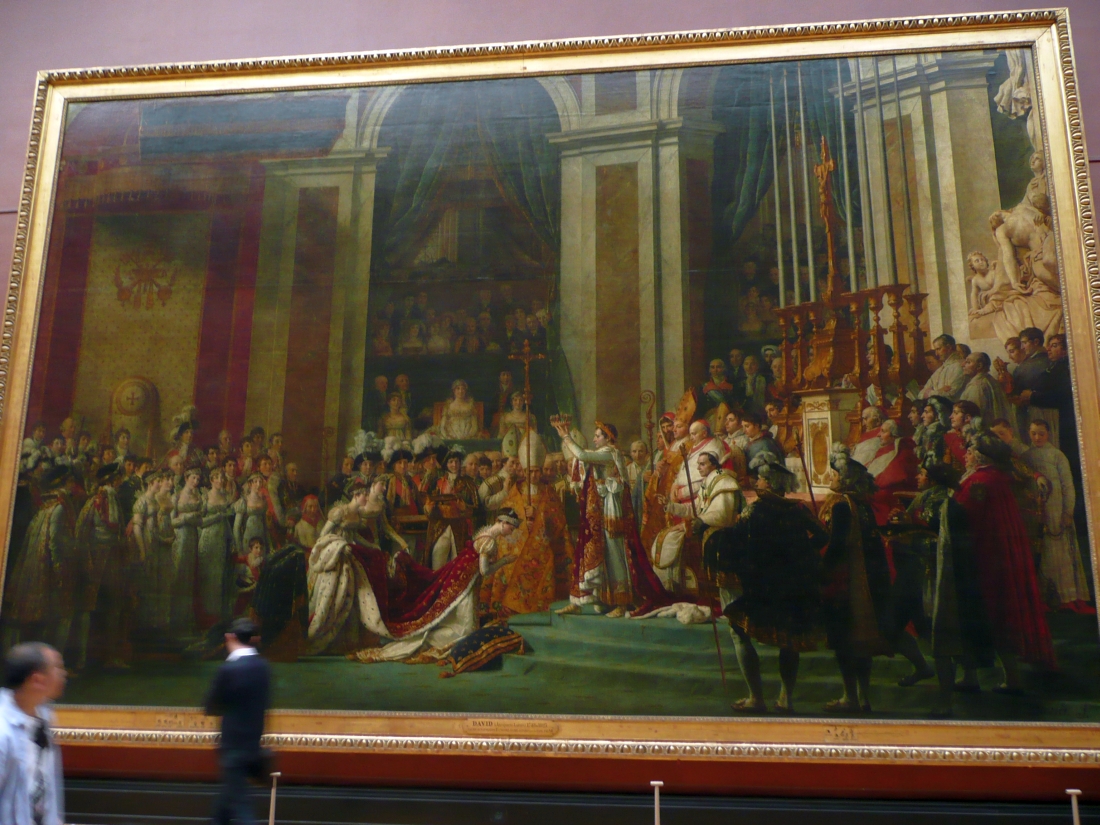
I am sitting on a bench in the Denon wing of the Musée du Louvre. It is almost noon and in front of me is The Consecration of Napoleon (otherwise known as The Consecration of the Emperor Napoleon and the Coronation of Empress Joséphine on December 2, 1804), one of the museum’s most famous works in its collection. In my hand is a tattered museum guide in English.
According to the guide there are still more wings with more floors with more important paintings that I should see. So far the only other painting of importance (as per the pamphlet) that I have seen is the Mona Lisa. However, I have already walked by, and sometimes even paused and examined at length, hundreds of other paintings so far.
Given the short amount of time I had in Paris, I had found myself traveling criss-crossing across the Seine, museum-hopping to the point that I was now becoming tired of all the art that was around me. My legs are tired but more than the physical exertion it is the loneliness that is weighing me down.
I can hear multiple languages spoken around me. Whenever I hear English being spoken I strain to overhear the conversation. Maybe eavesdropping in on them can make me forget that I am in Paris alone.
An elderly couple walks by and stops at the painting. After a brief examination, the lady remarks, “This is the second-largest painting . . . ,” and almost immediately lowers her voice so as not to disturb me. Oh, if only they knew how much I really wanted to silently listen in on their conversation. One can get a lot of information about a painting by simply sitting in front of it and listening in on people’s conversations. Not a lot of them spend time with the painting. Some of them are just happy clicking a picture. A few even bother to read the title.
In the time that I sit on that bench, I learn a lot of the history of the painting. The painting is by Jacques-Louis David and has been revised once. Napoleon did not consider the Pope worthy enough to crown him, so the original painting featured Napoleon holding the crown above his head in the act of crowning himself — the Pope merely present to consecrate the act. Napoleon’s mother was not happy with the fact that his son considered himself above the Pope and actually did not attend his “self-coronation,” but Napoleon had David include her anyway.
The version of the painting that I am sitting in front of is the revision of the original painting, again done by David. In the revised painting, Napoleon is seen crowning Josephine as the Empress, but the title remained unchanged, and hence the Consecration of Napoleon has Napoleon crowning Josephine as the Empress.
After the nameless faces move on to another painting I get up to get a closer look at the canvas.
I pore over the details of the painting in my mind when I hear them, long before I see them. There are about 10 students nearby, all dressed in yellow sweaters; a tall, muscular woman with them in red stuck out like a sore thumb — obviously their teacher.
The students walk behind her slowly, dragging their feet. A few of them have earphones plugged to their ears. They stop directly in front of the painting.
“This here is the Consecration of Napoleon. Come closer everybody.” With a wave of her hand the instructor gathers everyone around on either side of the painting. Well, almost everyone.
Two boys chewing gum refuse to join the fold. They stand aloof with their hands tucked into their pockets and their backs to the painting, completely unaware that they are blocking a poor lady from passing through.
“Mark! Andy! Step aside and let the nice lady pass, please,” the instructor shouts to them before giving the lady an apologetic smile.
The instructor seems unruffled by their lack of interest. Instead, she begins to explain the painting to the rest of the group who care to listen.
I return to my seat on the bench, hoping there is more I can learn about the painting. Mark and Andy sit on a bench beside mine.
The one with the curly hair bends down and puts his head within the palm of his hands while the other crosses his legs and digs his elbow into his friend’s back.
“Dude, the Mona Lisa sucked,” said the friend who had crossed his leg.
The curly-haired boy nods in agreement. “Yeah, she is not even pretty!”
“And the painting is so damn tiny!”
I can’t believe we came all the way to see that.”
“Sucks man. I am hungry.”
With that they plug their earphones to their ears and shake their heads to music loud enough for me to hear.
Meanwhile, the instructor wraps up her explanation, “. . . and that is why you only see Josephine kneeling for the consecration of Napoleon.”
With that the lady leads the group forward.
Andy and Mark show no signs of rejoining them. The instructor sighs. She walks over to the boys with her hands on her hips, and with an exasperated look asks, “Andy, Mark, would you like to join us?”
With that she heads back to the front of the group, leaving the two boys to make their decision.
The two get up slowly. One of them walks over to the painting, hands tucked into his pocket.
He reads the title. “The consecration of Napoleon.”
His curly-haired friend walks over and stands beside him, and in a sudden flash of revelation, shouts out, “Dude, I thought Napoleon was a guy!”
By Marie Lisa Jose

[Image via MapThePlanet]
ABOUT THE AUTHOR
 Lisa spends all her vacation days traveling to different corners of the world, seeking out adventures and finding stories waiting to be told. When not on vacation she is either planning for one or recovering from one. You can visit her blog at mjose.org.
Lisa spends all her vacation days traveling to different corners of the world, seeking out adventures and finding stories waiting to be told. When not on vacation she is either planning for one or recovering from one. You can visit her blog at mjose.org.
The post The Curious Case Of The Female Napoleon At The Louvre appeared first on The Expeditioner Travel Site.
]]>The post 5 Reasons To Include Lyon On Your Next Trip To France appeared first on The Expeditioner Travel Site.
]]>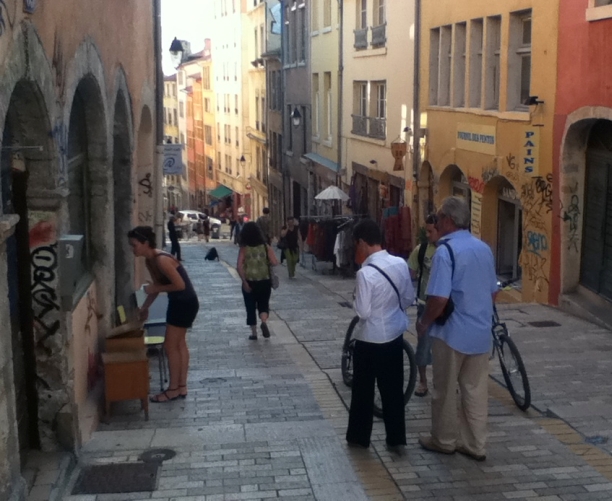
Maybe it’s because the lights of Paris burn so brightly, but travelers often forget there are other cities in France. I suspect smaller French cities get skipped over on the way to the countryside, where people seek life-affirming epiphanies in a quaint, Provençal setting or for suntans on the southern beaches.
I don’t blame these vacationers, really, but since moving to Lyon (sometimes called “Lyons” in English), I have had several friends miss a visit to my city because they simply just couldn’t squeeze it into their European itinerary. Quel dommage!
I understand that if you plan a week-long visit to New York City, that doesn’t mean you will scrap seeing the Statue of Liberty to jaunt over to Chicago for the Sears Tower, or that you wouldn’t avoid Rome’s Colosseum for Turin’s shroud. However, Lyon, now France’s second-largest city, is easily accessible by other European and international hubs, and is only two hours by train from Paris. And as the oldest city in France, and the reputed food capital of a nation renowned for its cuisine, you really are running out of excuses not to visit. Here are five reasons why Lyon needs to be included in your next trip to France.

1) Lyon Is Delicious
It’s no secret to foodies that Lyon is known for its culinary tradition — the city itself is home to an impressive 22 Michelin stars. Here you can wrap your lips around Lyonnaise specialties such as boudin noir (a dark blood sausage), quenelles (flour and seafood dumplings), tarte aux pralines (a sugary, electric pink dessert) or sip the many varieties of Rhône river valley wine.
Most of these dishes can be found in the traditional bouchons, or the vegetarian-unfriendly local restaurants known for their snout-to-tail style cuisine such as the Café Des Fédérations, Danielet Denise and Le Bouchon Des Filles, the latter of which offers slightly updated versions of the classics.
Personally, I prefer the lighter fair at the daily outdoor marchés, such as the Marché Saint Antoine, which offers an eye-popping array of seasonal produce, cheeses and flowers. Or I shop the Asian markets in the small Chinatown of the Guillotière quarter for curry paste, limes and cilantro.
The most famous specialty food market is Les Halles de Lyon Paul Bocuse. Paul Bocuse is one of France’s most celebrated chefs, a local hero and also namesake to a prestigious cooking school and the world culinary contest known as the Bocuse d’Or.
Finally, no French city is complete without its cafes, necessary for socializing over an apéro before dinner, or for, uh, socializing, over a tiny cup of espresso. For the best coffee in town, head straight for Cafe Mokxa, run by a Franco-New Zealand couple who are very passionate about how their coffee is grown, roasted and served. And for an apéro, try the Café de la Mairie, for the local color of the pétanque players launching their metal balls in the adjacent Place Sathonay.
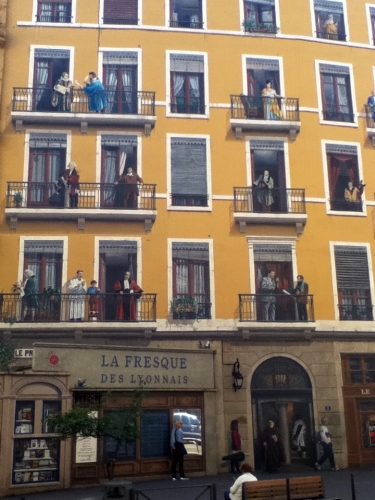
2) Lyon Is For Lovers
Just one stroll down the narrow cobblestone streets of Vieux Lyon, aka the Renaissance-era “old town,” and you will be canoodling with your sweetie. I dare you to steal a kiss in one of the many hidden traboules, which are a network of secret, covered walkways throughout the city. Once used by silk workers to protect their delicate wares, they could inspire your next clandestine romantic meeting.
Vieux Lyon is best avoided on the weekends, though, when it gets clogged with tourists and panhandling street performers. Also, generally, the restaurants here are overpriced, and the pubs full of loud footballers.
Quieter spots for romantic moments can be found on the quais lining the Rhône and Saône. The center of Lyon is a peninsula, or presqu’ile, between two rivers. On the Rhône River side, a peaceful green space with bike lanes is good for people-watching and sunset views. You can also prendre un verre at any of the péniches, which are bars inside the boats floating on the river.
With next to no money and some imagination, lovers can have a memorable time. A fresh baguette, fromage and wine in the grand Parc de la Tête d’Or can make for a sweet picnic. Or they can take a spin on the 200-foot-tall Ferris wheel at Place Bellecour, the largest public square in Europe. If you’re lucky, you’ll be alone together at the top with a great view of the city.
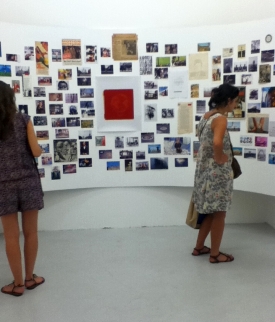
3) Lyon Is For artists
Creative types will appreciate that the Lyon Biennale of Contemporary Art has gained increasing international attention in recent years, and the Ecole des Beaux Arts attracts ambitious art students from all over.
While the Musée des Beaux Arts hosts an impressive collection of pieces from ancient Egypt and European paintings and sculpture dating from the 14th Century, many of the galleries on Rue Burdeau showcase modern artists. One gallery that is a constant standout is néon, a not-for-profit organization dedicated to championing the work of younger unknowns.
Art in Lyon can even be found its rues, in its many trompe l’oeil murals and pervasive graffiti. Spacejunk is a gallery for graffers and street artists located on the slopes, or pentes of Croix-Rousse. Here you can buy spray paint bombes, limited prints and original art to a hip-hop soundtrack.
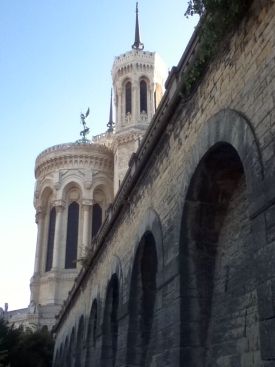
4) Lyon Is For History Buffs
Say this five times fast: Colonia Copia Claudia Augusta Lugdunum. This is Lyon’s original Roman name, and her history as a former colony of the empire is evident when you hike up the Fourvière hill for the Musée Gallo-Romain. The UNESCO world heritage site features ruins and two sizable Roman theaters, one of which has been renovated and has recently hosted concerts by Bjork and Bob Dylan.
One of Lyon’s most notable landmarks, the Basilica of Notre-Dame de Fourvière, is a very short walk from the ruins, and this impressively constructed church receives two million visitors annually. The most spectacular time to visit is during the Fête des Lumières, or the Festival of Lights, in early December.
It is then that Lyon pays tribute to the Virgin Mary for saving the city from a cholera epidemic that hit Europe in 1823. The Basilica hosts choir and organ concerts, and is illuminated by candles and lights inside and out. In fact, all of Lyon is aglow, as the Lyonnais put candles in their windows and the city organizes nightly light shows. Also, don’t tell Mary, but you can sip warm mulled wine on the streets with the other happy revelers.
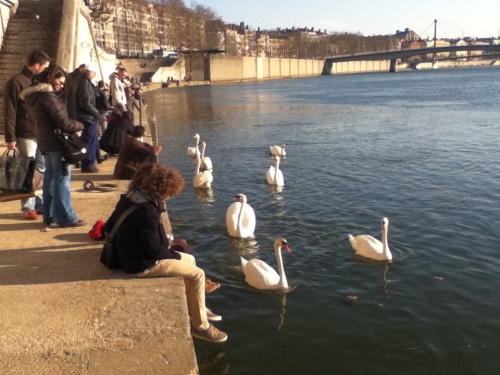
5) Lyon Is Affordable
Unlike Paris, Lyon is not always crawling with tourists, therefore it’s harder to find the prices to match. In most places you can have a decent espresso for less than €2 and a demi pint of beer for €2.50. Lunch for two at a notable bouchon is €60, which includes aperitif, wine, appetizers, mains, and cheese or dessert. This is on the expensive end of things, but forgoing the libations will usually cut the price in half.
The metro, bus and tram lines are very easy to navigate, and €4.90 buys you a “Liberté 1 jour” ticket good for unlimited transfers for the day. You can also rent a Vélo’V city bicycle for €1.50 a day.
Accommodations range from ritzy to basic, depending on your budget. If you want a more personal experience, some nice canut-style apartments, which are 19th-Century silk worker ateliers converted into livable lofts can be rented directly from their owners on Airbnb.
The TGV high speed train from Paris starts at €25 euro one way and €30 EasyJet tickets make it easy to city hop from most places in continental Europe. Otherwise, there are several big airlines that operate international flights into Lyon Saint Exupéry airport year-round.
*
The official slogan for Lyon is “Only Lyon,” which is a way of extolling an alluring city with a 2,000-year history and a rich cultural and culinary heritage. I find Lyon to be very safe, scenic and easy to navigate. It has all the conveniences of any city, but definitely a French way of living, which means that many shops and businesses are closed on Sundays and Mondays, and during lunch hours. But trust me, you won’t mine, you’ll want to slow down and take your time here anyway.
By Anna Barie

About the Author
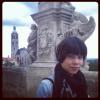 Anna Barie is a writer and musician from Brooklyn, expating it up in Europe. She could eat crêpes and pintxos every day. Her site is AnnaBarie.com
Anna Barie is a writer and musician from Brooklyn, expating it up in Europe. She could eat crêpes and pintxos every day. Her site is AnnaBarie.com
The post 5 Reasons To Include Lyon On Your Next Trip To France appeared first on The Expeditioner Travel Site.
]]>The post When Paris Turns Into Saint Tropez appeared first on The Expeditioner Travel Site.
]]>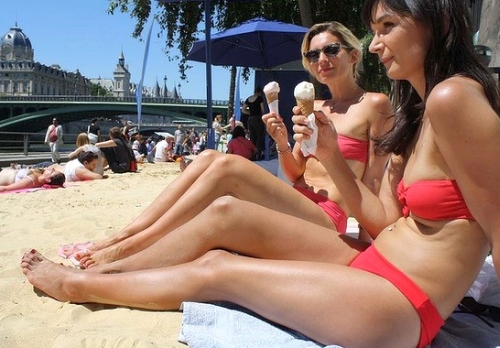
The Paris-Plage (Paris Beaches) kicks off in Paris every year in late July, transforming riverside roads usually congested with cars into an urban oasis complete with sandy beaches, deckchairs, food vendors, outdoor concerts and Parisian woman eating ice cream in bikinis (see above). Your welcome.
This year find the riverside beaches at Louvre/Pont de Sully, Port de la Gare and Bassin de la Villette. For more information about what you’ll find and a calendar of events, click here.
[Photo via AFP/The Sydney Morning Herald]
The post When Paris Turns Into Saint Tropez appeared first on The Expeditioner Travel Site.
]]>The post 20 Free Things To Do In Paris appeared first on The Expeditioner Travel Site.
]]>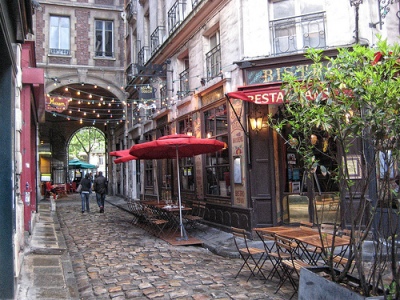
Despite the fact the euro is hitting new lows against the dollar, chances are that any savings in the exchange rate are more than outweighed by the increase you paid in air fare to the Continent. With that in mind, check out Lonely Planet’s list of 20 free things to do in Paris before you go to help out the damage to your wallet.
Included on their list is Père Lachaise Cemetery (the final resting place for Oscar Wilde, Proust, Balzac and Jim Morrison), the Marché d’Aligre (a classic Parisian market known for its authentic feel and lack of snobbery), and the Canal St-Martin (a favorite waterway between République and Gare du Nord in the 10th arrondissement where locals sip wine and take in late summer light).
[To 20 Free Attractions in Paris]
The post 20 Free Things To Do In Paris appeared first on The Expeditioner Travel Site.
]]>The post Paris’s de Gaulle Airport Named Worst In The World appeared first on The Expeditioner Travel Site.
]]>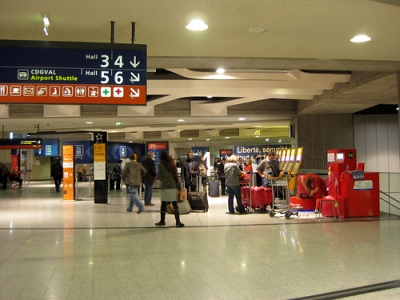
How can a city so revered for its aesthetic beauty and so dependent on tourism (Paris is the most visited city on Earth) have the worst airport it in the world? Perhaps it is for those very same reasons. An overabundance of attention spent on maintaining the city itself and the burden of having to accommodate the tens of millions of visitors every year have helped Paris-Charles de Gaulle Airport earn the right to be named the worst airport in the world, at least according to CNN GO.
With its “[g]rimy washrooms with missing toilet seats . . . broken scanning machines and an overall lack of signage, gate information screens and Paris-worthy bars, restaurants or cafés,” the airport has been likened by more than one traveler as similar to spending time in a prison.
Other airports called out for their lack of function, size and accommodations include Los Angeles’s LAX Airport (“dramatically undersized and moribund”), London’s Heathrow (“a chronic inability to cope with people”) and Honduras’s Toncontín International (“uncomfortable gate chairs, dirty floors and lousy dining options”).
Living in New York I’ve learned that griping about the city’s airports is as celebrated a topic as rent prices and subway service. The Awl recently asked two travel experts to compare and contrast (but mostly to criticize) New York’s two main airports — JFK and La Guardia — the result being an agreement that perhaps the best airports in the world are the ones that, in their words, just get you on the plane the easiest: “No oyster bars, no chair massages, no swimming pools on the roof: Just touch my junk and strap me in.” Who could ask for anything more in life?
The post Paris’s de Gaulle Airport Named Worst In The World appeared first on The Expeditioner Travel Site.
]]>The post My Adventures At A Nudist Colony In France appeared first on The Expeditioner Travel Site.
]]>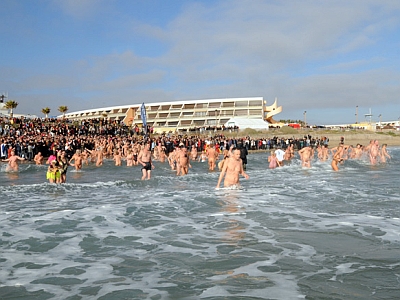
I arrive at the entrance to the nudist colony on a beautiful late-September afternoon. It’s in the mid-80 degrees Fahrenheit so I figure there will be plenty of (naked) people on the beach. I’m no enthusiast, but I’m here because I have to be.
I just moved into an apartment in Le Cap d’Agde, a small seaside town in the Languedoc-Roussillon region of south-central France, because I got a job as a teaching assistant at a local high school. The other day, a co-worker was showing me a map of the area.
“What is ‘Le Village Naturiste’?” I asked, pointing to a little enclosed section of town just northeast of my neighborhood.
“Oh, that’s the nudist colony,” she said matter-of-factly. “It’s the largest one in Europe.”
I was in a bind. I didn’t exactly want to go, but I have this compulsion to explore every aspect of a culture that I can whenever I’m traveling. And a nudist beach seems so quintessentially European. How could I say I’d lived in Le Cap d’Agde for an entire year and never saw this famous Mecca for nudists the world over, especially when it was only a 15-minute walk from my front door?
Stopping at the gate, I look at the day-pass prices. Zut! I realize I didn’t bring any money and, anyway, six euros seems a bit much considering I have no intention of staying long or taking off my clothes.
I approach the woman at the counter. “Do I really have to pay if I’m just checking it out for a few minutes?” She smiles and slides me a ticket. And with that, I’m in.
I pass parking lots and hotels as I walk toward the ocean, surprised and kind of disappointed to see that everyone around is at least partly clothed. This is downright normal, I think.
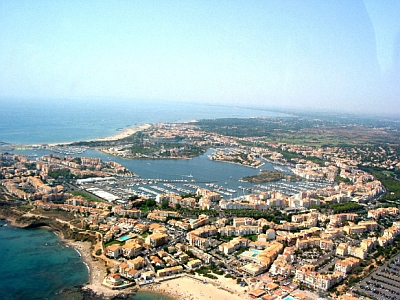 But nearing the beach, I see my first naked couple walking hand-in-hand towards me. I can’t keep a chuckle from escaping. I don’t know where to look. I don’t want to look directly at them, but I don’t want to seem like I’m averting my eyes. So I look straight forward and meet their gaze when they nod and say, “Bonjour.” I wait until they’re out of earshot before bursting into giggles.
But nearing the beach, I see my first naked couple walking hand-in-hand towards me. I can’t keep a chuckle from escaping. I don’t know where to look. I don’t want to look directly at them, but I don’t want to seem like I’m averting my eyes. So I look straight forward and meet their gaze when they nod and say, “Bonjour.” I wait until they’re out of earshot before bursting into giggles.
I find the idea of nude beaches and villages funny, impressive and disgusting all at once. Probably because I’m so uncomfortable with nudity myself. Even among my American friends, I’m one of the most prudish. I grew up in a conservative Midwestern household where it was less than encouraged. Add to that teenage body-image insecurities, and you get a girl who wore only one-piece swimsuits until she was 22 years old (even now it’s a tankini).
Still, I admire people who are carefree when it comes to their own and others’ bodies, people who view nudity as what it is: natural. When I think of nudist communities, I picture hippie families gathered in the yard, grandma naked in her lawn chair and brothers-in-law discussing social issues while passing around a pipe.
But I’ve heard this particular naturist village isn’t so innocent. You wouldn’t know it from reading Le Cap’s Office de Tourisme website, but the colony has gained an x-rated reputation. My French friend Céline informed me that it has become a libertine vacation spot for those specifically seeking a partner-swapping getaway. It’s apparently normal for couples to go at it openly on the beach or in the discos. Céline said there’s been talk for years of shutting the village down, or at least enforcing more family-friendly behavior, but the mayor opposes such efforts for the local economy’s sake.
I look out at the mile-long stretch of fine yellow sand dotted with nude bodies. I stroll along the path running parallel to the coastline and pass restaurants, shops, playground equipment and Pétanque courts. People ride bicycles stark naked. I think to myself that that has got to be unsanitary, not to mention uncomfortable. Many people watch me curiously (I am after all the weirdo with the clothes on). Others smile and say bonjour.
A pudgy middle-aged man approaches and asks, “Is this your first time in the village?” I nod.
“I’ll give you a tour,” he says. “Where are you from?”
I tell him the United States. “And you?”
“I live here in the village and work at the bar over there.” He tells me the bar is closed until next summer like many of the other businesses. There are far fewer tourists here now than there were in August, he says, when there were close to 40,000. Most of them will leave in October.
“But you live here all year?” I ask.
“Yes, about 300 people stay full-time.” He looks down at my shirt.
“You don’t want to be naked?”
“Um, no, I’m just looking around.”
“So you came to look at the naked people?”
He’s making me sound so creepy. “I guess,” I stammer.
“Why so shy?” he teases.
“I’m just not used to it. We don’t really have these in America.”
We continue walking. “Here is the beach for families and over there is the beach for sex,” he points farther down the coast. “There is also one for the gays.”
My expression prompts him to ask slyly, “What, you no like sex?”
“Not on the beach.” And not with you, if that’s what you’re insinuating, I think.
Sensing things getting weird, I say I think I’ve seen enough and should go.
“What are you doing tonight? I can get you into the disco for free.”
“No thanks,” I say, walking away.
I’m about to turn down the road leading to the village gate when another man, this one much younger and more muscular, looks at me quizzically and asks, “You new around here?”
“Yeah, but I was just leaving.”
“No, let me show you around. I’ll introduce you to my friends.”
I stop. I guess I really have nothing else to do today. One come-on shouldn’t scare me off, right?
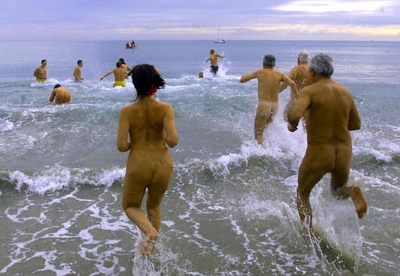 He introduces himself as David, a 25-year-old from the biggest nearby city, Montpellier. I’m guessing from his brown body that he’s been here for weeks. We walk to the water’s edge, dipping our feet in the sparkling sea.
He introduces himself as David, a 25-year-old from the biggest nearby city, Montpellier. I’m guessing from his brown body that he’s been here for weeks. We walk to the water’s edge, dipping our feet in the sparkling sea.
Now I’m really among the nudes. To my right, people splash around in the waves; to my left, sunbathing adults of all ages and sizes watch children build sand castles. I’m suddenly self-conscious. I’m wearing a spaghetti-strap tank top and short-shorts, not exactly the epitome of Victorian modesty, but I feel like I might as well be wearing full hijab.
“You’ll be cooler if you undress,” David says.
I laugh at him and say I doubt it would make a difference.
“Suit yourself,” he smirks. “There are pretty girls everywhere, but I like it here because they are all free and they all want to have sex with me.”
So I’m looking at it: A bona fide sex tourist.
“Oh really?” I mock. It’s true that of all the schlongs I’ve seen today, his distinguishes itself. But the stereotypical “hot guy” just isn’t my type. “Maybe not all of them,” I say, and he laughs.
We walk along the shoreline while he scopes out the playing field. One time, he leaves my side to petition a woman who could be tonight’s lucky lady. But she replies sorry, she’s married.
David identifies some people up ahead as his friends, one of whom is a Russian blond he says he slept with last night. He introduces me, and I’m greeted with enthusiastic bonjours and the three cheek kisses common in this French region. An Italian man hands me a sarong to sit on and David plops down next to the Russian.
A Frenchman named Pierre asks me where I’m from, then exclaims, “My neighbor here in the village is American. He’s from New York. He’s a fashion photographer.” The irony does not escape me.
I ask Pierre what he does for a living. He describes his work in undersea archeology, and I excitedly say that I really liked the archeology museum in Le Cap. We discuss the Roman and Greek influence in Southern France. The conversation is so normal that I soon forget the man is naked.
The strong Mediterranean sun is making me sweat. If I take off my shirt, my bra will be just like a bikini top, right? I remove it and am surprised by how refreshingly cool I feel.
“Oh, so white,” the Italian says, referring to my stomach which never sees daylight and is an entirely different shade than my tanned arms. “Like milk.”
“Um, thanks,” I say.
“No, white is beautiful too,” Pierre says. “No one judges each other here. All kinds of people can be comfortable.”
He’s right, it’s not like this place is filled with supermodels. There is quite a bit of flab and sag.
“Take the bra off too,” a French woman tells me. Her voice is raspy, presumably from decades’-worth of cigarettes. “What are you afraid of?”
“I just don’t feel comfortable,” I squirm. But then again, would it be such a big deal? “Well, maybe, I suppose, ok.”
“Here’s some sunscreen.” The woman scoots next to me and tugs on my bra. “Take it off!”
I notice that people in line at an ice cream cart are watching me.
“Well now they’re all looking.”
“That’s because you’re clothed,” she says.
“No, it’s because you’re yelling.” She grins because she knows I’m right.
I take a deep breath and unfasten the hook. Everyone cheers, and I raise my eyebrow as if to say, are you happy now?
We go back to chatting, about housing prices and regional accents, and everyone meets each others’ eyes. After a few minutes, I don’t feel embarrassed at all. The breeze feels good on my skin. At one point, I consider myself from an outsider’s perspective — topless me, surrounded by naked people, mostly men, one of whom is a midget wearing only a baseball cap that says “Cowboys” — and am hit with the hilarity of my position. I am thoroughly enjoying myself.
Turning my head to look at the ocean, I see a woman performing oral sex not ten feet away. He looks kind of bored. I turn away, shocked.
“Oh yes,” Pierre says. “Sex is very open here. Half the tourists come with their families, and the rest are, how do you say in English? ‘Swingers.’ Look over there.” Pierre points to a mass of men crowding around something on the ground. “In the center of the circle, they are having sex.”
My jaw drops. “And people gather around them like that to watch?” I ask, repulsed.
“Yes and when it’s finished, sometimes they clap.”
I laugh. Well, this is definitely a cultural experience.
“I just don’t know how the couple in the middle does it,” I say.
“I agree, I like it to be more private,” Pierre says. “But, you know, the village is well-known throughout Europe. In the summer, couples come from countries like Germany and Russia to make love on the beach.” He adds sincerely, “It is very beautiful.”
I find that I respect his reverence for nudity and sex. While some here, like David, are just looking for their next lay, others truly enjoy the freedom from judgment and the beauty of the human body.
By the time I wave goodbye to everyone, I’m starting to forget why we need those pesky pieces of fabric we call clothes anyway. As I step onto the path and head towards the exit, I pass three middle-aged men, each of whom obviously and unabashedly stares at my chest. I hurriedly pull on my shirt. Oh that’s right, now I remember.
By Cathy Martin

About the Author
 Cathy Martin is a traveler and aspiring writer from Madison, Wisconsin. She currently lives in southern France where she tries to convince teenagers that learning English is fun.
Cathy Martin is a traveler and aspiring writer from Madison, Wisconsin. She currently lives in southern France where she tries to convince teenagers that learning English is fun.
The post My Adventures At A Nudist Colony In France appeared first on The Expeditioner Travel Site.
]]>The post The Top 10 Most Visited Countries In The World [Infographic] appeared first on The Expeditioner Travel Site.
]]>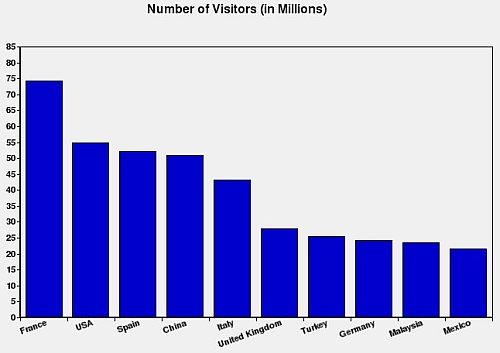
According to the most recent statistics from the World Tourism Organization, the top 10 most visited countries in the world was unchanged in order from 2008, with France leading the way, welcoming 74.2 million international travelers in 2009, a decrease of 6.3% from the previous year.
As can be seen in the graphic above, the United States came in second with 54.9 million visitors, followed by Spain (52.2 million), China (50.9 million) and Italy (43.2 million). Rounding out the top ten were the U.K., Turkey, Germany, Malaysia and Mexico.
Interestingly, though coming in as second, the U.S. is first in amount of money spent by visitors, with Australia and Austria breaking into the top ten using this metric. I’m going to go out on a limb here and theorize that the Disney parks’ snack bars are wholly responsible for this anomaly.
[2010 World Tourism Organization Facts & Figures (PDF)]
By Matt Stabile

ABOUT THE AUTHOR
 Matt Stabile is the Founder and Editor-in-Chief of The Expeditioner. The Expeditioner began in 2008 and is headquartered in New York City. You can read his writings, watch his travel videos or contact him at any time at TheExpeditioner.com. (@TheExpeditioner)
Matt Stabile is the Founder and Editor-in-Chief of The Expeditioner. The Expeditioner began in 2008 and is headquartered in New York City. You can read his writings, watch his travel videos or contact him at any time at TheExpeditioner.com. (@TheExpeditioner)
The post The Top 10 Most Visited Countries In The World [Infographic] appeared first on The Expeditioner Travel Site.
]]>The post 6 Best Places To Eat Dessert In Paris appeared first on The Expeditioner Travel Site.
]]>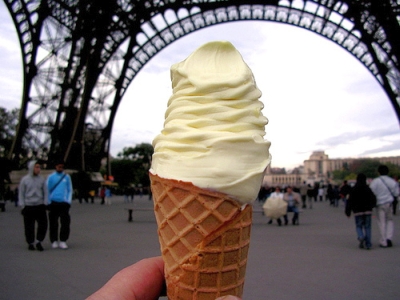
Paris may be known for its decadent, mutli-course meals, but nothing says delicacy like the grand finale: dessert. Actually, it’s not unusual in Paris to mosey into a patisserie or chocolaterie for a midday snack, but one so fantastic that you’d hardly believe it was just a quick bite.
The following list includes some of the more expensive places for desserts, but even at the high prices, the high-profile sweets cost less than a casual cafe lunch. For the cost-conscious, the price really is worthwhile for such mind-blowing treats. Besides, no one ever got too poor eating macarons — and if I sound like Marie Antoinette, then you know we’re headed in the right direction, aren’t we?
Each of the following is a stunning, touristy homage to all things beautiful about French design and cuisine. Of course, that also includes being rude to tourists and jacking up prices, but hey la vie est belle.
Angelina
Angelina, a hop skip and a jump from the Jardin des Tuileries (and Le Musée du Louvre). Perhaps because of its prime location and longevity, Angelina is top of its class in decor, history and crowd management. Rumor has it Coco Chanel ate here, and if you look closely at the crowd around you, you’ll see it’s still an elegant blend of overzealous tourists and the French well-to-do. And while I rarely say this, the ambiance is so beautiful it trumps people-watching.
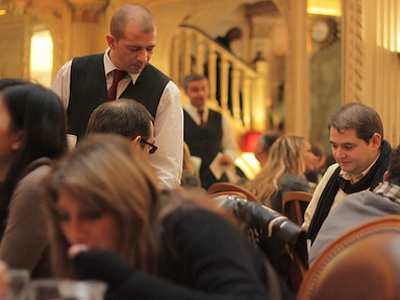 At Angelina, du chocolat chaud is a good place to start when you’re not sure what to order — scandalously called L’Africain for it’s dark color. First of all, call me traditional, but last time I checked, hot chocolate was supposed to be a drink. Around these parts though, the hot chocolate’s so heavy that it’s necessary to save room for it like a slice of cake. With a dab of chantilly (whipped cream), it’s hard not to be sold on the whole experience.
At Angelina, du chocolat chaud is a good place to start when you’re not sure what to order — scandalously called L’Africain for it’s dark color. First of all, call me traditional, but last time I checked, hot chocolate was supposed to be a drink. Around these parts though, the hot chocolate’s so heavy that it’s necessary to save room for it like a slice of cake. With a dab of chantilly (whipped cream), it’s hard not to be sold on the whole experience.
If you like chantilly then chances are you’ll love the Mont Blanc. This creamy dessert derives its name from the mountain in the French alps, and with its snow-colored insides and soft, cool taste, the name makes perfect sense. The Mont Blanc is predominately flavored with chestnut, complementing the sensory experience of cool cream with a warm, nutty flavor. This is a distinctly French treat worth trying.
Ladurée
I much preferred the people, and comparably delicious chocolate and cream, at Ladurée, which actually has mulitple locations. The original location is in the 6th arrondisement, and is characterized by an intimate, exotically decorated charm. I brought my French-speaking friends, my mother, and my discreet artist uncle here, and we were treated well in French time and time again, although I did see tourists with a language barrier struggling. Ladurée created all the desserts for the 2003 film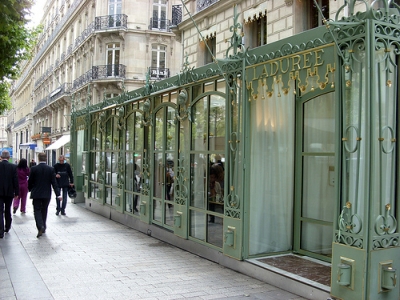 Marie Antoinette, and seeing these beautiful creations before my eyes really brought the old world feel to life.
Marie Antoinette, and seeing these beautiful creations before my eyes really brought the old world feel to life.
However, the more recently opened Champs Elysées location is more easily accessible to the on-the-go traveler (not to mention the handicapped), and of course friendlier and more accommodating to visitors. Upstairs, there is a seating area with red velvet chairs that also offers a dinner menu. There’s even a bar back on the first floor that stays open late, so you can drink cocktails, meet people, and eat high-quality pastries all at once. I had some good times at that bar, which was recommended to me by French students, since it was easy to get to and open late.
Pierre Hermé
A macaron is like a mini, colorful version of an ice cream sandwich, except that the inside is buttercream, and typical flavors include pistachio, raspberry, and rose. Stack three on a saucer with a nice cup of coffee and you’re practically a bonafide Parisian.
Because of their widespread popularity, macarons now come in all shapes and flavors, depending on where you look. Not only are the bite-sized cookies delicious, but there are also full-size options you can sit down and eat as a full dessert.
Good macarons are easy to find all over Paris, but Pierre Hermé is famous for their macarons, and their boutique located in St-Germain lays out their choices as if you were going jewelry shopping. Due to their bright colors and the decorative packaging they are placed in, Macarons make great gifts for all occasions.
Amarino
One of the best things about Paris is the mild weather. Yes, it can get quite chilly in the winter months, but I found myself eating Amarino ice cream cones well into the fall and fresh into the spring. This isn’t your average ice cream though — or even your average gelato for that matter — but rather the kind of rock-your-world full-flavored treat that turns everyday eaters into Julia Childs.
The only place I ever found American style ice cream in Paris was the chain movie theater’s tiny Ben & Jerry’s enclave. Instead, the best bet for the everyday fix is Amarino, a chain located throughout France with multiple locations in Paris. For about 3 euros, you can combine up to three flavors, scooped in the shape of a rose — enough said.
My favorite Amarino location is 4 Rue Vavin, however, if you’re between visiting destinations, there’s also one in the Latin Quarter, near Notre Dame and La Sorbonne.
Glacier Berthillon
But maybe rose-shaped gelato isn’t doing it for you. Maybe you’re tired of blasé sugars and chocolates. Maybe you’re looking for a different kind of eating experience. In which case, the only place left to go is the Ile Saint Louis, for Glacier Berthillon.
At Glacier Berthillion, the flavors vary by season, and include only the freshest ingredients in gelato and sorbet. Perhaps you’ll catch the caramel au gingembre (caramel ginger), but there’s really no wrong way to go. After you’ve finished eating and come back down from cloud nine, try to remember why you’d ever go to Baskin-Robbins.
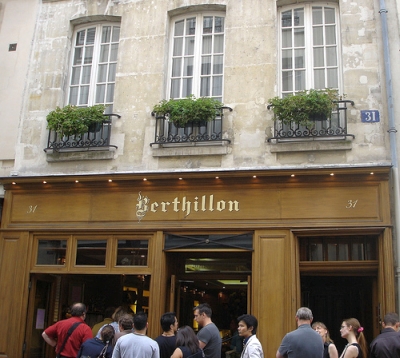 I will always remember the first time I went to Berthillon. It was a sunny, not-too-hot spring day, and there wasn’t a whole lot to do (a pattern to my life in Paris), and my friends were all walking along together. We decided to wander over to l’Ile Saint Louis, and as we entered the dark, wooden enclave, I smiled at a stunning man on a motorcycle. I chose the pear sorbet, and the sensation was so amazing — actually, really amazing — that I made an involuntary noise. The man on the motorcycle heard me and laughed at us American girls, but I really think that it was the ultimate French experience.
I will always remember the first time I went to Berthillon. It was a sunny, not-too-hot spring day, and there wasn’t a whole lot to do (a pattern to my life in Paris), and my friends were all walking along together. We decided to wander over to l’Ile Saint Louis, and as we entered the dark, wooden enclave, I smiled at a stunning man on a motorcycle. I chose the pear sorbet, and the sensation was so amazing — actually, really amazing — that I made an involuntary noise. The man on the motorcycle heard me and laughed at us American girls, but I really think that it was the ultimate French experience.
A Good Mirabelle Pear and Brie
At the end of the day, the sugar experience in Paris is about freshness and careful consideration, which I learned from the French around me. My host family in Paris ate very healthfully and simply. At dinner, we’d start with one or two vegetables as a salad, then a little meat or fish, and finally we’d have cheese and fruit.
But this was just not any cheese and fruit. This was chevre (goat cheese) or brie (a soft, buttery cow cheese), accompanied by the ripest apples and mirabelle pears I have yet to taste. Biting into a pear instantly conjures up images and tastes of what I love about eating in Paris: the colors, the flavors, and most of all, the attention to detail.
Something so simple as a piece of fruit so carefully complements the right kind of cheese, and there’s not a growth horomone or artificial flavoring in sight.
*
So no matter what kind of tastes appeal to you, or how much or how little you want to spend, remember that in Paris — a city with a special knack for providing pleasure — wherever you decide on for dessert, chances are it’s going to be good.
Angelina
226 Rue de Rivoli
www.angelina-paris.fr
Ladurée
75, avenue des Champs Elysées
www.laduree.fr
Pierre Hermé
72 Rue Bonaparte
wwww.Pierre Hermé.fr
Amarino
4 Rue Vavin
www.Amarino.fr
Maison Berthillon
31 Rue St Louis en l’ile
www.Berthillon.fr

About the Author
 Alexandra Bregman has written for The Expeditioner, Beyond Race, poetic and academic publications. She has a traveler’s spirit, big dreams post-Smith College graduation, and can be followed at @alixbregman.
Alexandra Bregman has written for The Expeditioner, Beyond Race, poetic and academic publications. She has a traveler’s spirit, big dreams post-Smith College graduation, and can be followed at @alixbregman.
[La Tour d’Eiffel by Cordoolia/Flickr; Angelina, Paris by Angelina C/Flickr; Laduree/Flickr; Berthillon at Ile St. Louis by Shalini Arunogiri/Flickr]
The post 6 Best Places To Eat Dessert In Paris appeared first on The Expeditioner Travel Site.
]]>The post Q&A: A Taste Of The Dordogne With Author Kimberley Lovato appeared first on The Expeditioner Travel Site.
]]>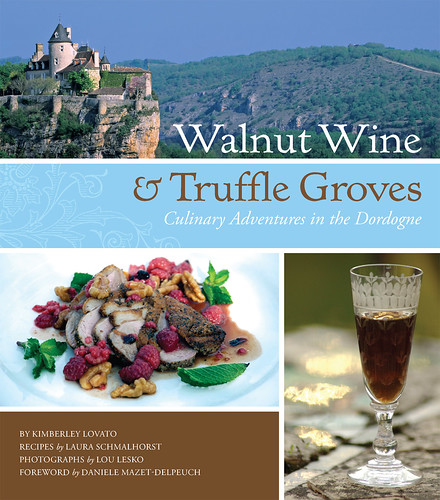
By Maria Russo
In her latest book, “Walnut Wine & Truffle Groves, Culinary Adventures in the Dordogne,” Kimberley Lovato explores the medieval towns, bucolic countryside, and remote villages of this southwest region of France through the fascinating heritage of its people, and the local cuisine that has kept century-old traditions alive and well.
The book’s vivid photos, intimate stories, and pages of recipes, gives it a fresh, more immersed approach to travel writing by escorting the reader on an adventure through the senses. Whether it’s admiring the spectacular Château de Beynac, hearing the cacophonous sounds of the market as vendors prepare for the day ahead, or tasting warm, duck confit in the home of a local chef, Lovato paints a tangible picture that is deliberately enticing. The following is an interview with Lovato about her personal encounters in the Dordogne, and the inspiration behind the book’s vibrant pages.
The Expeditioner: The layout of “Walnut Wine & Truffle Groves” is very unique. It blends pages of photographs, local recipes, and intimate stories about the people of the Dordogne region. What inspired you to create a culinary travel book?
Kimberley Lovato: The book was inspired by Chef Laura Schmalhorst and her culinary tour company Vagabond Gourmet. I was on assignment during her inaugural launch in the Dordogne and I was struck by her passion for ensuring each guest experienced the region through the food, not just by eating it (though that was a bonus too), but also by visiting the markets, the farms, meeting the local cheese makers and vintners, exchanging recipes, and mixing their stories and histories into every meal. This idea developed into “Walnut Wine & Truffle Groves” and it’s a concept that is unique among travel and cookbooks. Add in some gorgeous images by award winning photographer Lou Lesko and our book really shines. I can’t think of another one like it.

The Expeditioner: The personal accounts in the book really seem to connect readers to the very essence of the culture in Dordogne. How did your experiences with chefs, winemakers, hoteliers, and old friends affect the way you came to understand the true lifestyle of the people of Dordogne?
Kimberley Lovato: I have always been enamored with France, but I fell in love with the Dordogne. It’s a place that is a part of me and a place where I feel welcomed “home” each time I return. While the castles and the restaurants and the tourist sites were worthy, they only presented a two dimensional picture of the place. It was the people who lived behind the doors, and who graciously opened their homes to me, that gave the Dordogne life and texture, as well as the context in which I could present a different side of travel that might not be visible to a casual visitor.
The people of the Dordogne are very generous and love to wax lyrical about the region. And they are great raconteurs whose tales divulge small details, anecdotes and expressions that aid in the understanding of the life and culture in the Dordogne. Getting to know them personally was essential.
The Expeditioner: In the book you discuss the markets worth visiting in many of the smaller, “out-of-the-way” towns. How did you go about finding some of these remote locations and what advice would you give to travelers looking to explore off-the-map places?
Kimberley Lovato: I love to get lost and getting lost was often our goal while researching this book. Seriously. Sometimes we would be on a set path and we’d pass a sign that said “honey” or “walnut farm,” and we’d just deviate. Getting lost has its benefits and it’s a tactic I don’t mind recommending. But if time doesn’t allow you to employ this strategy, I would suggest asking a local. Ask the fruit vendor at one market where he likes to shop, or eat, or what other markets he attends; ask the inn owner where she buys her bread or where she goes for a great meal. This phenomenon of news travelling — de bouche à l’oreille as they say in French, meaning from mouth to ear — is alive and well in the Dordogne and was the source of many, if not most, of our “out-of-the-way” finds.
The Expeditioner: On to one of my favorite subjects discussed in the book: the walnut wine. It seems that this particular aperitif is served with most meals, on most occasions, and carries an intricate piece of Dordogne history in its roots. When is the ideal time to visit some of the region’s walnut wineries, and what suggestions could you offer visitors who may want to learn more about the wine-making process, and even enjoy a tasting or two?
Kimberley Lovato: The interesting thing about walnut wine is that you can’t go to a winery to find it; you have to go to a walnut farm or a private home. It’s a drink that is predominantly homemade and, yes, it is the aperitif of choice at local tables and has been made in the Dordogne by families for generations, thanks to the abundance of walnut trees in the region. Luckily, there are places where visitors can try walnut wine, and I highly recommend the local Fermes Auberges, or Farmhouse Inns (pg. 170). These are family run restaurants, and sometimes inns, where ingredients are grown and raised on the property, the farm. The food is excellent, authentic and a good value. Locals frequent these inns, and smart visitors find them too.
It’s the family/owners that cook and serve the meals and there is always some homemade walnut wine served. These farmhouse inns are found all over the Dordogne, usually in remote settings, and most are open year round. Often there is just a simple sign nailed to a tree that leads the way to a ferme auberge. Visitors could easily plan their days around lunch at one of these farms. I say lunch because, from personal experience, you’ll probably eat so much that you’ll want a few hours of activity after the meal.
 The Expeditioner: I have yet to try making any of the recipes in the book, but they all look sinfully tempting. How did you go about choosing recipes that truly reflect the region’s cuisine?
The Expeditioner: I have yet to try making any of the recipes in the book, but they all look sinfully tempting. How did you go about choosing recipes that truly reflect the region’s cuisine?
Kimberley Lovato: Well some recipes were just mandatory. I mean you can’t write a book about the Dordogne and not include duck confit (pg. 46), pommes Sarladaise (pg. 48), l’Enchaud Perigourdine (pg 162), walnut wine (pg. 190), and some kind of foie gras (pg. 185). These are staples you’ll find in just about every restaurant and home kitchen in the region. But Chef Laura Schmalhorst is really a creative talent and had been traveling to the region for 10 years before I met her. She already had a good outline of which “standard” recipes we should include and then created twists on some of the traditional dishes or created new dishes using local ingredients.
For example her potato salad (pg. 163) to accompany the L’Enchaud Perigourdine calls for walnut vinaigrette as the mixer and infuses a unique and local flavor (walnuts) into an otherwise boring dish. A large percentage of the recipes we found simply by asking for a popular or old family recipe. These are the recipes that really make the book stand out, and they often came with interesting or heartwarming stories or customs. One of my favorites is on page 98, a guinea hen recipe from Reine Roches, a matriarch of a five-generation deep winery. This is not a Dordogne recipe you’d find in a restaurant but it was a dish Madame Roches made for her family on special occasions. I still recall the joy she took in recounting the recipe to us, and the gleam in her grandson’s eye at recalling the delicious family meals.
The Expeditioner: Travel and food seem to have the perfect marriage. Do you think your book has sparked a new trend in travel writing, where the place becomes more about the relationships among people and, the food that brings them together?
Kimberley Lovato: I think writers and savvy travelers already recognize the symbiotic relationship between food and experiential travel, but I would love to see more writing that uses food and dining as the vehicles that bring people and personalities onto the pages. Who better to shed light on the place you are visiting than the people who live and work there? This was really the impetus of our book.
Daniele (Chapter 1) said something when we first met her and it stays with me today. She said that cooking and eating are about much more than just the food; that much is revealed about a person and a place, a history and a culture, when you cook with them, sit around a table and share a meal and a bottle of local wine with them, and laugh together over a few stories. This is true of anyplace you go, and I do suspect the trend in travel and in travel writing will continue on this trajectory of experiencing a place rather than just visiting it. And to really experience a place I believe you need to meet and eat.
By Maria Russo

About the Author
 Maria Russo is a freelance writer who loves natural wonders, good eats, ethical travel, and boutique hotels. Her work has appeared on the Huffington Post, USA Today.com, People.com and A Luxury Travel Blog, among others.
Maria Russo is a freelance writer who loves natural wonders, good eats, ethical travel, and boutique hotels. Her work has appeared on the Huffington Post, USA Today.com, People.com and A Luxury Travel Blog, among others.
When Maria is not writing for her all-time favorite site (that would be The Expeditioner), she spends her time blogging about foreign jaunts and delectable food experiences for her site: Memoirs of a Travel & Food Addict. She is also up to no good on Twitter (@traveladdictgrl, @expedmaria).
The post Q&A: A Taste Of The Dordogne With Author Kimberley Lovato appeared first on The Expeditioner Travel Site.
]]>The post Let Them Drink Sparkling Water! appeared first on The Expeditioner Travel Site.
]]>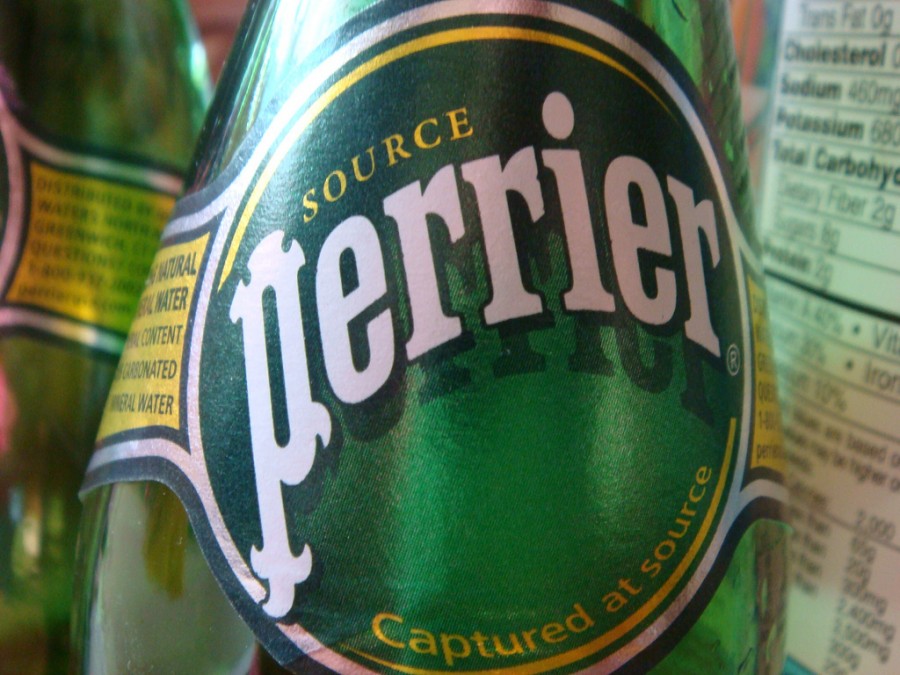
Today, I am in wonder of the world. In a good way.
I saw an article in a newspaper at work. I had to sit down a minute and really think about what it was that shook me. The headline read: “Paris Introduces Sparkling Water Fountains.” I then found a similar article in the Guardian.
My first reaction was, mmm, delicious. I like sparkling water because it is the salty, boring version of sweet sodas. My second thought was: why was I taken with this article? I read on. In France, the people drink a lot of the fizzy stuff. Perhaps it’s a cultural thing, but whatever it is, the waste produced from the consumption needed to be addressed (262,000 tons of plastic waste in 2009 alone).
Then, someone with half a brain knew that to address the problem, they needed to take the bottle away in a way without possibly sparking a revolution. So, to “wean” the people from their wasteful bottles, Eau de Paris (the city’s water supplier) injected carbon dioxide into a public water fountain, with the hopes to do the same to future fountains in an effort to do away with plastic. In Paris, the people know what they like and are proud of it.
In North America, we like bottled water: Perrier, San Pelligrino, carbonated, mineral, Smart, Vitamin, etc . . . We have a lot to choose from for many reasons. The options are wonderful to think about; the plastic waste, not so much.
By Brit Weaver

About the Author

Toronto born and based, Brit is an avid leisure cyclist, coffee drinker and under-a-tree park-ist. She often finds herself meandering foreign cities looking for street eats to nibble, trees to climb, a patch of grass to sit on, or a small bookstore to sift through. You can find her musing life on her personal blog, TheBubblesAreDead.wordpress.com.
The post Let Them Drink Sparkling Water! appeared first on The Expeditioner Travel Site.
]]>The post Appreciating A Quieter Paris In August appeared first on The Expeditioner Travel Site.
]]>
If you love Paris but despise the crowds, then August may be the perfect time to travel to The City of Light. Yes, it’s true that many restaurants, businesses, and cafés shut down during this month, but with half of Parisians leaving the city for annual vacations, you may just enjoy the extra leg room. “In August, a sense of serenity settles over the city,” recalls James Morgan in the recent National Geographic Traveler. Surprisingly, there is still much to see, eat, and admire in a quieter Paris, and you may even find that escaping the pressures of completing a “must-see” list is quite liberating.
Instead you can appreciate the city with a simpler, more Parisian saunter, enjoying the many parks, Sunday museums, flea markets, and breezy cafés. Morgan advises — as is usually always a good bet — venturing off the tourist track, suggesting a stop at the Pére Lachaise cemetery where visitors should avoid the crowded resting place of Jim Morrison, purchase a map for two euro, and search for other “evocative antiques” like, Honoré de Balzac, Frédéric Chopic, Eugéne Delacroix, Georges Bizet, Sarah Bernhardt, and Colette.
If one opts for a cruise up the Marne and Seine, Morgan recommends grabbing lunch at a guinguette, or French “eating-drinking-dancing joint,” hotspots for many free-spirited Parisians during the 18th century to the 1950’s. Located just east of Paris in the town of Marne, the guinguettes were an inexpensive (they were exempt from the city’s liquor tax) way for the working class to wind down on Sunday afternoons.
And if you can’t make it to Côte ? Azur? Why not drop by the annual Paris Plages, which transforms the landlocked edges of the Seine River to an enchanting beachfront, complete with sand, palm trees, pétanque courts, and cafés. The allure of Paris in August can also be admired at the Jardin de Bagatelle for its world-renowned rose competition. The competition is held in June, but the blooming beds are left to thrive in peaceful gardens to inspire and delight all who venture to this botanical gem.
To really experience Paris, Morgan urges travelers to visit one of its many parks. He tempts people to pick a spot and daydream, letting the time pass, as it may, and reflect on the sounds, faces and scents that drift by. The sight of “children sailing small wooden boats around the ponds in the Tuileries garden” may be the perfect ending to a Parisian reverie on a lazy afternoon in August.
By Maria Russo

About the Author
 Maria Russo is a freelance writer who loves natural wonders, good eats, ethical travel, and boutique hotels. Her work has appeared on the Huffington Post, USA Today.com, People.com and A Luxury Travel Blog, among others.
Maria Russo is a freelance writer who loves natural wonders, good eats, ethical travel, and boutique hotels. Her work has appeared on the Huffington Post, USA Today.com, People.com and A Luxury Travel Blog, among others.
When Maria is not writing for her all-time favorite site (that would be The Expeditioner), she spends her time blogging about foreign jaunts and delectable food experiences for her site: Memoirs of a Travel & Food Addict. She is also up to no good on Twitter (@traveladdictgrl, @expedmaria).
The post Appreciating A Quieter Paris In August appeared first on The Expeditioner Travel Site.
]]>The post Your Guide To Paris’s Underground appeared first on The Expeditioner Travel Site.
]]>
A trip through the shadows of the City of Light
By Anthony Cuthbertson
The surface of Paris resembles that of an iceberg peaking its tip above the surface of the water. Beneath, there lies one of the most extensive and complex underground networks in the world. Alongside almost 300 metro stations and their interlinking tunnels weave a web of sewers, abandoned quarries, catacombs, canals and utility lines. The denser the population has become above ground, the deeper they have burrowed to sustain it. Without this vast infrastructure the city would cease to function, utterly paralyzed.
Since moving to Paris I had come close to exhausting every tourist trail and “gem” that the guidebooks had to offer. So one weekend I decided to heed the advice of some locals that I had met, who suggested that I took a look at the other side of Paris. They advised that I take a “troglodyte tour” of their city, to explore the often overlooked underbelly of Paris.
But where to start? Almost 150 miles of underground train track knit between at least 185 miles of catacomb tunnels and over 1300 miles of sewers, all right under the center of the city. That infernal underground maze, as Gaston Leroux calls it in Phantom of the Opera, stretches down as deep as 112 feet in places, ten stories below the surface. It is the result of 800 years of digging. The buildings, bridges and monuments that now sit on the surface are built from the limestone and gypsum that was excavated from the quarries and tunnels below.
The Catacombs
I had been putting off visiting the catacombs since arriving in Paris six months previously, so I decided to start there. I had been skeptical of what enjoyment could be taken from visiting one of the largest mass graves on earth. Deep within the bowels of the city are the bones of more than six million Parisians, the result of overcrowded cemeteries at the end of the eighteenth century. Due to the smell and spread of disease, the overflowing cemeteries spilled their less important clientele into the caverns and old limestone quarries underneath Paris, forming what are now known as the catacombs.
 Spiraling down the 130 steps from the entrance — an unassuming doorway in the 14th arrondissement — I entered a dimly lit gallery that led onto a long tunnel. I made my way through, crunching over wet gravel and ducking my head to avoid scraping it on the dripping ceiling, until I reached two pillars that marked the entry to the ossuary. The words “Arrête, c’est ici l’empire de la Mort” (“Stop, this is the empire of the dead”) were inscribed in the stone above.
Spiraling down the 130 steps from the entrance — an unassuming doorway in the 14th arrondissement — I entered a dimly lit gallery that led onto a long tunnel. I made my way through, crunching over wet gravel and ducking my head to avoid scraping it on the dripping ceiling, until I reached two pillars that marked the entry to the ossuary. The words “Arrête, c’est ici l’empire de la Mort” (“Stop, this is the empire of the dead”) were inscribed in the stone above.
For the next mile or so, I followed the tunnels as they wound their way under Paris. Every wall is packed to the ceiling and stacked 10 feet deep with skeletons. The anonymous bones of long forgotten people, placed without prejudice. The skulls of servants atop those of their masters, revolutionaries side by side with aristocrats, have been arranged into macabre compositions for the hoards of morbid tourists to photograph, poke at or even pocket.
As I resurfaced to the bright sunshine above, my bag was searched by a security guard. Looking behind him I saw two boxes filled with about half a dozen skulls and various fibulas and femurs. When I asked if that those were all of the souvenirs that people had tried to take in the past he said, “No, that is just today”.
The Metro
What could be called Paris’s most visited attraction, with more than 1 billion patrons each year, the Paris metro was next on my list to explore. Having only seen it as a functional necessity for getting about, I had not thought of it as a tourist attraction until discovering that there was a guided tour run by ADEMAS (Association D’Exploitation du Matériel Sprague). Meeting outside a metro entrance at Châtelet, the guide took me on a three-hour tour of the metro, explaining the history of the system, the Art Nouveau design of the stations, and culminating in a visit to a “ghost station.”
There are four ghost stations under Paris. They are stations that are still in existence, though no longer functioning having closed down during World War II and never reopening. They remain intact, though the only visitors now are tour groups, vandals and the homeless. The tour takes you to St. Martin, an old station in the 3rd arrondissement. Every wall and ceiling is covered in graffiti, though old pre-war adverts tiled onto the walls remain, offering long-forgotten products.
The Sewers
Away from the tour, but still in the metro, I headed to the sewers, through the same train tunnels that the Nazis used to flee Paris at the end of the War. I was told that just across the bridge from the station Alma-Marceau, I could enter the sewers, where peculiarly Paris has its own sewer museum. In fact, the sewers — seen upon their completion as a  magnificent feat of engineering — have been a tourist attraction since not long after the modern network was created in 1850. Originally, carts suspended under walkways carried the curious visitor, followed by boats up until 1975. Now it is metal grate walkways that you walk along, allowing you to see all that passes underneath your feet through the murky rivers.
magnificent feat of engineering — have been a tourist attraction since not long after the modern network was created in 1850. Originally, carts suspended under walkways carried the curious visitor, followed by boats up until 1975. Now it is metal grate walkways that you walk along, allowing you to see all that passes underneath your feet through the murky rivers.
Each street, boulevard and alley has its equivalent underground waterway, signposted at each end just as they are on the surface. The sewers were damp, dark and noisy, though I was surprised at how quickly I became accustomed to the smell. It is a fully operating part of the sewer so there is a lot of waste to be seen and I was told to avoid touching the walls.
I took the self-guided tour along the 500 yards of walkways, and while other tourists were marveling at the engineering, the machines and tools used to clear the waste, I found myself intrigued by the history. As with the tunnels of the catacombs, the Paris sewers were used by revolutionaries and French resistance and have been the setting for secret meetings, great escapes and novels.
* * *
Underneath Paris is a place unchanged in centuries, a place where the dead outnumber the living on the surface three-fold. It is a historical imprint that cannot be bulldozed or knocked down, as any change to this labyrinth could result in catastrophic cave-ins and buildings to collapse on the surface.
The walls and ceilings of the caverns and tunnels reflect this history, with graffiti and engravings — some centuries old — reflecting the thoughts and actions of the cross-section of those people underground. The tunnels tell the stories of everyone from sewer workers and diggers, to revolutionaries and French resistance. And as I snaked my way back home on the metro, I stared out of the window of the carriage into the darkness, imagining what lay just beyond the tunnel walls.

The post Your Guide To Paris’s Underground appeared first on The Expeditioner Travel Site.
]]>The post Video: This Is The Way To Experience Paris appeared first on The Expeditioner Travel Site.
]]>With over 29 million visitors a year, Paris is the most visited city in the world. With that number of visitors, truly it must be impossible to find your own little nook of the city where you can blend in and experience the city like a local. Right?
Cue The Frugal Traveler, circa summer ’08, who, in the above video, decided the best way to see the city was to shack up in a rented apartment in the 10th Arrondissement he found on one of the rental sites, VivaStreet.fr and pap.fr (it’s not clear which one gave him the the most luck).
A block to the east was the Rue du Faubourg du Temple, “an immigrant entrepreneurial zone where halal butchers hacked lamb shanks and West African restaurants were almost indistinguishable from the traditional French brasseries next door.” To the west was the Canal St.-Martin and the waterside cafes and shops exuding a youthful, artistic vibe.
At 2:48 Matt hits up Librairie Ulysse, the oldest travel bookstore in the world, where he picks up a copy of Nicholas Bouvier’s “The Way of the World,” a book the owner describes as “the best travel book ever.” Bold statement. I’m at least adding it to my Amazon wish list.
*Editor’s Note: I was this close to posting about a video by Rick Steves on Lisbon, but I just couldn’t bring myself to do it. In the interest of full disclosure, here’s a link to the video. It’s actually a pretty good clip. You just didn’t hear it from me.
The post Video: This Is The Way To Experience Paris appeared first on The Expeditioner Travel Site.
]]>The post Off The Beaten Path In Paris appeared first on The Expeditioner Travel Site.
]]>
Seeing Paris has always been a dream of mine, as for most anyone I have ever met. The idea of walking along the Seine, sipping coffee with croissants and divulging a bottle of delicious house wine over dinner is enough to make me book a flight tout de suite. I am working on my self-control.
Nonetheless, as a friend just informed me, tourists are pervasive in Paris. To me, tourism is part of what keeps a city financially afloat, yet, it is the underground paths and the off-beat tracks that keep a city alive.
For this reason, I was excited by the NY DailyNews’ look at the “other” Paris . It aims to describe the sights that most tourists don’t get to see, mainly due to the attraction to the more popular attractions like some tower called Eiffel, a gothic-cathedral and a rather large museum used for the set of a Dan Brown movie. This article suggests taking a different route and seeing the churches or regions outside the typical tourist manual.
Nevertheless, I forwarded this article to my friend and he said it was . . . well, he didn’t agree with it. His reasoning was that most of the attractions in the article are outside of Paris, one of which is 200 kms (124.3 miles) away. Although these sights would be interesting, he offered me a list of neighborhoods inside Paris that most tourists have yet to experience:
Butte aux Cailles, Canal Saint Martin, Place Sainte Marthe, Rue de Belleville, Oberkampf, Ménilmontant (rue Boyer), Château Rouge-rue de Montreuil, rue Royer Collard, rue Quincampoix, Parc Montsouris-cité universitaire, Parc Montceaux, Coulée verte, Parc de Belleville . . . (just to name a few.)
He told me there are other neighborhoods even more hidden that are worth a look, but the ones listed above are the more well-known hidden paths. I checked out these neighborhoods online and found lists of things to do and see. There is such a community of information that I can’t help but think: this is where the true pulse of Paris lies.
By Brit Weaver

About the Author

Toronto born and based, Brit is an avid leisure cyclist, coffee drinker and under-a-tree park-ist. She often finds herself meandering foreign cities looking for street eats to nibble, trees to climb, a patch of grass to sit on, or a small bookstore to sift through. You can find her musing life on her personal blog, TheBubblesAreDead.wordpress.com.
The post Off The Beaten Path In Paris appeared first on The Expeditioner Travel Site.
]]>